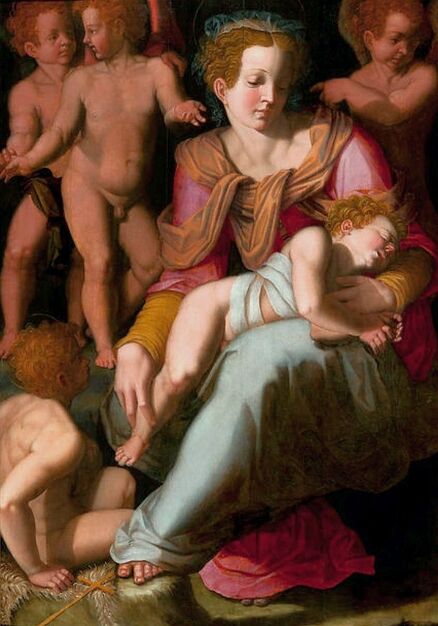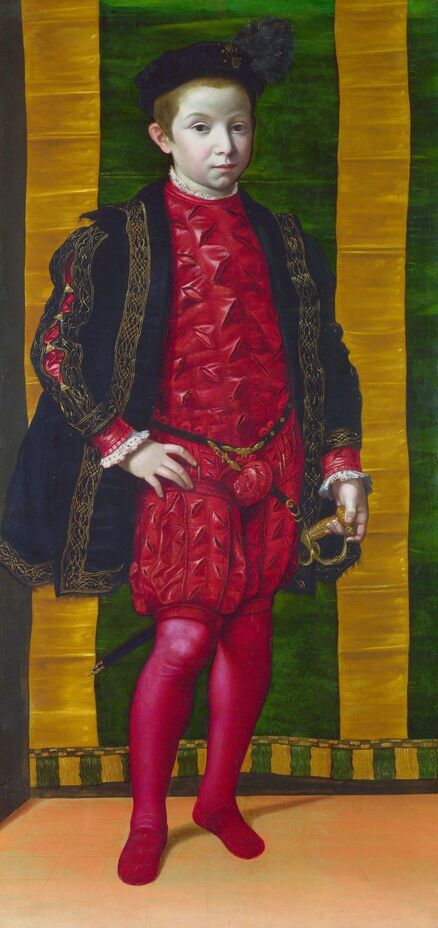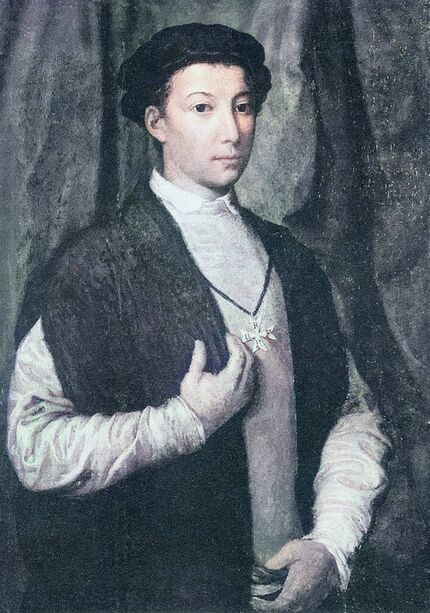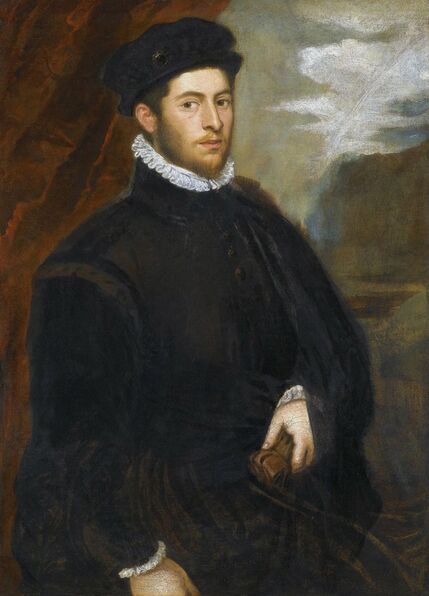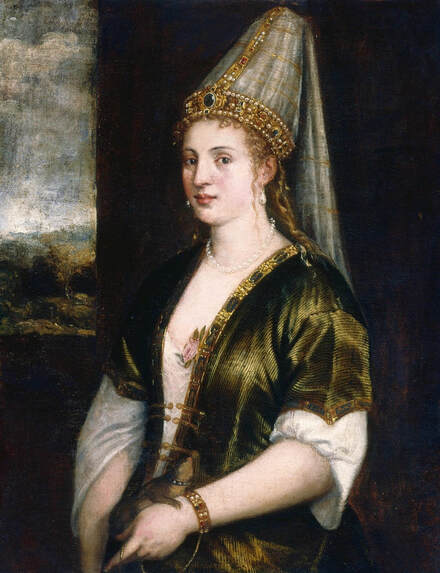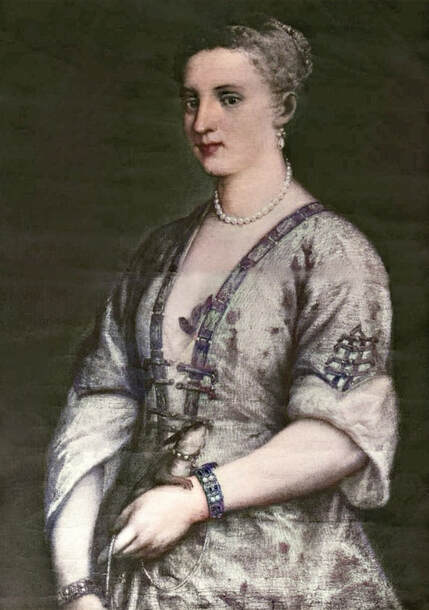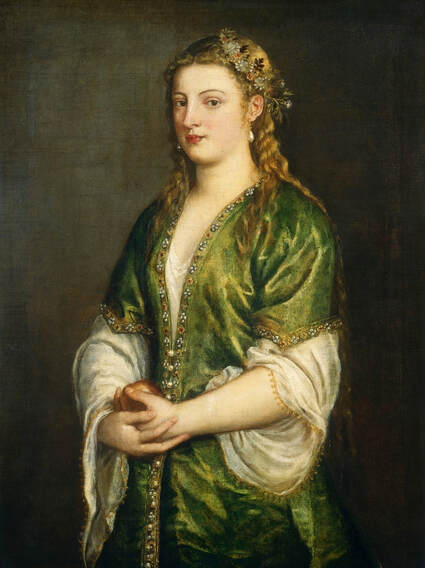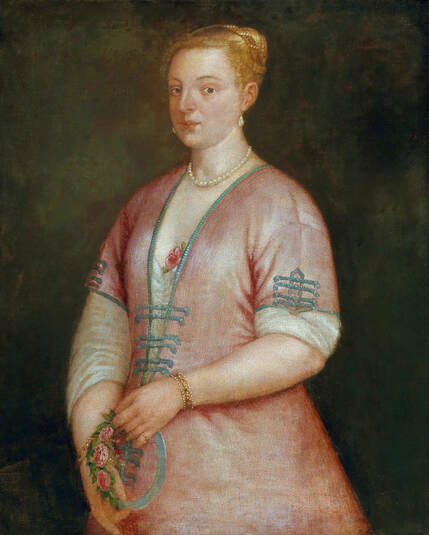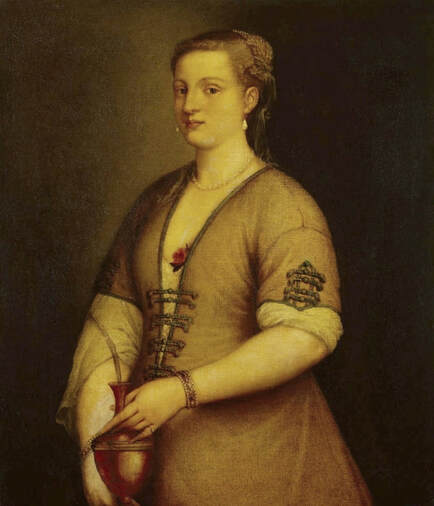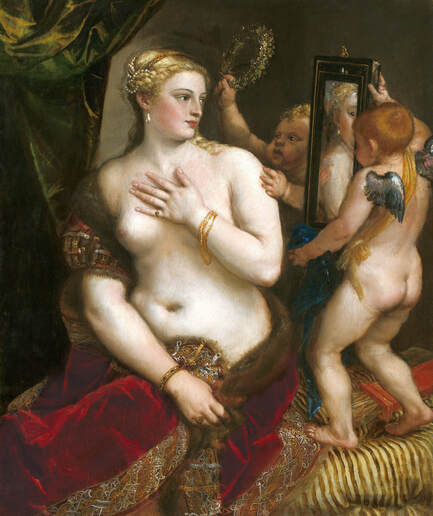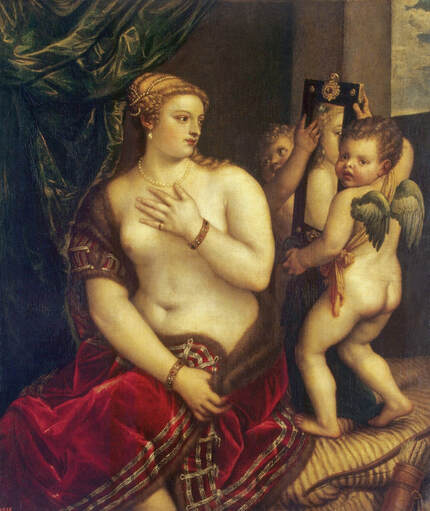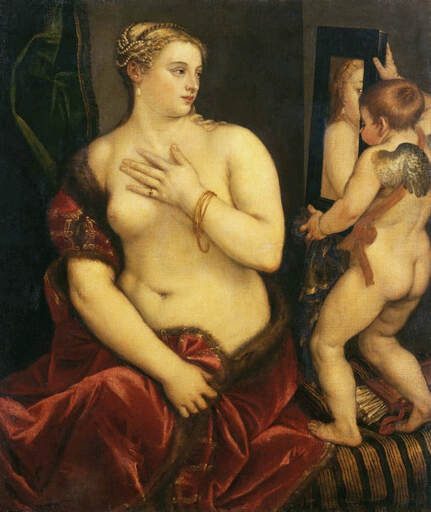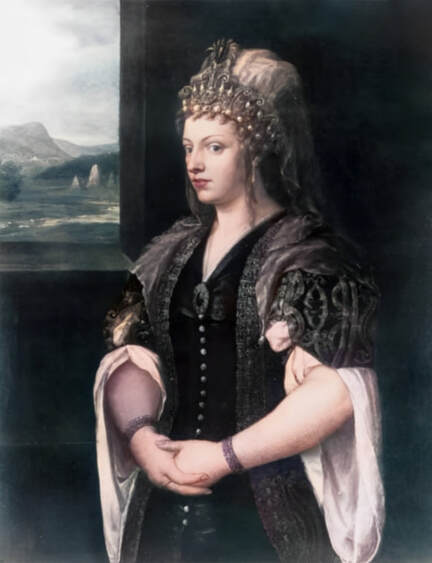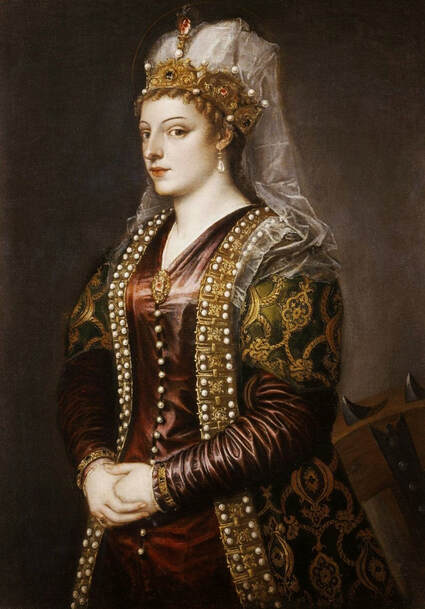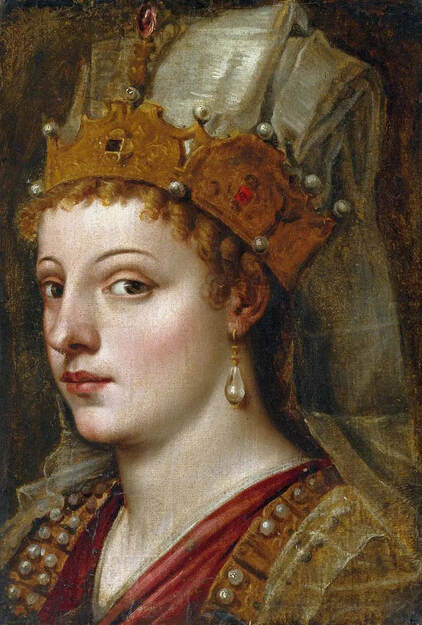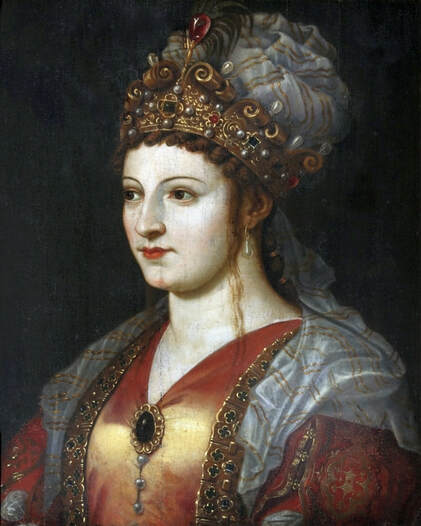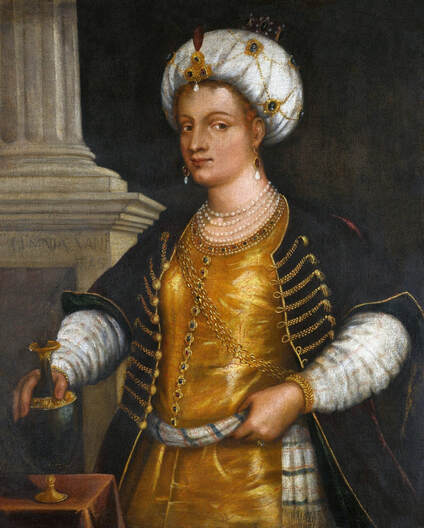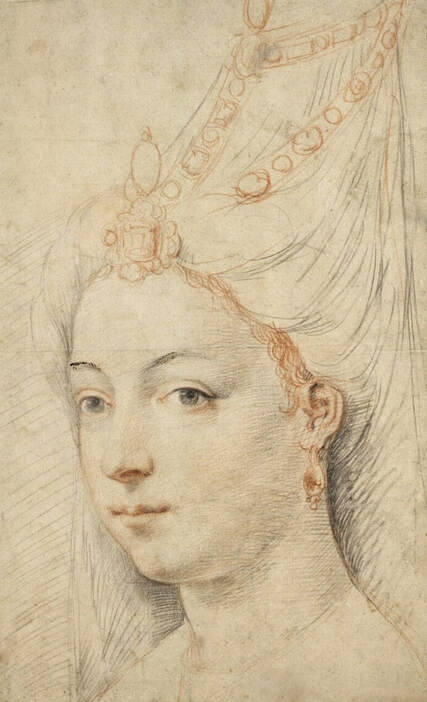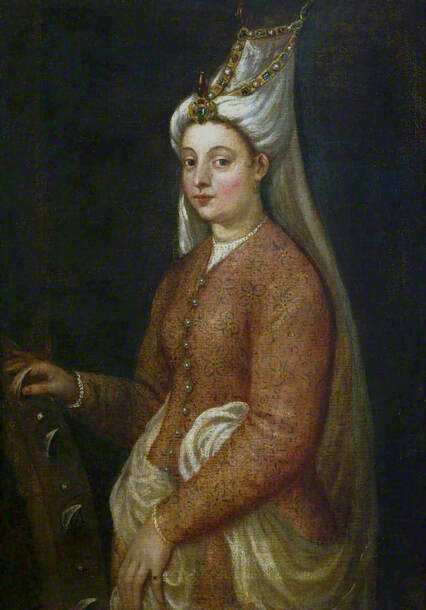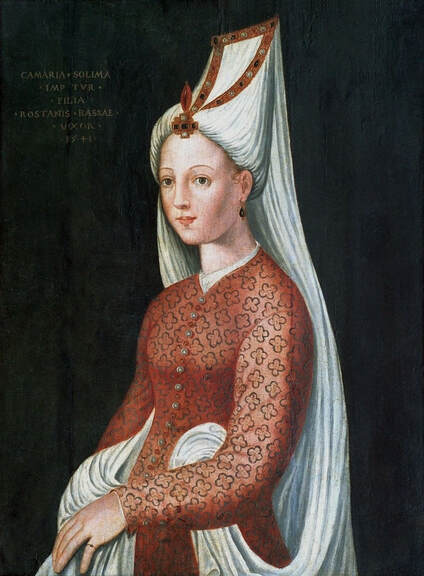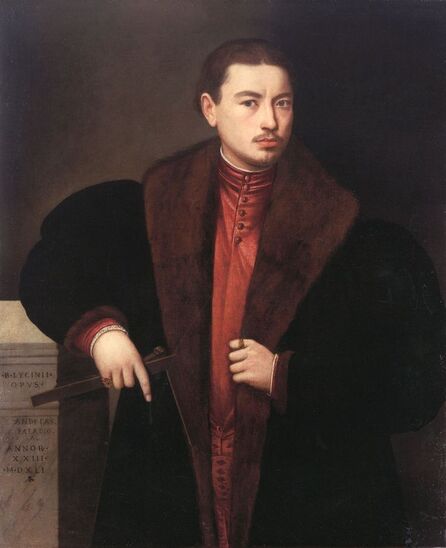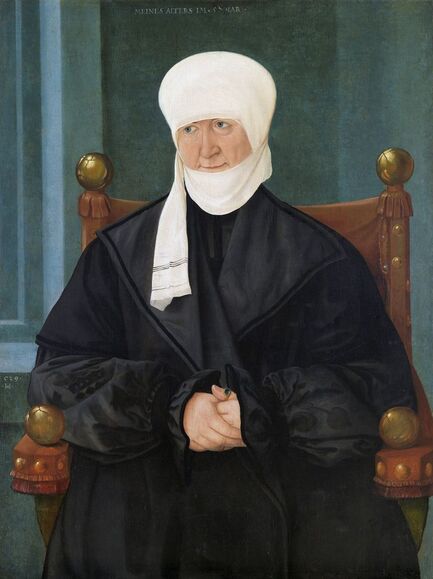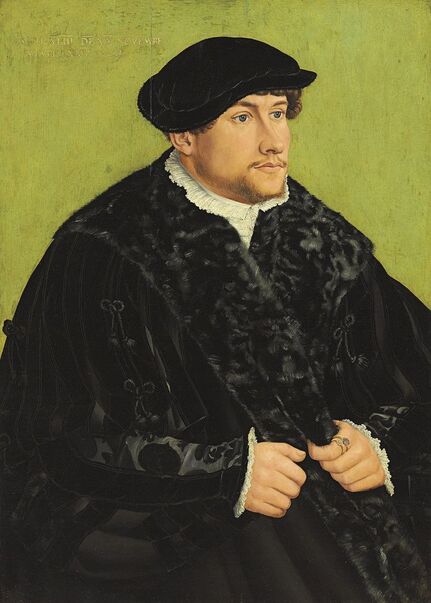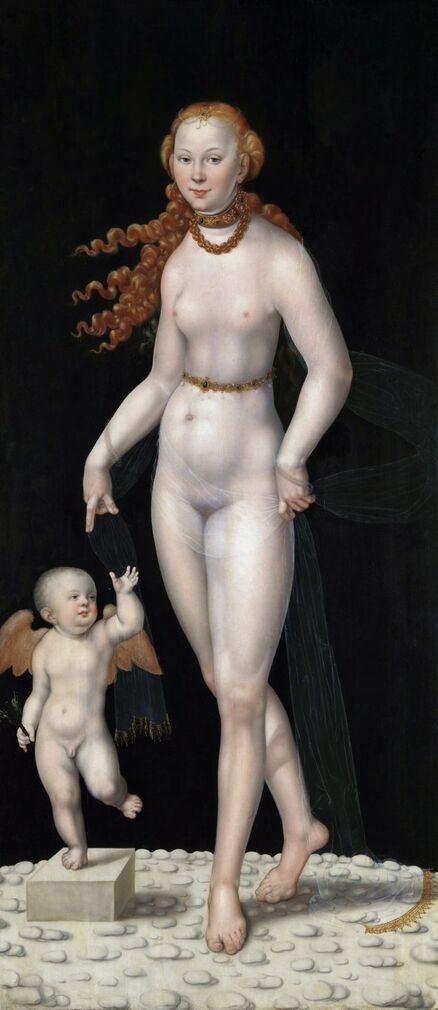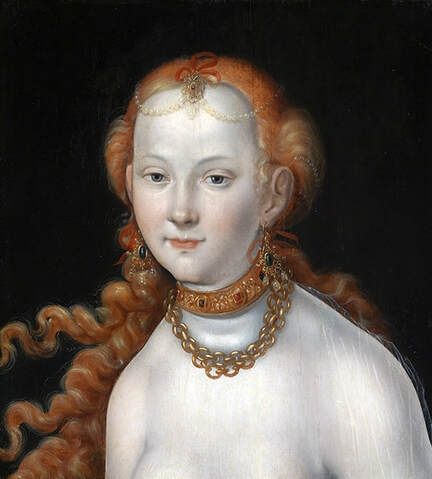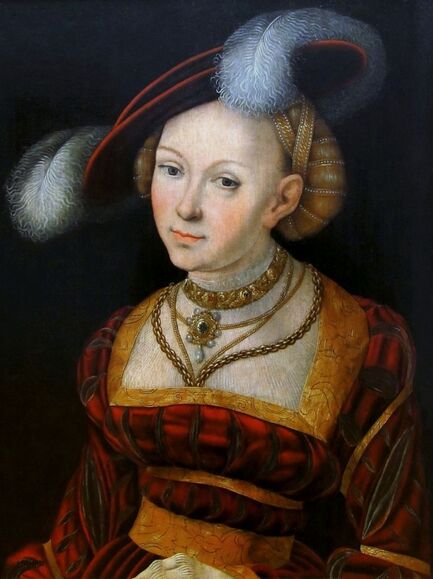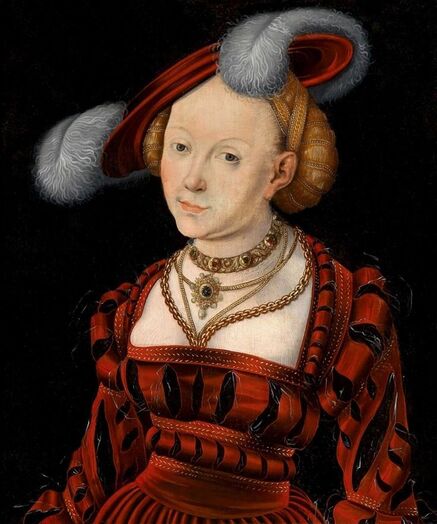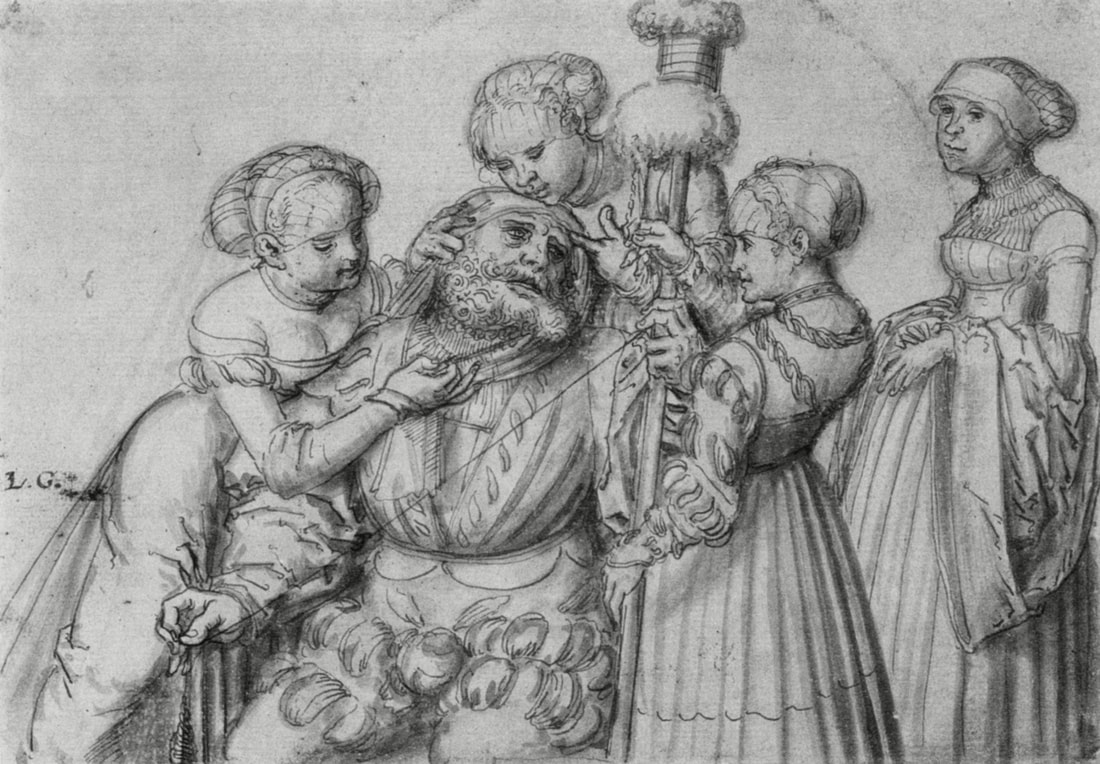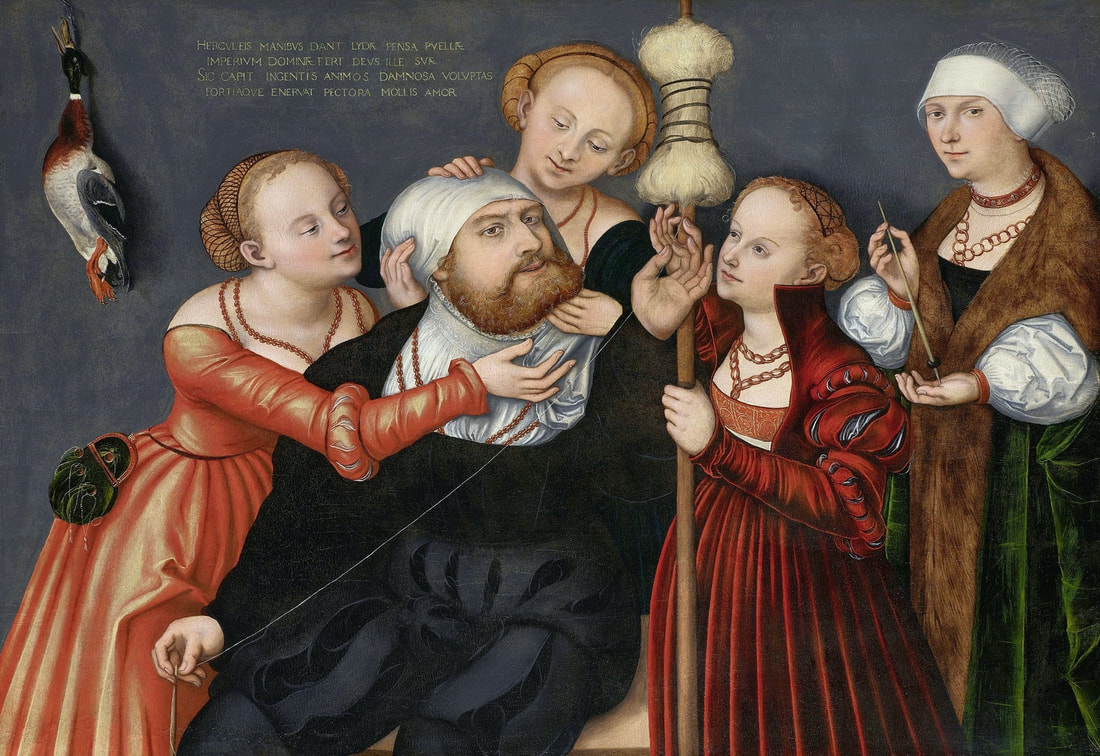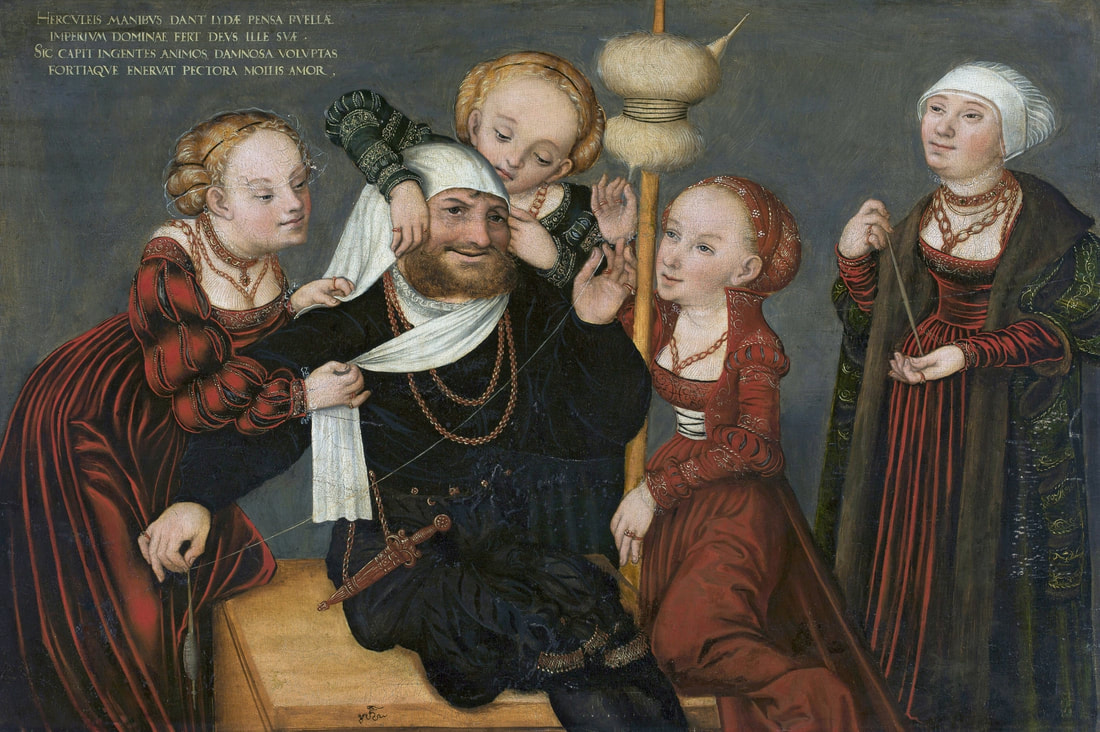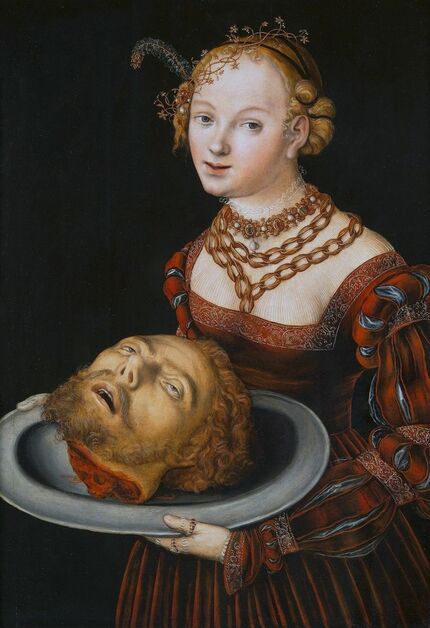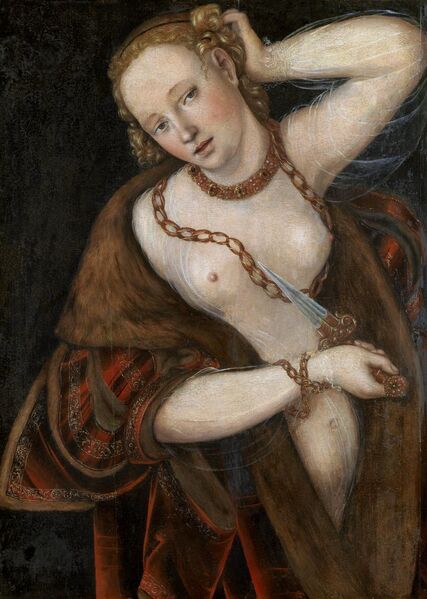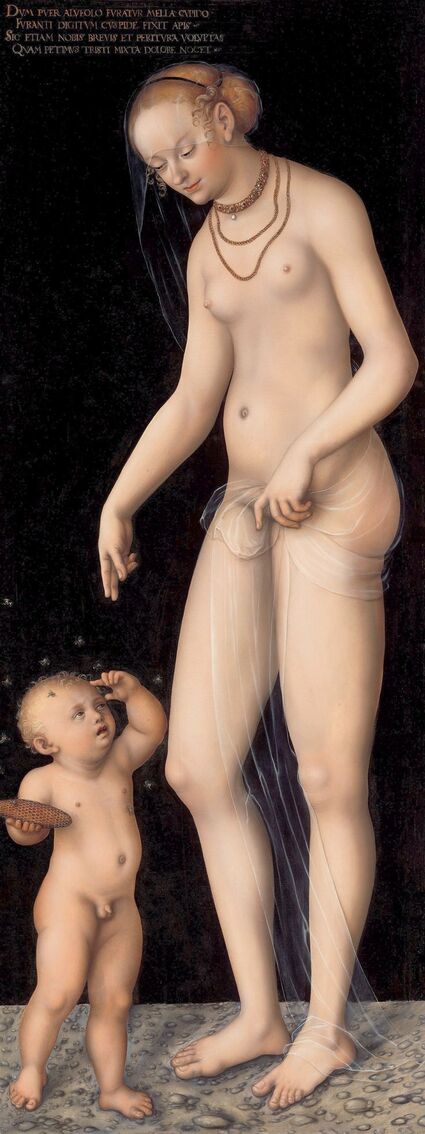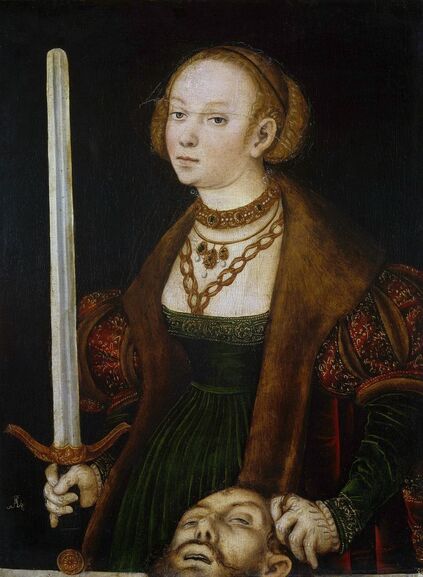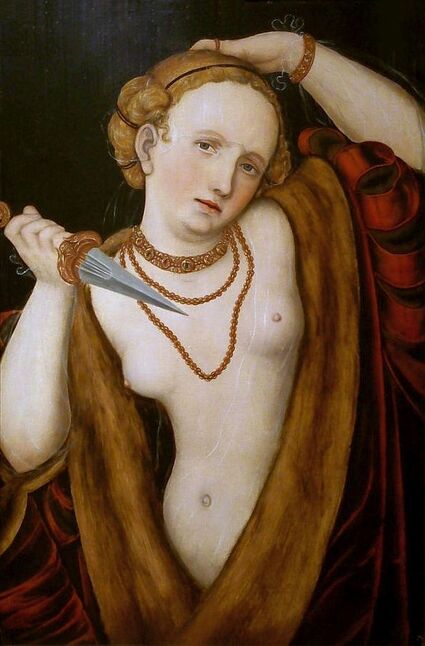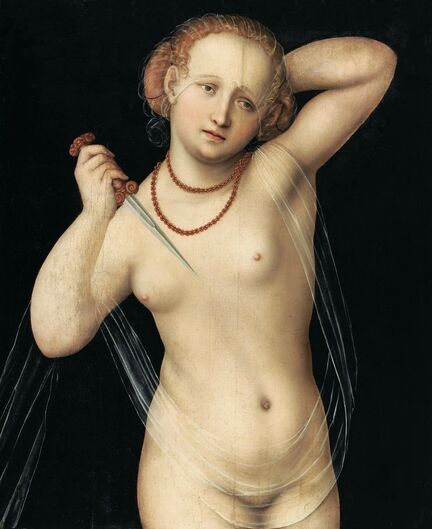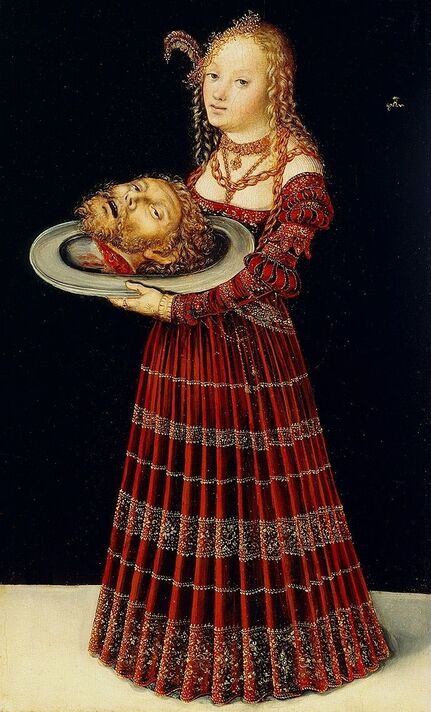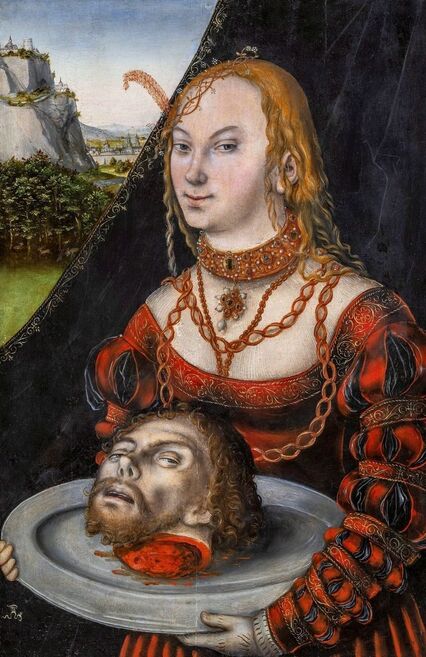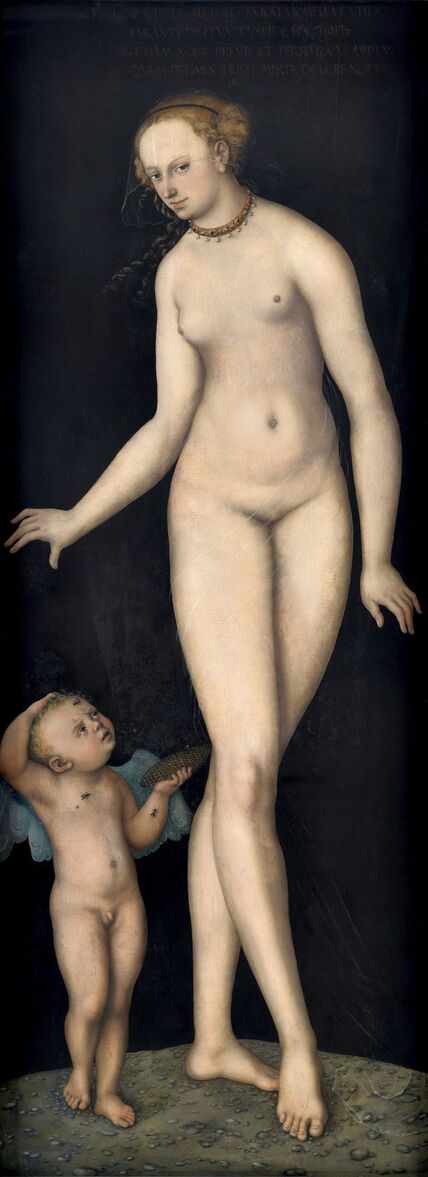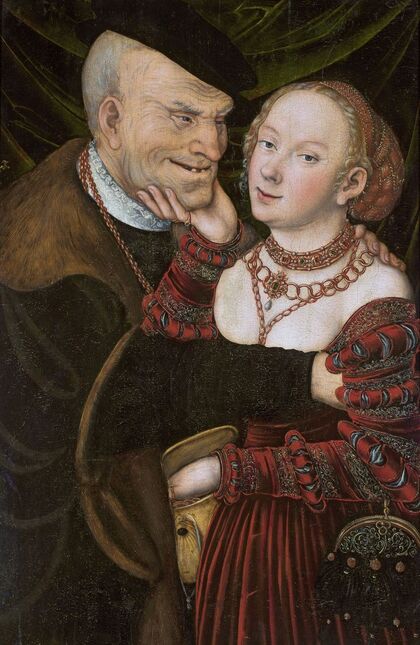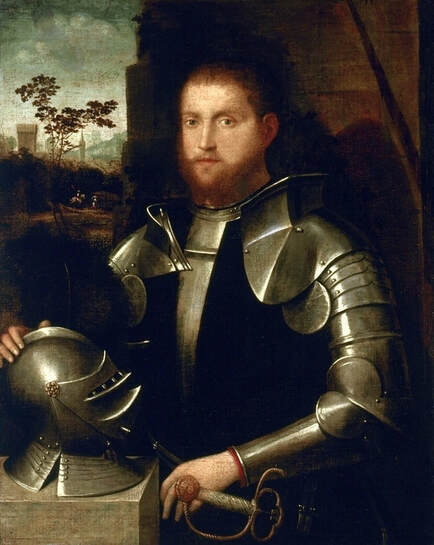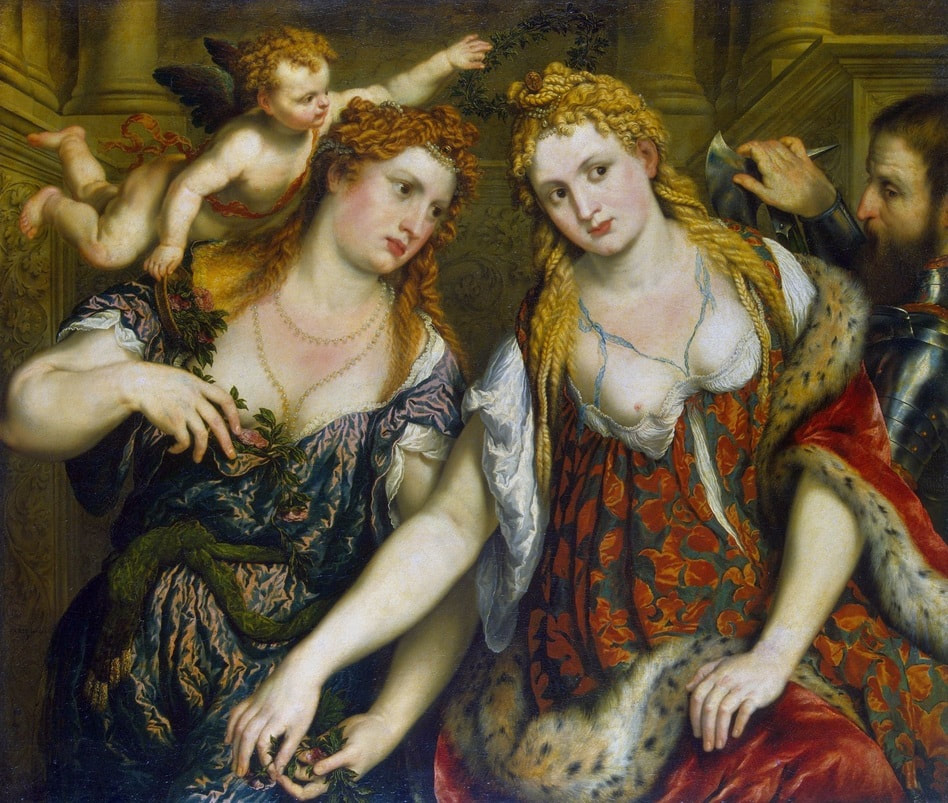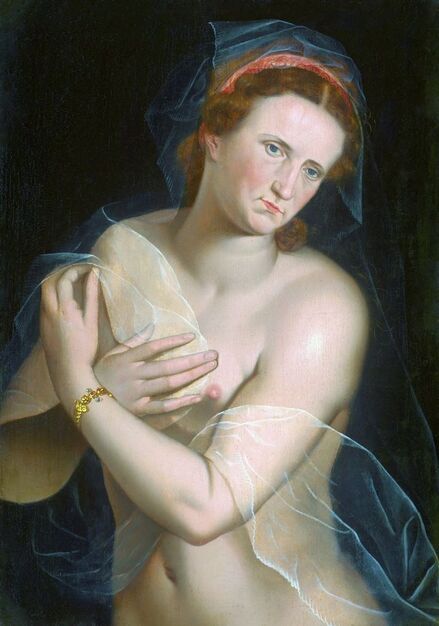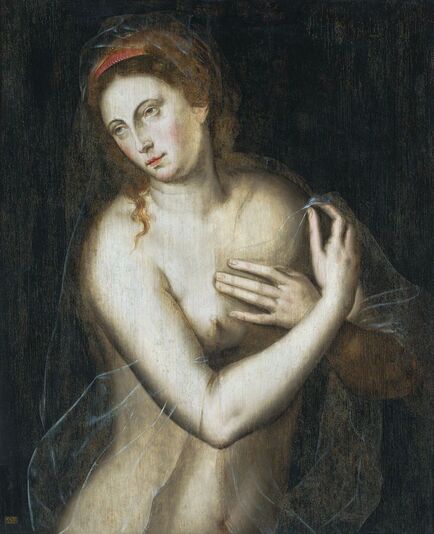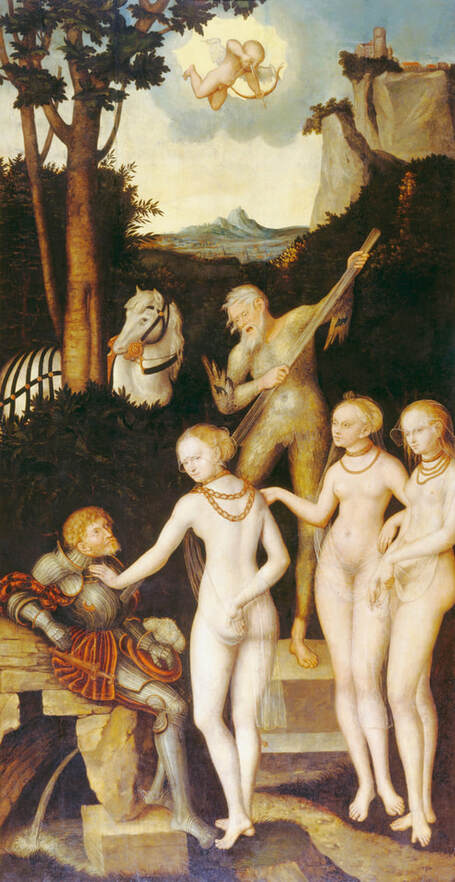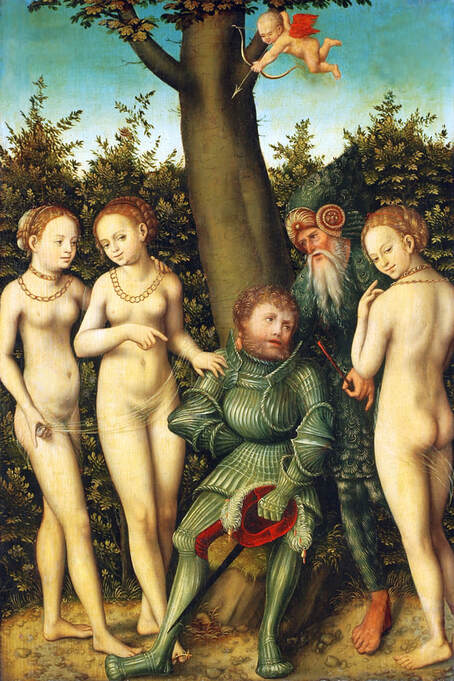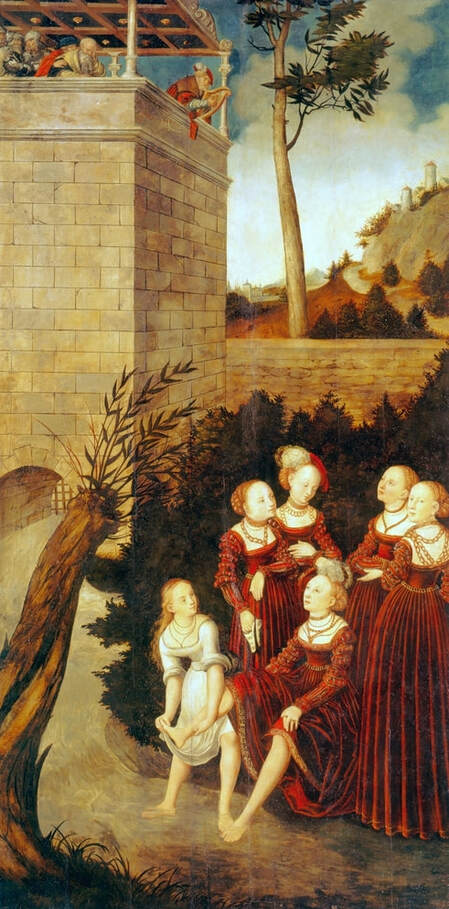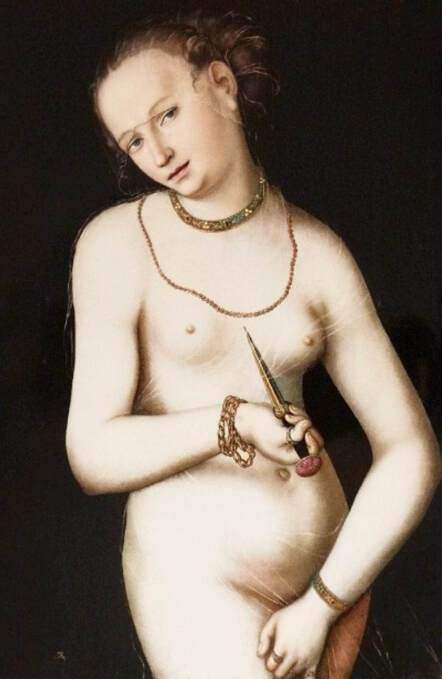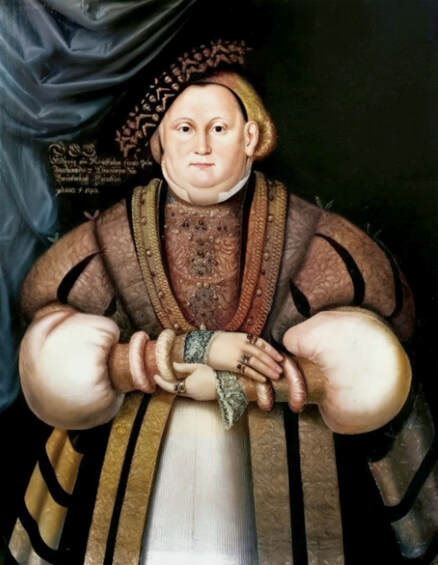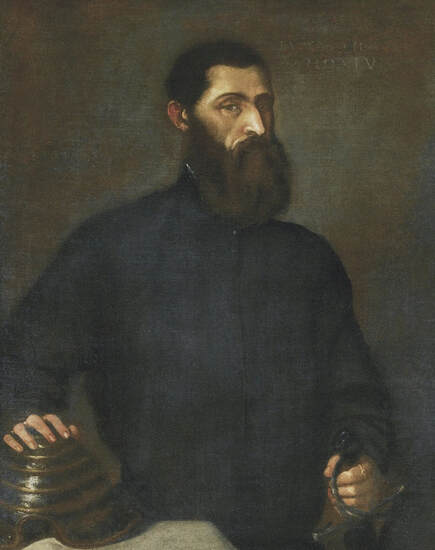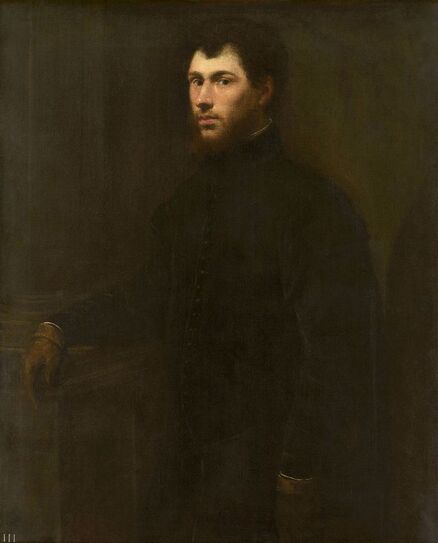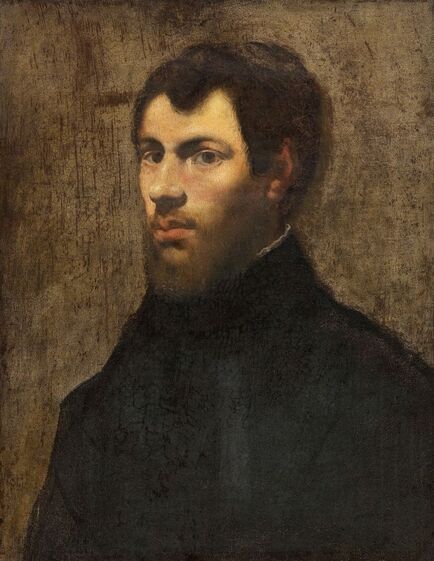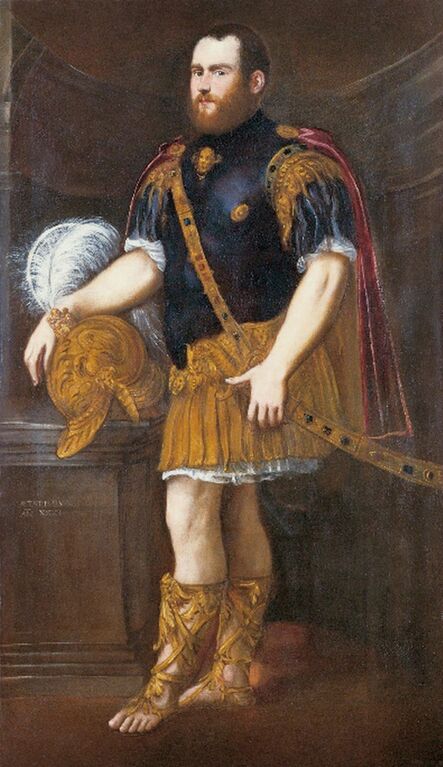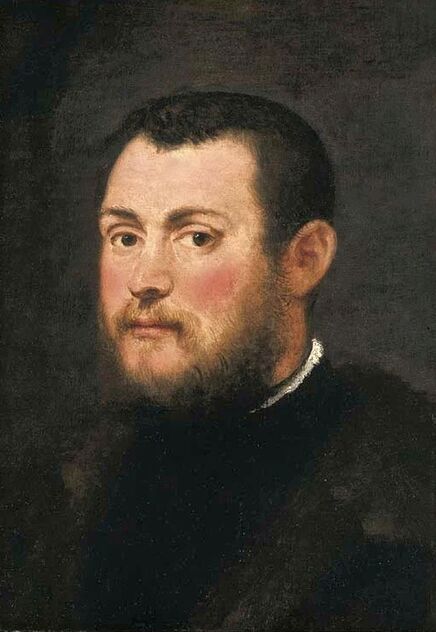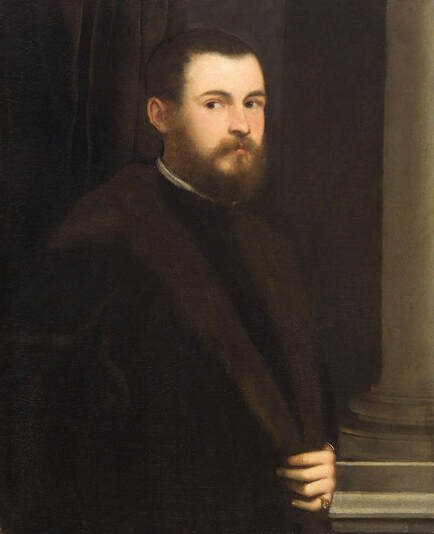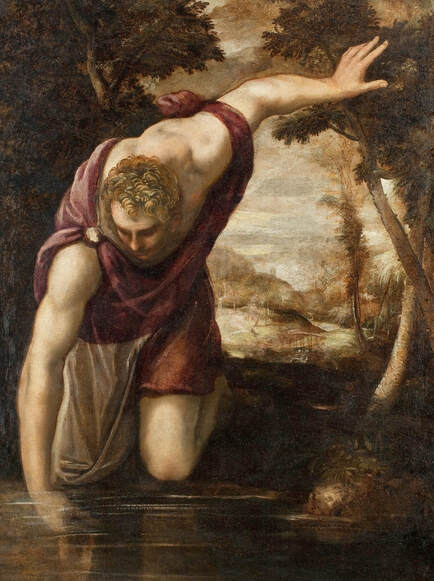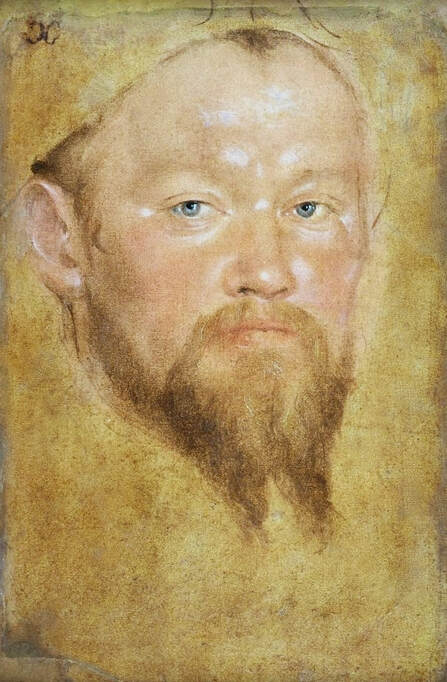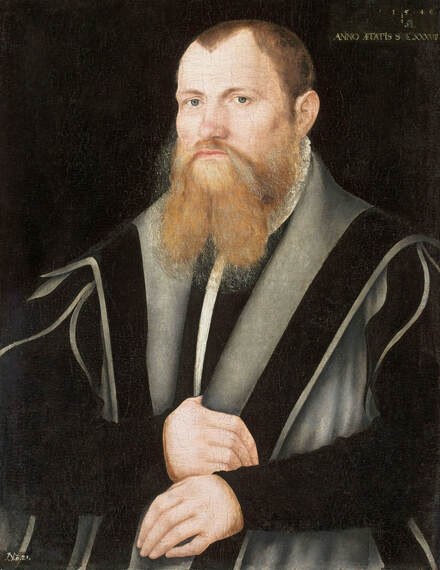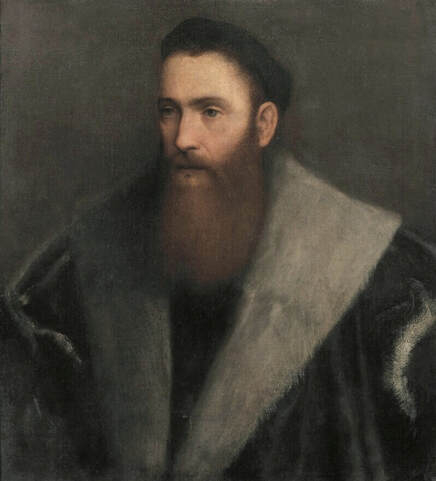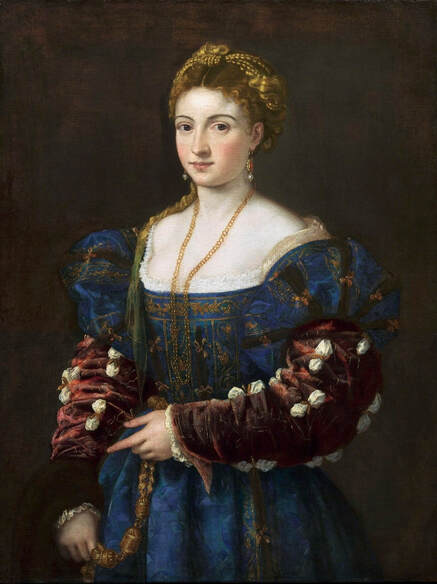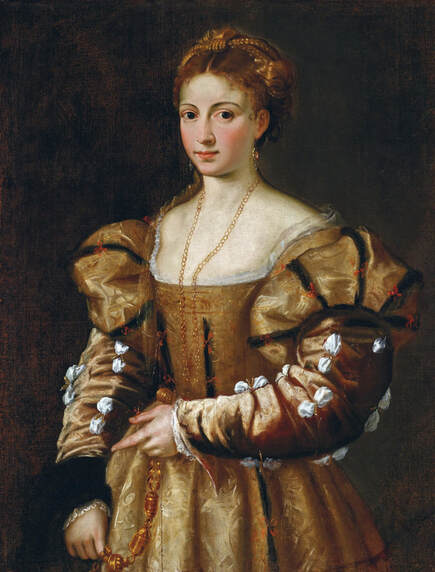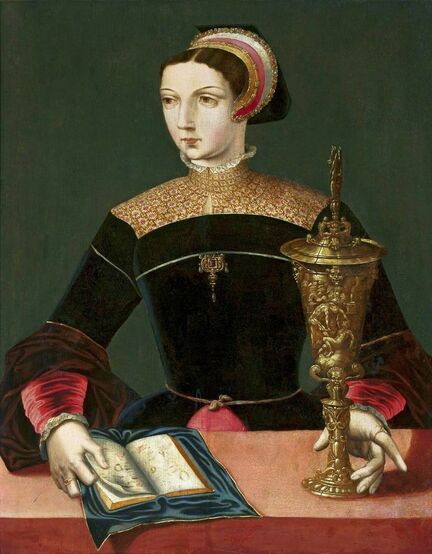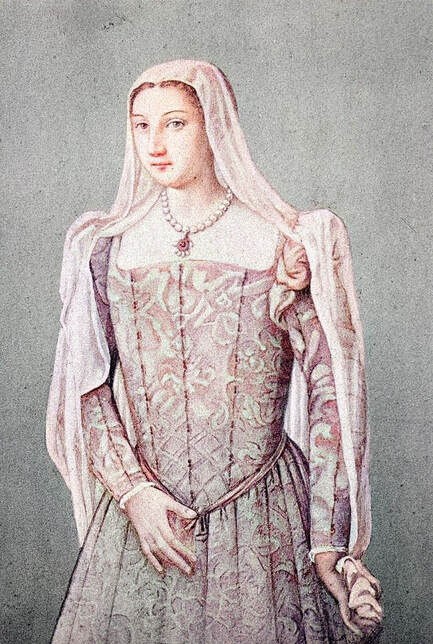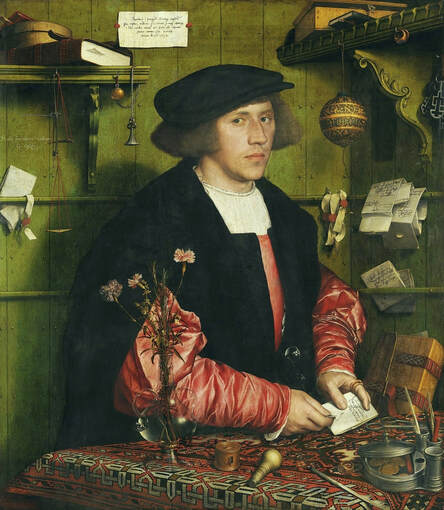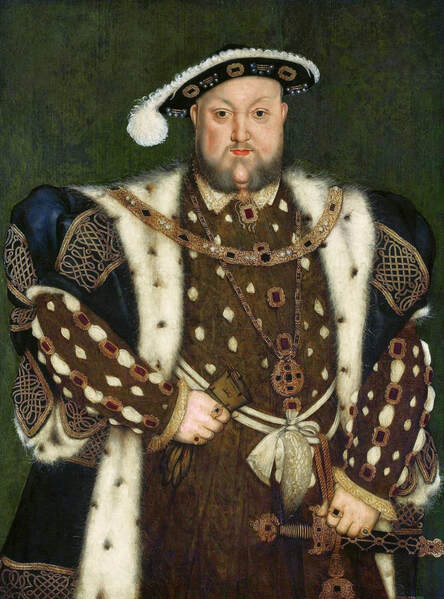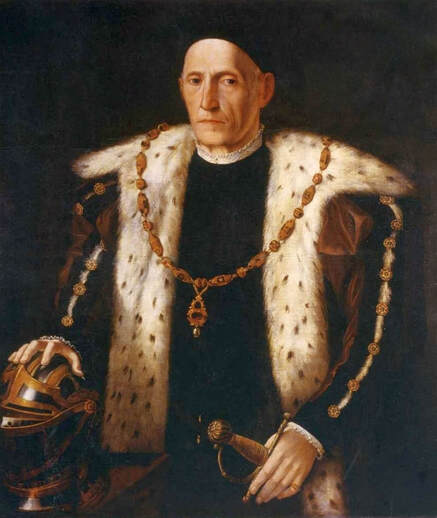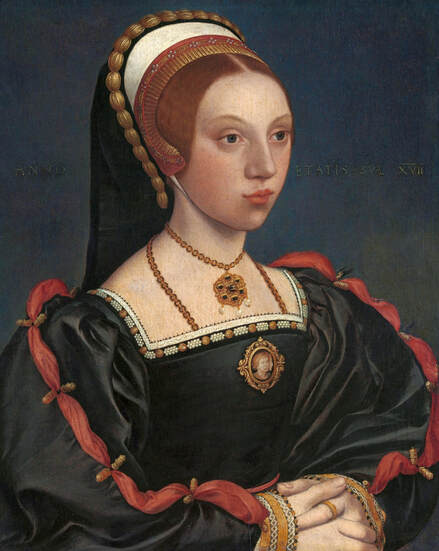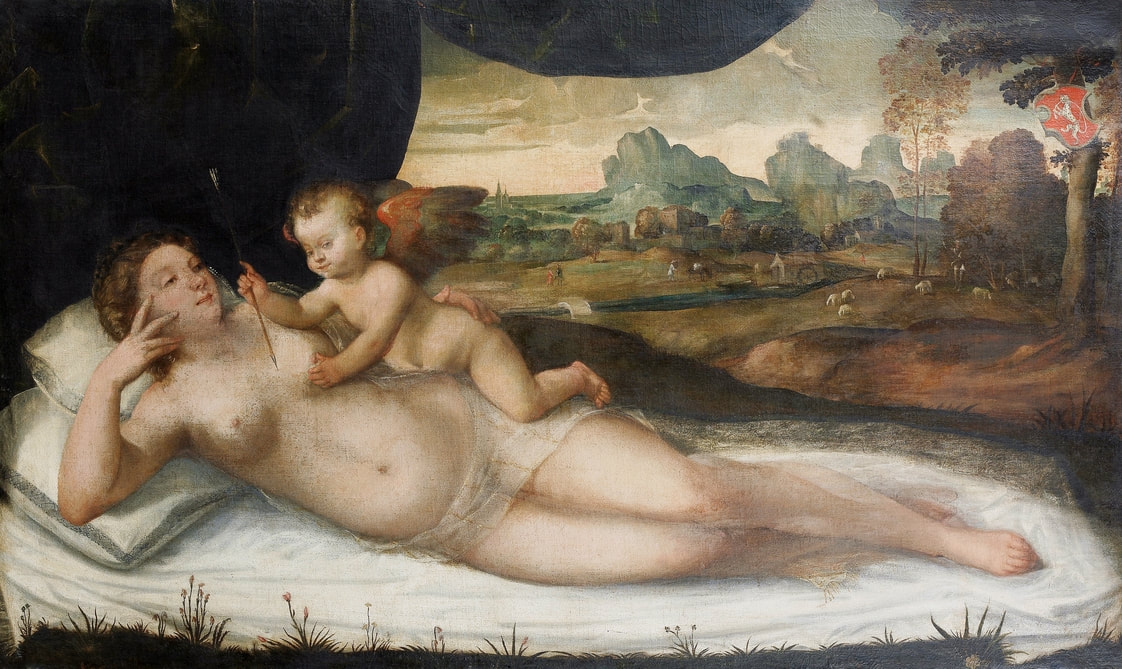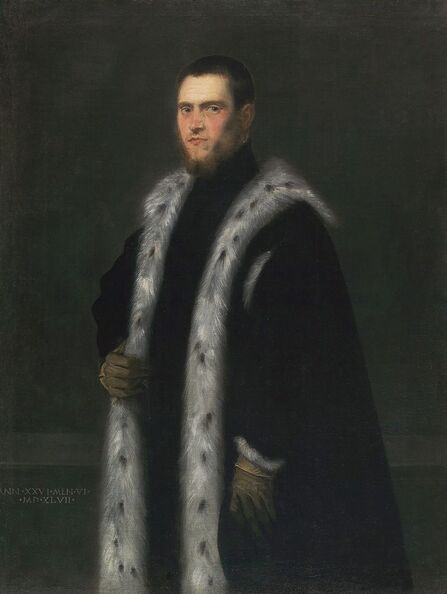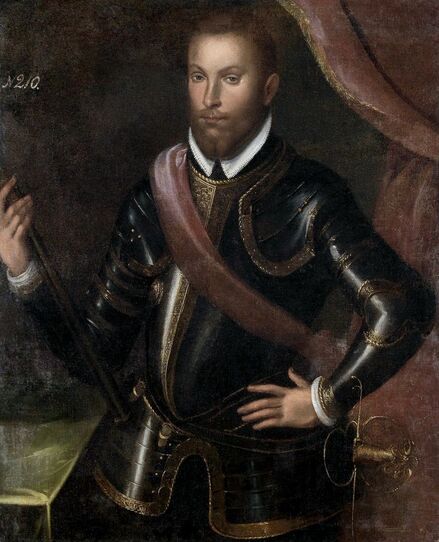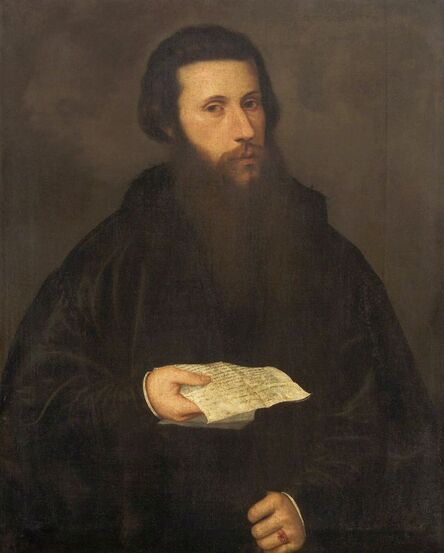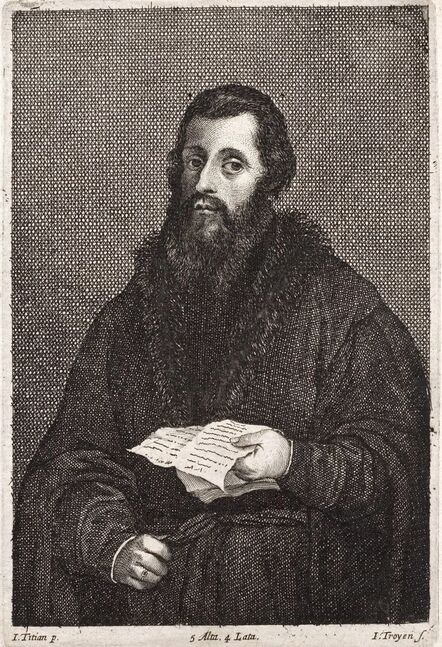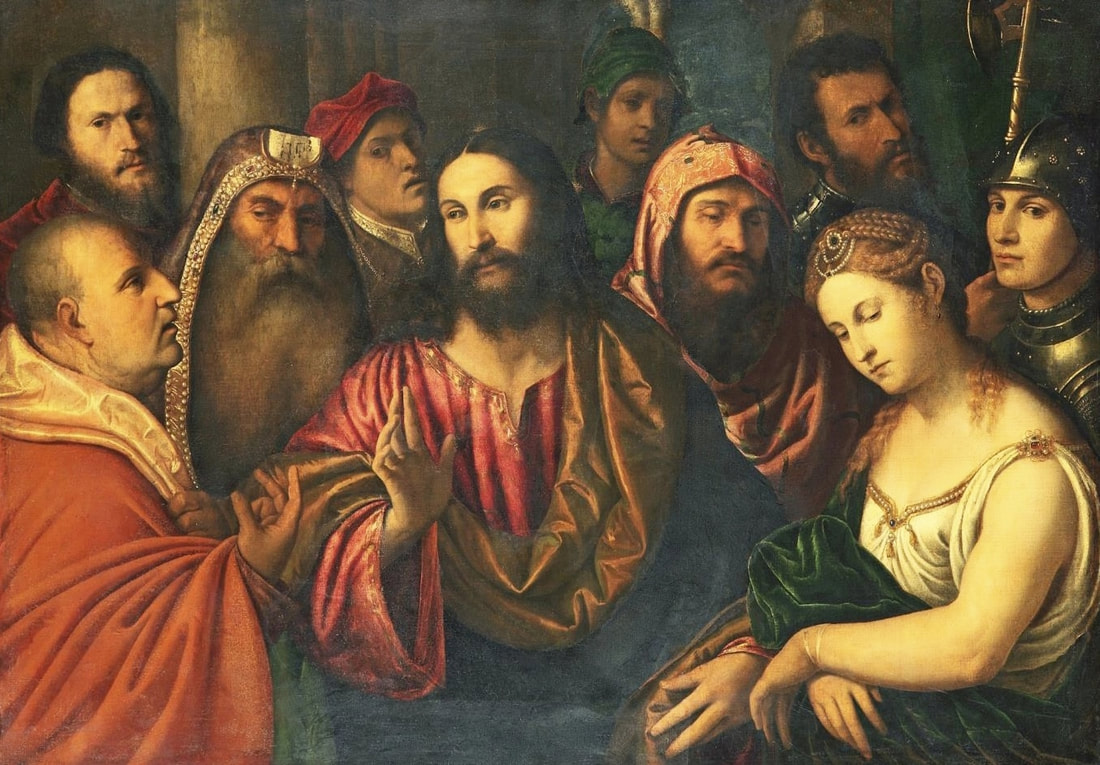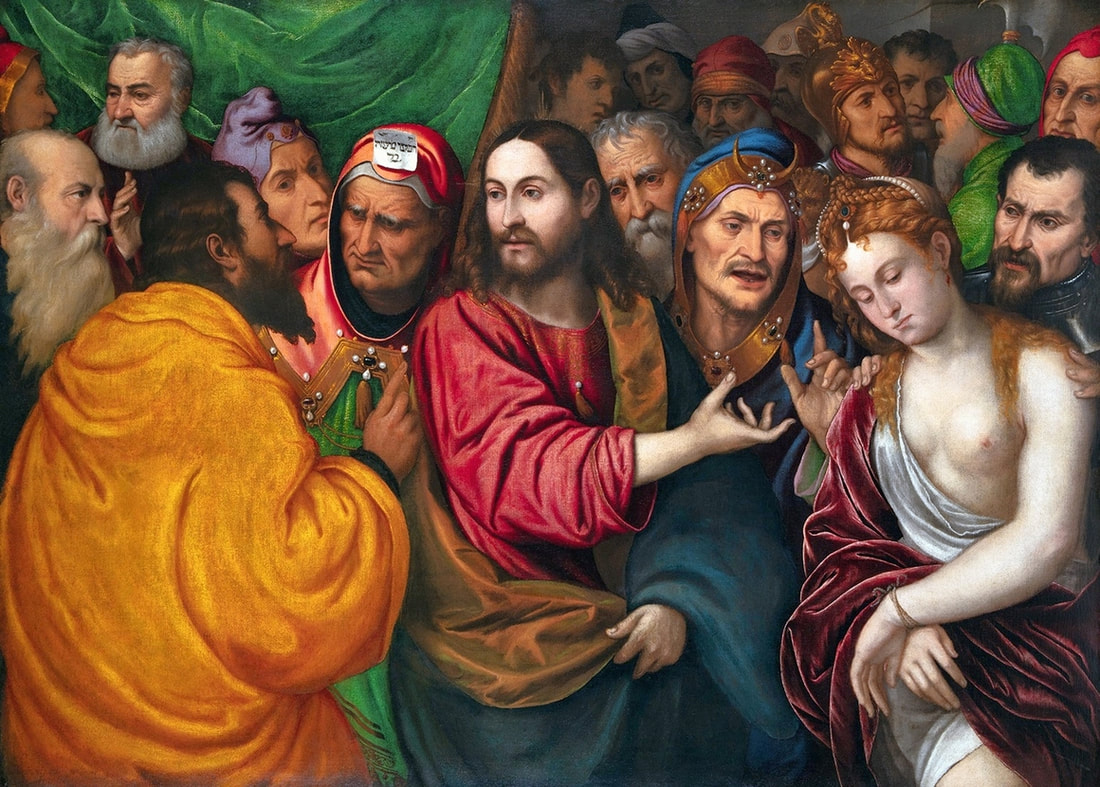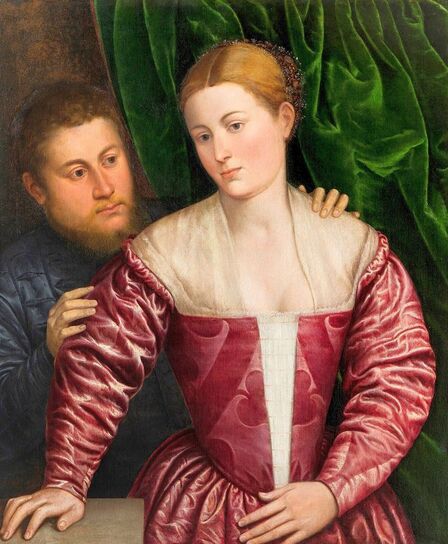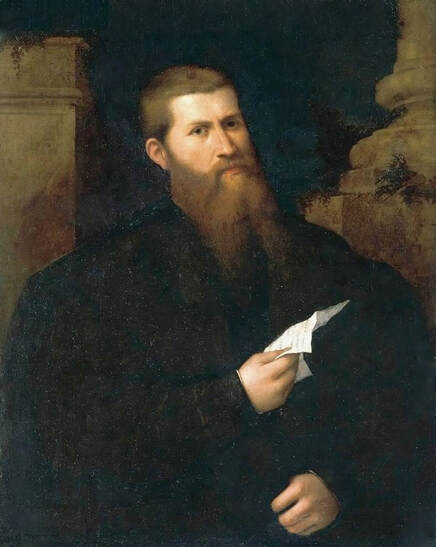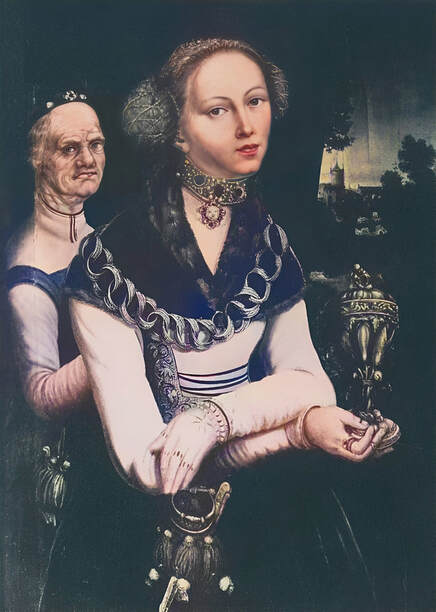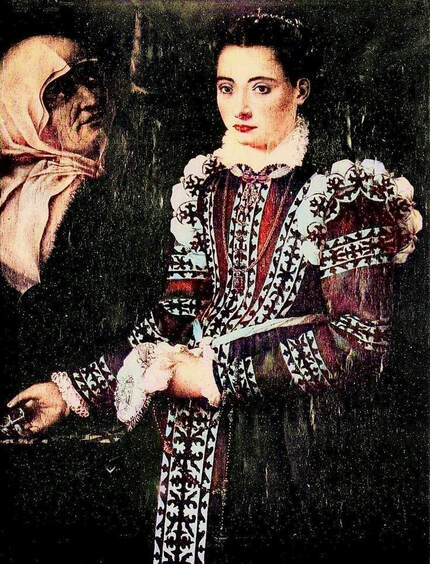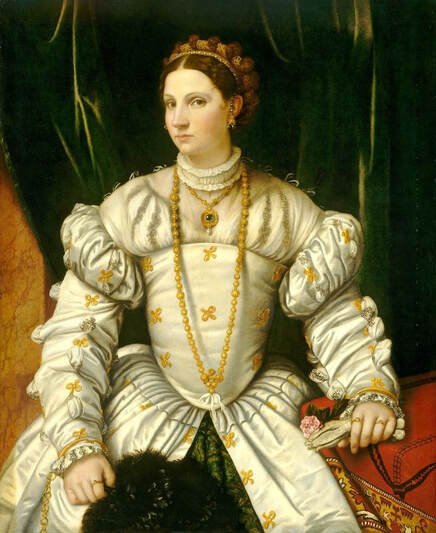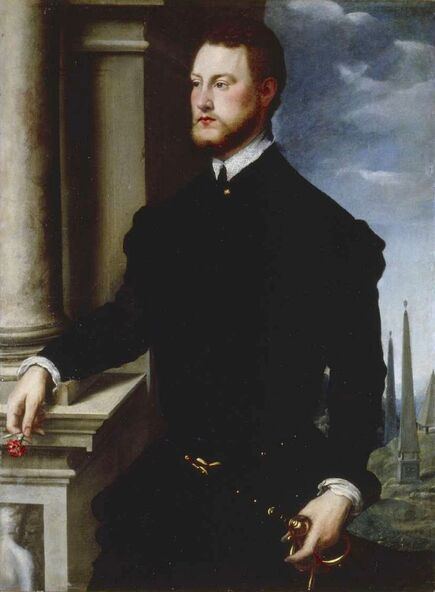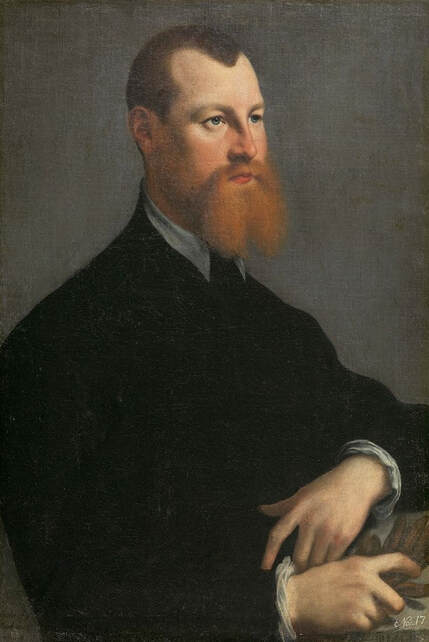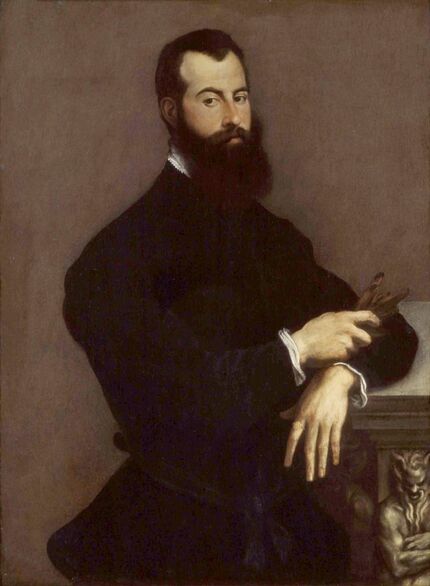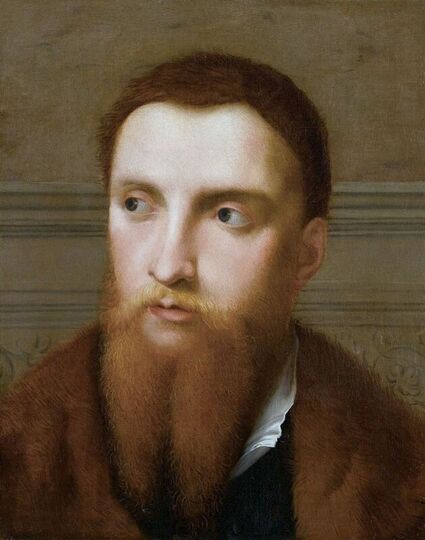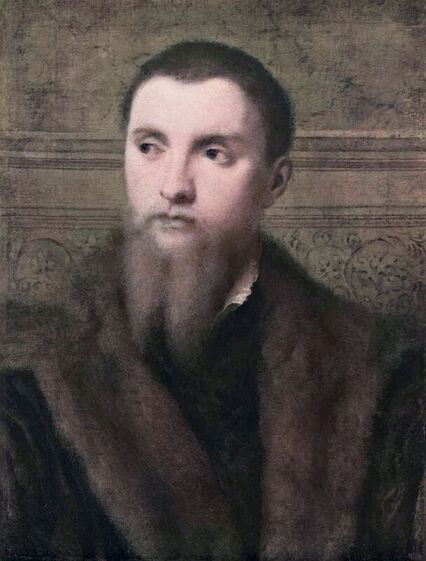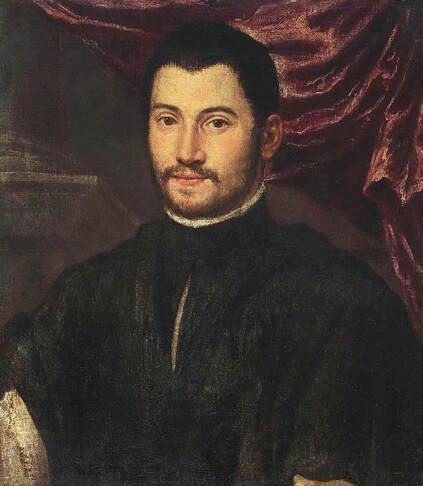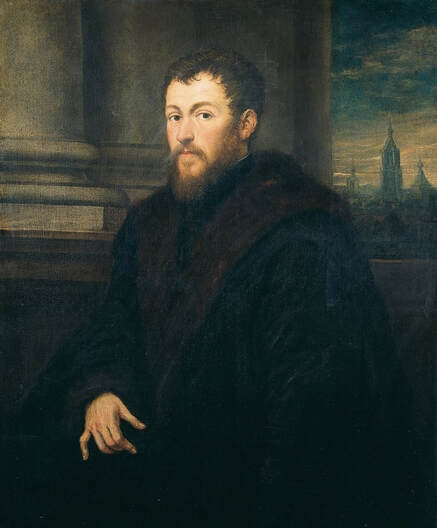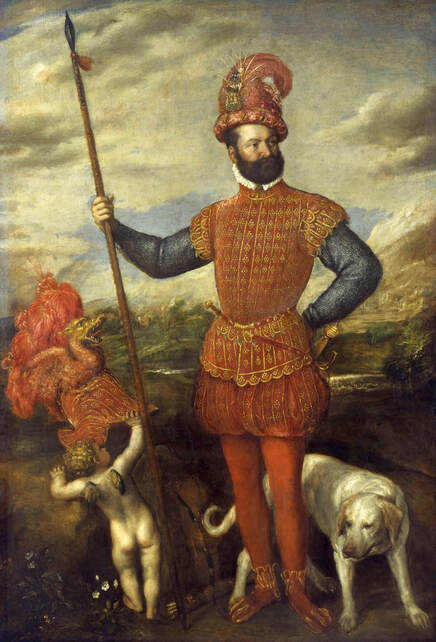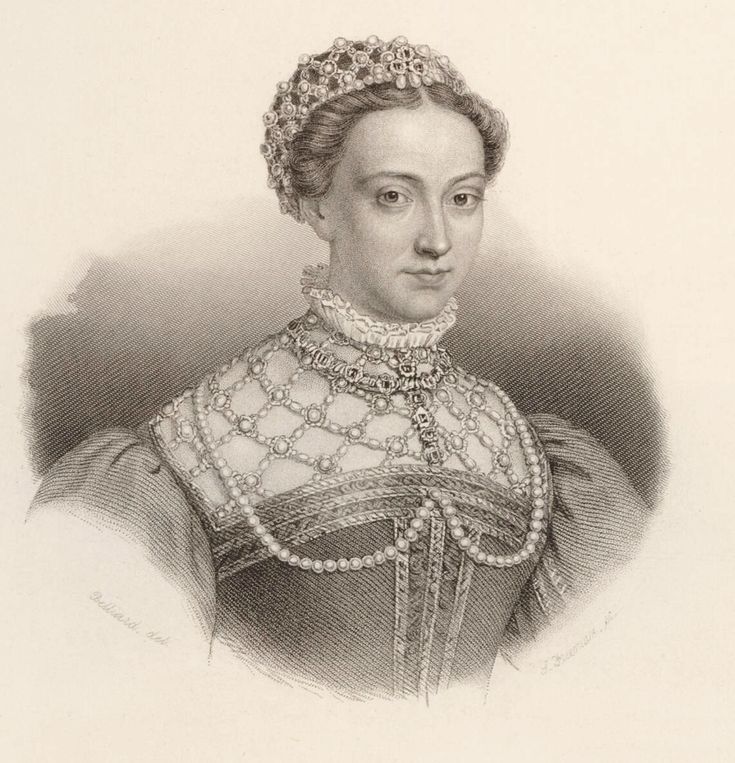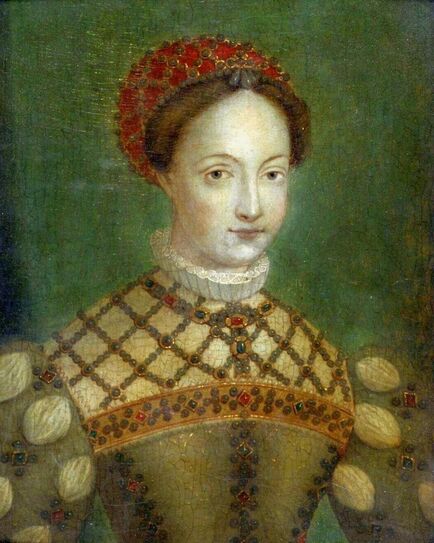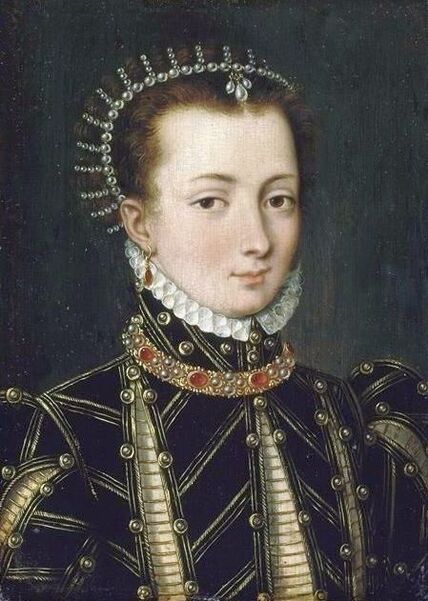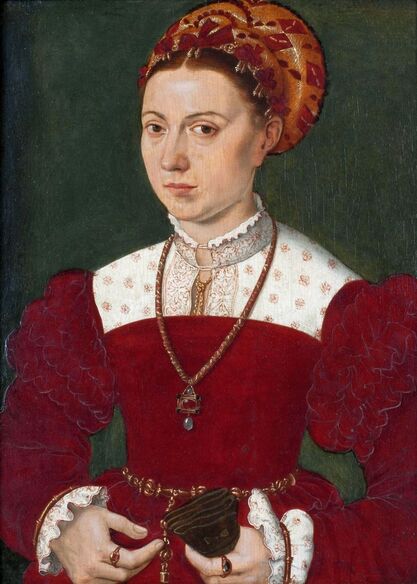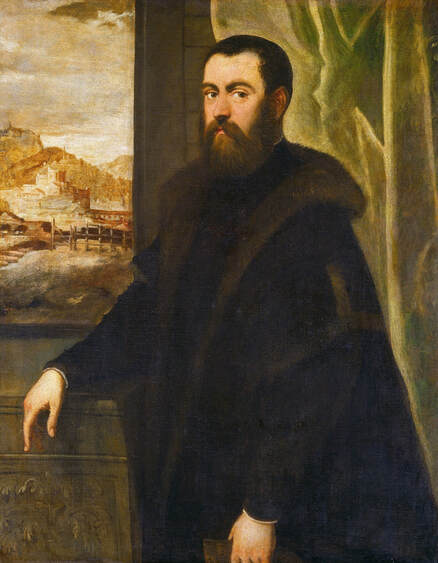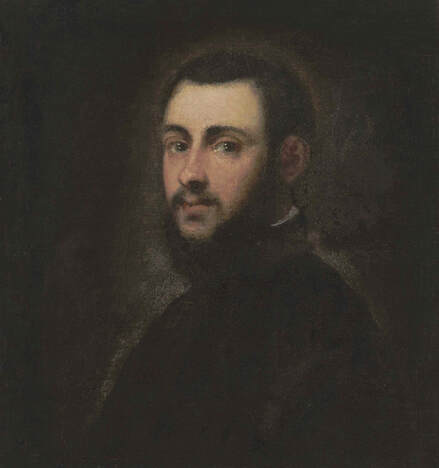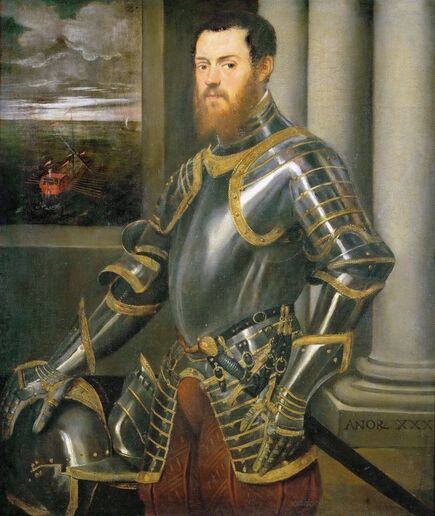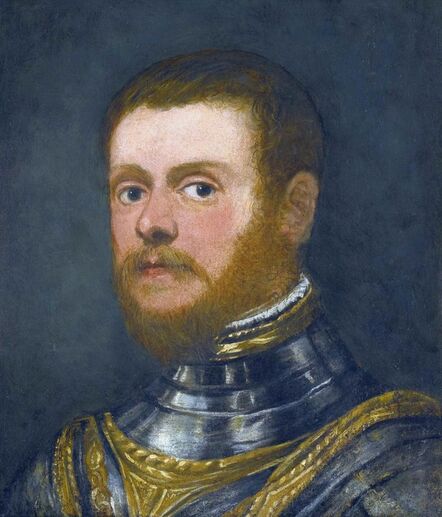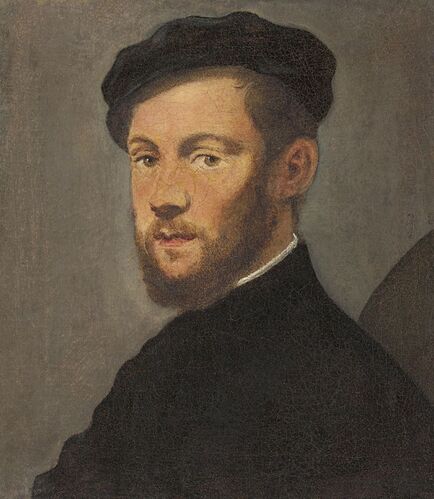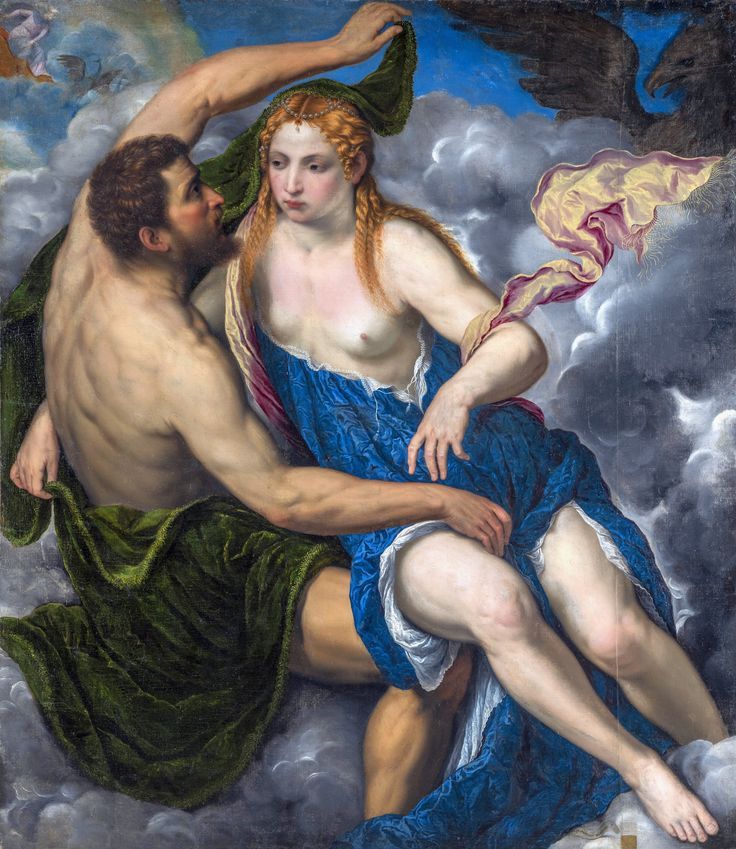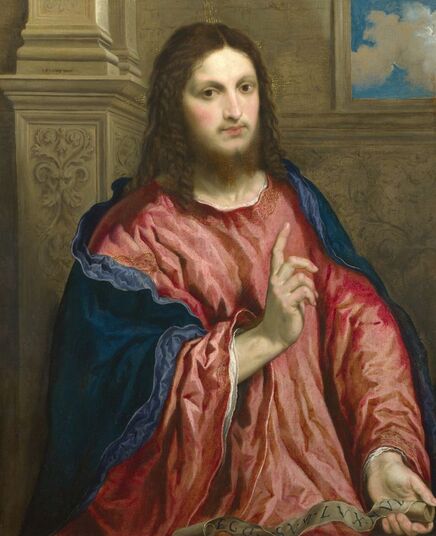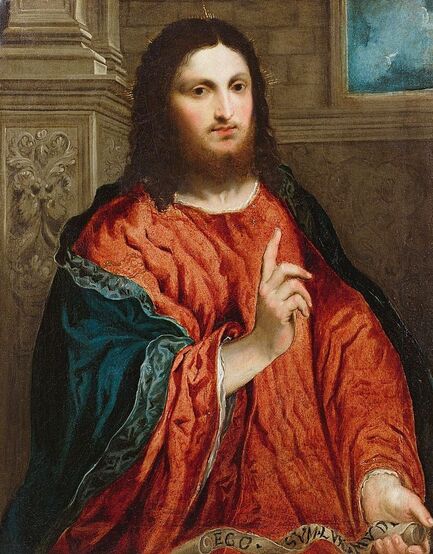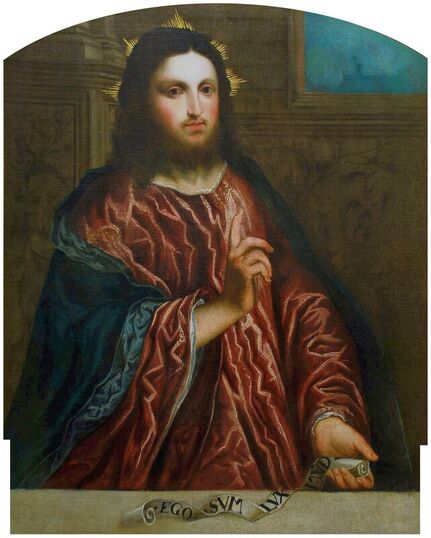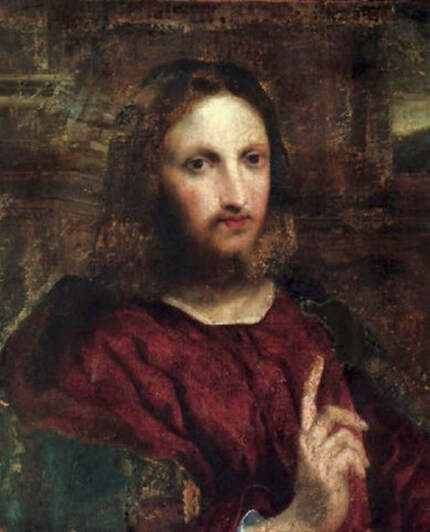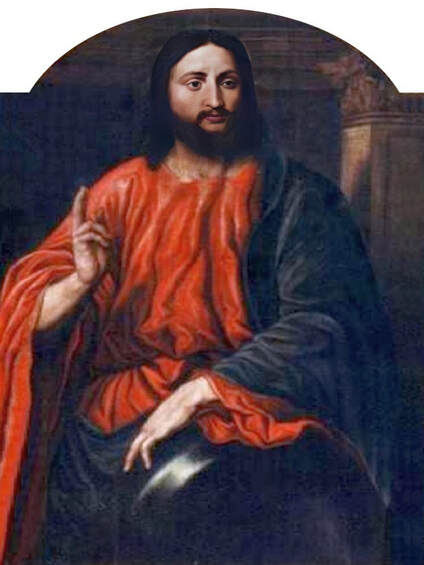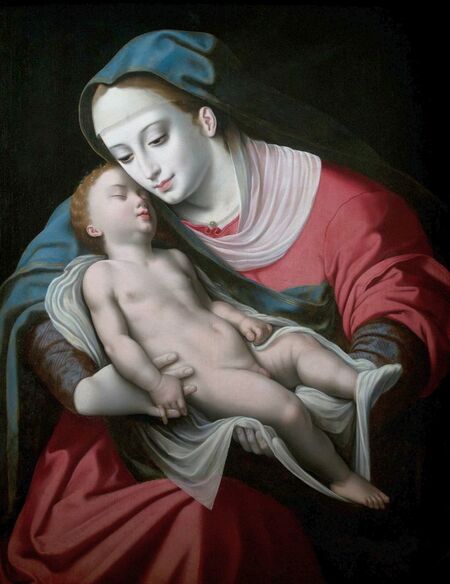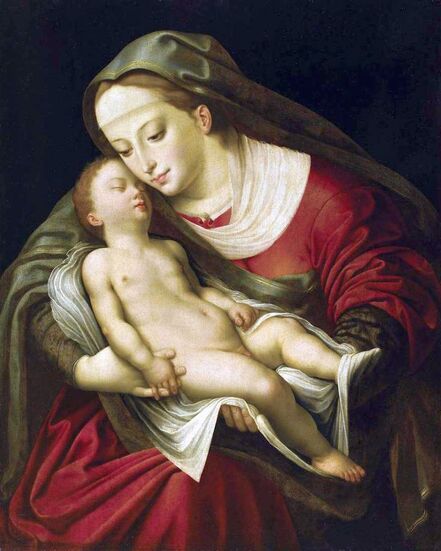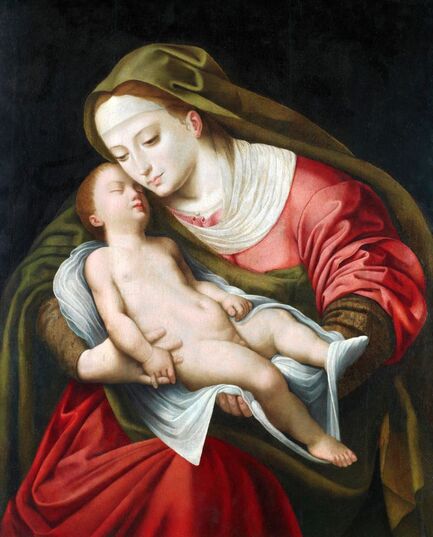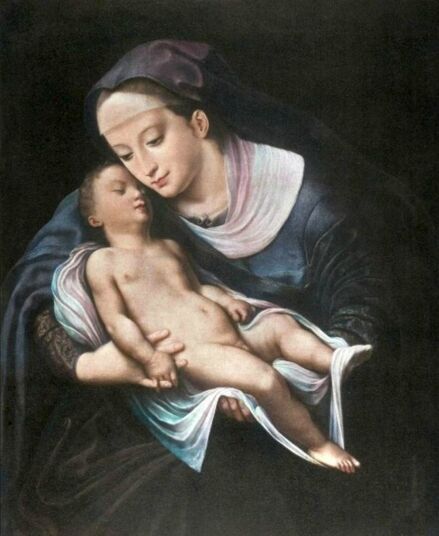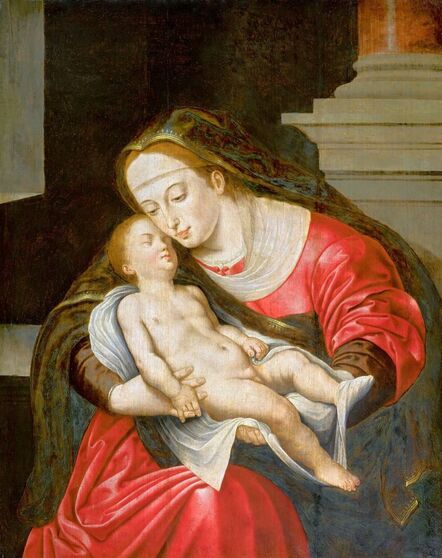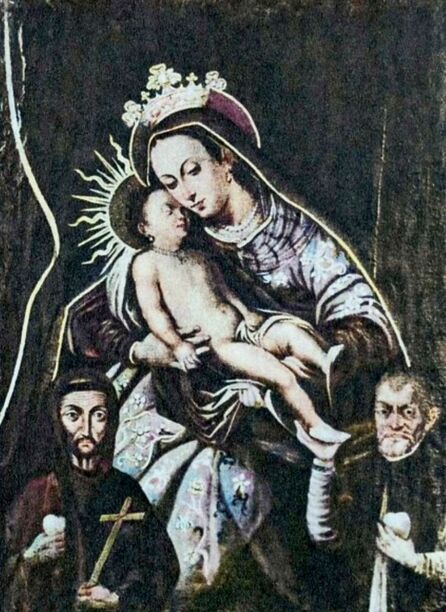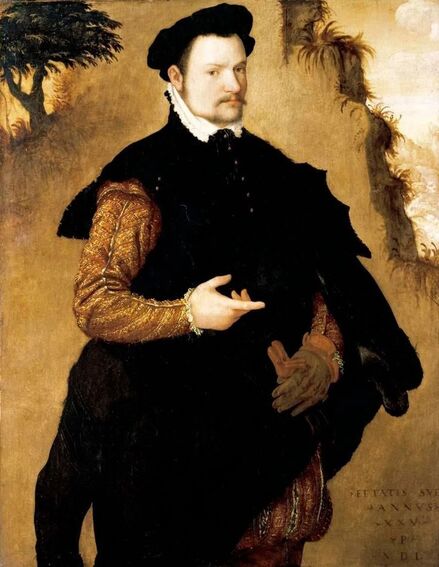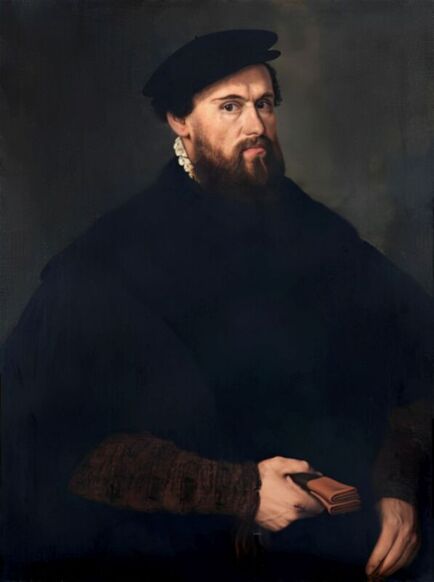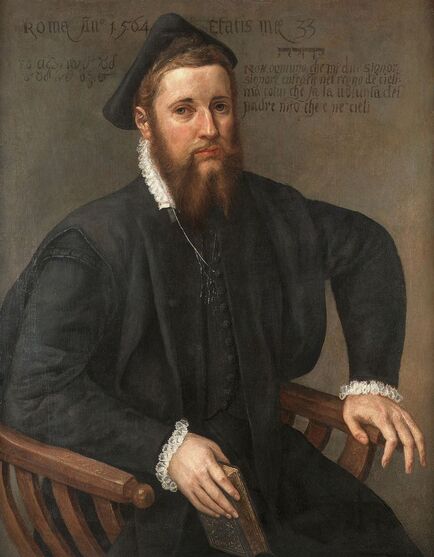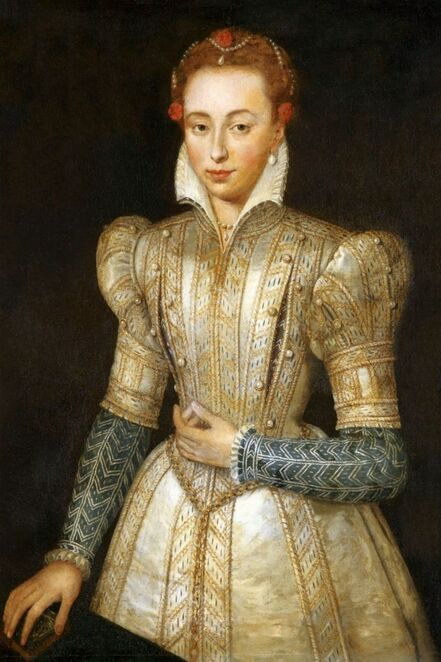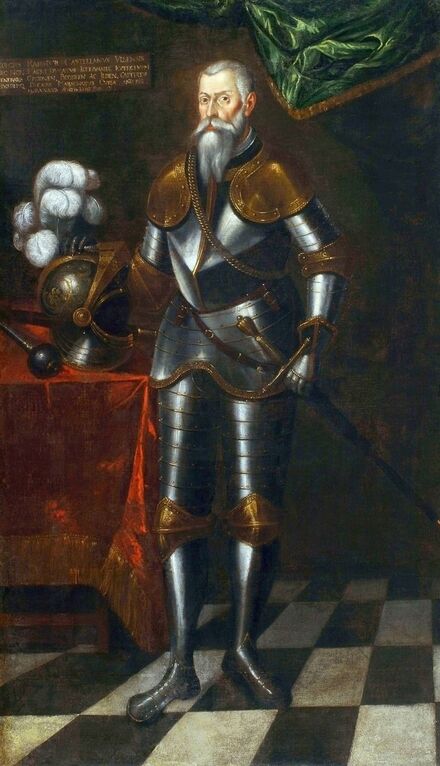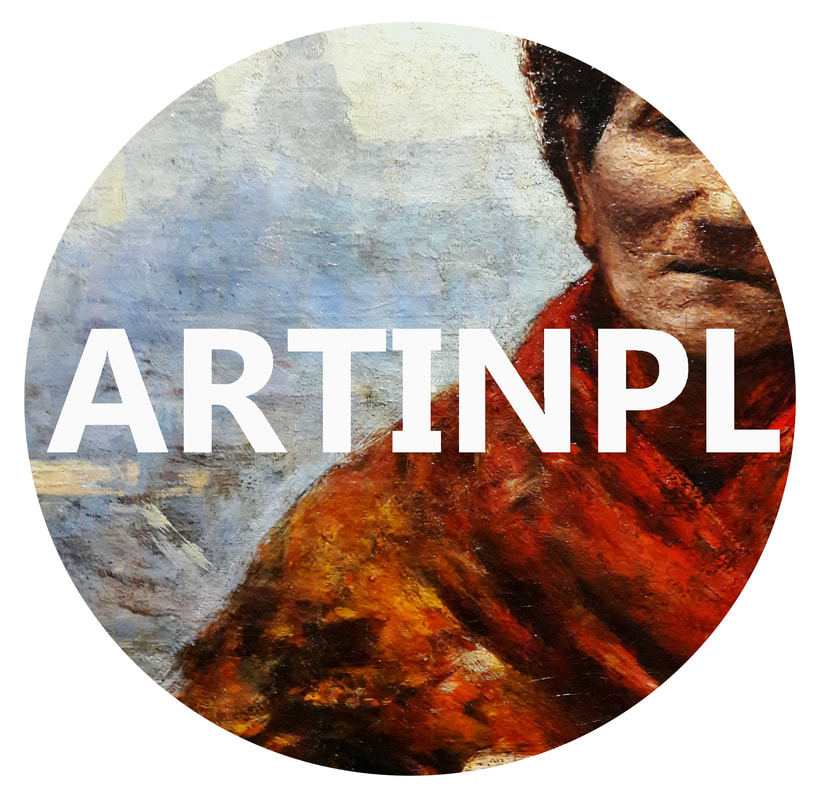|
Portraits of Isabella Jagiellon and John Sigismund Zapolya by Jacopino del Conte and Tintoretto
Just few months after her arrival to Hungary, on July 7, 1540 in Buda Isabella Jagiellon gave birth to her only son John Sigismund Zapolya. 15 days after his birth, his father died suddenly on July 22, 1540 and the infant John Sigismund was elected king by a Hungarian noble assembly in Buda and Isabella as his regent. The bishop of Oradea, George Martinuzzi (Frater Georgius), took over the guardianship. John Sigismund claim to the throne was challenged by Ferdinand I of Austria. Under the pretext of wanting to protect John's interests, Sultan Suleiman the Magnificent had his troops invade central Hungary in 1541 and occupy Buda.
After the Hungarian royal court had to leave Buda, Queen Isabella settled in Lipova and then from the spring of 1542 to the summer of 1551 in the former episcopal palace in Alba Iulia in Transylvania. Isabella was young, noted for her beauty, and scolded for her expensive tastes. She began reconstruction of the former bishop's palace in Alba Iulia in the Renaissance style. This decade was a period of unceasing hostilities and fierce disputes with Martinuzzi. Isabella kept a regular correspondence with her Italian relatives including her third cousin, Ercole II d'Este, Duke of Ferrara and her close advisor was Giovanni Battista Castaldo, an Italian mercenary leader (condottiere), First Marquis of Cassano, Imperial general and commander in the service of Emperor Charles V and his younger brother, Archduke Ferdinand I. Castaldo was a patron of arts and his preserved effigies were created by the best artists connected with the Spanish court - Titian (portrait in private collection), Antonis Mor (portrait in the Thyssen-Bornemisza Museum) and Leone Leoni (bust in the Church of San Bartolomeo in Nocera Inferiore and a medal in the Wallace Collection). In July 1551, facing superior forces, Isabella surrendered and she agreed to give up Transylvania in exchange for Silesian duchies (Opole, Racibórz, Ziębice, Ząbkowice Śląskie) and other territories offered by Ferdinand. The Silesian duchies turned out to be ruined after the earlier rule of the Hohenzollerns, to whom Ferdinand handed them over for 20 years in exchange for a loan. There was not even a residence that could accommodate Isabella's court. She departed towards Poland where she lived with her family for the next five years. To provide her with income, her brother granted her Krzepice and Sanok, while her mother gave her Wieluń. She returned to Transylvania in 1556 with her son. Isabella surrounded herself with foreigners - primarily Italians and Poles. Her secretary was Paolo Savorgnano of Cividale del Friuli and personal physician Giorgio Biandrata, who specialized in gynecology. In 1539 Biandrata published a medical treatise on gynecology entitled Gynaeceorum ex Aristotele et Bonaciolo a Georgio Blandrata medico Subalpino noviter excerpta de fecundatione, gravitate, partu et puerperio, a compilation taken from the writings of Aristotle and from Enneas muliebris by Ludovico Bonaccioli, dedicated to Queen Bona Sforza and her daughter, Isabella Jagiellon. In 1563 John Sigismund Zapolya made him his personal physician and councilor. Biandrata was a Unitarian and one of the co-founders of the Unitarian Churches in Poland and Transylvania. According to "The Art of Love: an Imitation of Ovid, De Arte Amandi" by William King, published in London in 1709 (page XXI), "Isabella Queen of Hungary, about the year 1540, shewed to Petrus Angelus Barcæus [Pier Angelio Bargeo], when he was at Belgrade, a silver pen with this inscription, Ovidii Nasonis Calamus; denoting that it had belonged to Ovid. This had not long before been found amongst some old ruins, and the esteemed it as a venerable piece of antiquity" (also in: "The Original Works of William King", published in 1776, p. 114). This fragment give some impression of the quality of patronage and collection of Isabella. Portrait of Matthias Corvinus, King of Hungary, Croatia and Bohemia in the Museum of Fine Arts in Budapest was painted in the style of Andrea Mantegna, an Italian painter and a student of Roman archeology born in Isola di Carturo in the Venetian Republic, who probably never visited Hungary. A portrait of Matthias' son, John Corvinus, in the Alte Pinakothek in Munich is attributed to Baldassare Estense, a painter who worked at the court of the Dukes of Este in Ferrara from 1471 to 1504 and who probably also never visited Hungary. Similar is the case of medal with bust of Queen Beatrice d'Aragona of Naples, Matthias's third wife in the National Gallery of Art in Washington, created in the style of Giovanni Cristoforo Romano, a sculptor born in Rome who later worked as medallist for the courts of Ferrara and Mantua. After Isabella's death on September 15, 1559 John Sigismund took control of the country. He spoke and wrote in eight languages: Hungarian, Polish, Italian, Latin, Greek, Romanian, German and Turkish. He was a passionate lover of books, as well as music and dance and could play a number of musical instruments. Despite his slim build he adored hunting and made use of the spear on such occasions. He converted from Catholicism to Lutheranism in 1562 and from Lutheranism to Calvinism in 1564. Around five years later, he became the only Unitarian monarch in history and in 1568 he proclaimed freedom of religion in Turda. In the Treaty of Speyer of 1570 between John Sigismund and the Emperor, Transylvania was recognized as an independent Principality under vassalage to the Ottomans and John Sigismund renounced his royal title. After John Sigismund's death on March 14, 1571, his uncle Sigismund II Augustus, King of Poland, and his aunts inherited a portion of his treasures. Papal nuncio Vincenzo dal Portico reported from Warsaw to Rome on August 15, 1571 about the enormous value of the inheritance valued by some at 500,000 thalers, which the king denied, claiming that it was worth only 80,000 thalers. Polish legation returning from Alba Iulia at the beginning of August 1571 brought only some of the valuables to Warsaw, including a great number of gold and silver objects and jewellery, including "1 crown with which the queen was crowned; 1 golden scepter; 1 golden apple" (1 corona, qua regina coronata est; 1 sceptrum aureum; 1 pomum aureum), "4 large, ancient and old-fashioned vases" (4 magnae, antiquae et vetustae amphorae), but also some paintings like "the golden altar, in which is the image of the Blessed Mary, valued at one hundred and forty-eight Hungarian florins" (altare aureum, in quo effigies Beatae Mariae, aestimatum centum quadraginta octo item Ungaricorum) or "portrait of Gastaldi - 4 fl. in the currency" (item Gastaldi effigies - 4 fl. in moneta), perhaps the effigy of Giacomo Gastaldi (ca. 1500-1566), an Italian astronomer and cartographer, who created maps of Poland and Hungary or Giovanni Battista Castaldo. "The image of Castaldi in gilt silver frame" (Imago Castaldi ex argento inaurato fuso), possibly even the same effigy by Titian sold by the Dickinson Gallery, was included in the list of items inherited by the king and his sisters. Among the inheritance, there was also an effigy of Queen Bona, mentioned in the letter of Queen of Sweden Catherine Jagiellon to her sister Sophia, dated August 22, 1572 in Stegeborg. "The remains of the legacy of the infanta, which will soon be here, is worth 70 to 80 thousand thalers" (vi resta il legato, della infanta, che sara presto qua che e di valore di 70 in 80 millia tallari) added dal Portico in his message about the inheritance of Intanta Anna Jagiellon (after Katarzyna Gołąbek, "Spadek po Janie Zygmuncie Zápolyi w skarbcu Zygmunta Augusta"). The painting of Madonna and Child with Saint John and angels in the National Museum in Warsaw, attributed to Jacopino del Conte, was purchased in 1939 from F. Godebski. The effigy of the Virgin is identical with portrait of Isabella Jagiellon in the Samek Art Museum. The painting was therefore commissioned shortly after the birth of Isabella's son in 1540. Both paintings were painted on wood panel and are stylistically very close to Florentine Mannerist painters Pontormo, Bronzino or Francesco Salviati. In 1909 in the Przeworsk collection of Prince Andrzej Lubomirski, who also owned Marco Basaiti's Portrait of Nicolaus Copernicus, there was a painting (oil on wood, 53.5 x 39 cm) attributed to 16th century Florentine school, "maybe Jacopo Carrucci called Jacopo da Pontormo (1494-1557)", depicting Madonna and Child (after "Katalog wystawy obrazów malarzy dawnych i współczesnych urządzonej staraniem Andrzejowej Księżny Lubomirskiej" by Mieczysław Treter, item 34, p. 11). In the National Gallery in London there is a portrait of approximately ten years old boy, also attributed to Jacopino del Conte, in a rich princely costume similar to that visible in a portrait of 19 years old Archduke Ferdinand (1529-1595), governor of Bohemia, son of Anna Jagellonica and Ferdinand I, in the Kunsthistorisches Museum, painted by Jakob Seisenegger in 1548. It was also painted on wooden panel. According to Gallery's description, "although full-length portraits were common in Venice and its states, where pictures were normally painted on canvas, they were rare in Florence where painting on wooden panels persisted longer", it is therefore possible that it was created by a Florentine painter active or trained in Venice, like Salviati who created a portrait of Isabella's brother king Sigismund II Augustus (Mint Museum of Art in Charlotte). The portrait of a boy in London was initially attributed to Pontormo, Bronzino or Salviati and was purchased in Paris in 1860 from Edmond Beaucousin. It was formerly in the collection of the Duke of Brunswick, while in 1556 when Isabella returned with her son to Transylvania, her mother Bona departed through Venice to Bari in southern Italy, Isabella's younger sister Sophia Jagiellon, married Duke Henry V and departed to Brunswick-Wolfenbüttel, taking a large dowry and undoubtedly portraits of the members of the royal family. The same boy, albeit a little older, was also depicted in a painting which was before 1917 in Wojciech Kolasiński's collection in Warsaw, included in the catalogue of his collection sold in Berlin (item 102). It was painted against a green background and attributed to Jacopo Pontormo. The boy has an order on his chest, similar to the cross of the Knights Hospitaller (Knights of Malta), enemies of the Ottomans, like the cross visible on the coat of the 12-year-old Ranuccio Farnese (1530-1565), who was created prior titular of the Venice Priory of the Order in 1540, in his portrait by Titian, or to the cross of the Order of the Golden Spur, which was frequently awarded by Hungarian monarchs, like in 1522, when István Bárdi was made a knight of the golden spur by king Louis II in presence of several high ranked noble gentlemen. He was finally depicted as a grown-up man in a painting by Jacopo Tintoretto, which was later in the collection of the Spanish Ambassador in Rome and later Viceroy of Naples, Don Gaspar Méndez de Haro, 7th Marquis of Carpio, as his initials D.G.H. are inscribed on the reverse of the canvas with a ducal crown. The painting was later in the collection of Prince Brancaccio in Rome and was sold at an auction in London in 2011. According to Catalogue Note (Sotheby's, 06 July 2011, Lot 58): "The unusual hat with its ornate brooch was not commonly seen on Venetian sitters of this period and has led some to suggest that the sitter was a visitor to Venice rather than a native of the city". If John Sigismund's uncle Sigismund Augustus, commissioned his effigies in Tintoretto's workshop in Venice, the same could John Sigismund. Another contender for the Hungarian crown, Ferdinand of Austria, also commissioned his effigies abroad, like a portrait by Lucas Cranach the Elder in Güstrow Palace, dated '1548' or a portrait by Titian from Spanish royal collection, created in mid-16th century, both most probably basing on some preparatory, study drawings and not seeing the model. In all three portraits the boy/man bears great resemblance to effigies of John Sigismund's paternal aunt, Barbara Zapolya, Queen of Poland, and his mother by Cranach and his workshop.
Portrait of Isabella Jagiellon (1519-1559), Queen of Hungary as Madonna and Child with Saint John and angels by Jacopino del Conte, ca. 1540, National Museum in Warsaw.
Portrait of John Sigismund Zapolya (1540-1571), King of Hungary as a child by Jacopino del Conte, ca. 1550, National Gallery in London.
Portrait of John Sigismund Zapolya (1540-1571), King of Hungary as a boy from Kolasiński collection by Jacopino del Conte, ca. 1556, Private collection.
Portrait of John Sigismund Zapolya (1540-1571), King of Hungary by Tintoretto, 1560s, Private collection.
Portraits of Hurrem Sultan and her daughter Mihrimah by Titian and workshop
"May Allah grant Your Royal Majesty long life and make one day a thousand days. The humbled one conveys: When I received your letter filled with love, I was so happy and glad that it is difficult to express it in words. [...] Along with this letter of sympathy, so as not to be empty words, we send two pairs of shirts and trousers with belts, six handkerchiefs and hand and face towels. We ask you to accept and enjoy them, even though the clothes sent are not worthy of you. God willing, next time I'll make them more ornate. In conclusion: may your God grant you long life, and may your state endure forever. Haseki Sultan", is a letter of 1549 (956) from Hurrem Sultan (ca. 1504-1558), the chief consort and legal wife of the Ottoman sultan Suleiman the Magnificent, to elected monarch of Poland-Lithuania Sigismund II Augustus (Central Archives of Historical Records in Warsaw, regest KDT, nr 103). A gift in the form of underwear is an expression of special intimacy between the sultana and the king, who wore shirts made by his sisters (according to documents from 1545 and September 1547).
Hurrem, "the joyful one" in Persian, is known to Europeans as Roxelana - from Roxolania, Ptolemy's name for Ruthenia (especially Ukraine), then part of Poland-Lithuania. According to Samuel Twardowski's "Important legation" (Przeważna legacya iaśnie oświeconego książęcia Krzysztopha Zbaraskiego ...), published in 1633 in Kraków, she was a daughter of Ukrainian Orthodox priest from Rohatyn and she was taken prisoner by the Tatars (z Rochatyna popa była córa, / Oddana niewolnicą do szaraju). She conquered the heart of the sultan, who in 1526 conquered Buda, the capital of Hungary, ending the rule of the Jagiellons in this part of Europe. Twardowski claim that the captive reportedly resorted to witchcraft: "And thus he will make her free / And allow her to his private rooms and his bed; But it was not enough for cunning Ruthenian girl / Using an old Karaite woman for this, / Through stealth toss and hot spells / She put the venom in Soliman's bones, / That the old man's love revived". Breaking the Ottoman tradition, he married Roxelana around 1533, making her his legal wife, and she was the first imperial consort to receive the title Haseki Sultan. In response to the criticism of Suleiman's subjects that he took "a sordid slave" (niewolnice podłej) as his wife, according to Twardowski, her husband claimed that she was "from the Polish country, from the royal blood comes and genus" and that she was a sister of king Sigismund (Że ją siostrą Soliman królewską nazywa [...] Ztąd Zygmunta naszego szwagrem swym mianował). It is tempting to believe that Queen Bona, who was managing Rohatyn from 1534/1535 as part of the royal domain, was behind all this and that these two women prevented further invasion of Central Europe by the Ottoman Empire. "War not to the detriment of the kingdom, but rather for defense" (Woyna nie ku skazie królestwa, ale raczey ku obronie) was the official state doctrine of "The Realm of Venus, goddess of love" - Polish-Lithuanian Commonwealth under the rule of elected Queen Anna Jagiellon, daughter of Bona Sforza, though within the Kingdom itself there were men desirous of breaking it. It was published in 1594 in Kraków in Stanisław Sarnicki's "Statutes and records of Crown privileges" (Statuta y metrika przywileiow Koronnych) under an effigy of Jan Zamoyski, Great Hetman of the Crown. Hurrem Sultan had four sons named Mehmed (1521), Selim (1524), Bayezid (1525) and Cihangir (1531) and a daughter Mihrimah Sultan (1522). There was also a son Abdullah, but he died at the age of 3. As a sultana (Italian word for wife or female relative of a sultan), Roxelana exerted a very strong influence on the state policy and she supported peaceful relations with Poland-Lithuania. Apart from Sigismund Augustus (letters of 1548 and 1549), she also corresponded with his sister Isabella, Queen of Hungary (1543) and his mother Queen Bona. Jan Kierdej alias Said Beg, who was captured by the Turks during the siege of his family castle in Pomoriany in Red Ruthenia in 1498, when he was eight, traveled to Poland three times as an Ottoman envoy (1531, 1538 and 1543). When in January 1543, Kierdej came with the embassy from the sultan to Sigismund the Old, he also brought the sultana's words to Queen Bona. Both women wanted to postpone or prevent the marriage of Sigismund Augustus with archduchess Elizabeth of Austria. The Queen of Poland, known for her outstanding artistic taste, acquired works of art and jewels in many places, including Turkey (after "Klejnoty w Polsce ..." by Ewa Letkiewicz, p. 57). The direct contacts of Roxelana with the rulers of the Venetian republic are not documented, but it is in Venice that most of her fictitious or faithful liknesses were created. It can be assumed that a large part of this "production" of portraits was intended for the Polish-Lithuanian market. Many Venetians lived in Poland-Lithuania and in Turkey and many Poles were undoubtedly interested in the life of the "Ruthenian Sultana". Roxelana's son Sultan Selim II (1524-1574), known as Selim "the blond" due to his fair complexion and blond hair, took as concubine Nurbanu Sultan (Cecilia Venier Baffo), a member of a well-known Venetian patrician family, and legally married her in about 1571. Ten letters written by Nurbanu between 1578 and 1583 to several ambassadors and to the Doge preserved in Venice. According to Vasari the Venetian painter Titian, although he never visited Istanbul, was commissioned by Suleiman the Magnificent to paint his wife Roxelana (Sultana Rossa) and their daughter Mihrimah (Cameria) (after "Images on the Page ..." by Sanda Miller, p. 84). Titian's portrait of Cameria and her mother was also recorded by Ridolfi. He and his famous workshop also painted the sultan and copies of these effigies are in the Kunsthistorisches Museum in Vienna and in private collection. To create the paintings, Titian had to use drawings or miniatures sent from Turkey. After World War II, only one known painted image of Queen Bona Sforza, created during her lifetime or close to it, has survived in the former territories of the Polish-Lithuanian Commonwealth. It is a miniature from a cycle depicting the Jagiellon family (today in the Czartoryski Museum), made by workshop of Lucas Cranach the Younger (1515-1586) in Wittenberg, Germany in about 1553 basing on a drawing or another miniature sent from Poland-Lithuania. Interestingly, also two effigies of Ottoman Sultanas survived, one is a portrait traditionally identified as Roxelana in the Lviv Historical Museum in Ukraine and the other is a likeness of her daughter Mihrimah in the Masovian Museum in Płock in Poland. Both were creted in the 16th century and come from historical collections of the former Commonwealth. The portrait in Lviv is small painting on wood (38 x 26 cm) and comes from the collection of the Ossolineum, which received it in 1837 from Stanisław Wronowski. The effigy of Mihrimah in Płock was also painted on wood (93 x 69.7 cm) and comes from the collection of the Ślizień family deposited by them with the Radziwills in Zegrze near Warsaw during World War I. Before World War II in the Red Salon of the Zamoyski Palace in Warsaw there was a portrait of the "Turkish Sultana", burnt in 1939 along with all the furnishings of the palace (after "Ars Auro Prior" by Juliusz Chrościcki, p. 285). Such portraits are also documented in Poland-Lithuania much earlier. The 1633 inventory of Radziwill Castle in Lubcha in Belarus (Central Archives of Historical Records in Warsaw, 1/354/0/26/45) lists "A painting of a lady with the inscription Favorita del gran turcho" (36). The inscription in Italian indicates that the painting was most likely made in Italy. The inventory of paintings from the collection of princess Louise Charlotte Radziwill (1667-1695), drawn up in 1671, lists the following depictions of Turkish women, some of which may be by Titian: "Turkini in a turban plays the viola" (295), "A young Turkish woman with a feather" (315), "A young woman from Turkey" (316), "Turkini in a turban and in sables, a woman by her side" (418) (after "Inwentarz galerii obrazów Radziwiłłów z XVII w." by Teresa Sulerzyska). Some effigies previously considered to represent Catherine Cornaro are now identified as portraits of Roxelana, like the painting in Florence with attributes of Saint Catherine of Alexandria - breaking wheel and halo (Uffizi Gallery, Inv. 1890, 909). It entered the Gallery in 1773 with the attribution to Veronese, but later the Latin inscription Titiani opus - 1542 was found on the back. A very similar portrait inscribed in French ROSSA FEMME DE SOLIMAN EMPEREUR DES TURCS (Rosa, Consort of Suleiman, Emperor of the Turks) is in the Royal Collection at Kensington Palace (RCIN 406152). Her costume is also distinctly Ottoman. Another version of this painting was before 1866 in the Manfrin collection in Venice and Samuelle Levi Pollaco created an etching of the painting with inscription: CATTERINA CORNARO REGINA DI CIPRO. Her outfit is slightly different, and we can see three pyramids in the background, most probably the three main pyramids at Giza in Egypt, at that time a province of the Ottoman Empire (Egypt was conquered by the Ottoman Turks in 1517). Eastern Orthodox Monastery of Saint Catherine of Alexandria, built by order of Byzantine emperor Justinian I at the site where Moses is supposed to have seen the burning bush, sacred to Christianity, Islam, and Judaism, is also in Egypt (Sinai Peninsula). Roxelana was a daughter of an Orthodox priest, hence this monastery was undoubtedly of particular importance to her throughout the Ottoman Empire. A reduced copy of this effigy attributed to studio of Titian was sold as "Portrait of Caterina Cornaro" (Christie's London, July 9, 2021, lot 214). Other bust-length version of this portrait by follower of Titian is in Knole House, Kent (NT 129882). The painter used the same face in his famous Venus with a mirror, today in the National Gallery of Art in Washington (inventory number 1937.1.34). This painting remained in the possession of the artist until his death, where it might have inspired visitors to commission similar paintings for themselves, or it might have served as a model for members of the workshop to reproduce. It is also possible that he wanted to have an effigy of this beautiful woman, one of his best clients. The painting is usually dated to about 1555, however, it it possible that it was painted much earlier, because "Titian's style and pictorial technique were never uniform and could vary from one work to another, as well as from one decade to another", as noted by Peter Humfrey in the Gallery's Entry for the painting (March 21, 2019). The 1971 X-ray reveals that Titian reused a canvas that once depicted two three-quarter figures standing side by side, possibly work not accepted by a client, and he rotated the canvas 90 degrees. Fern Rusk Shapley compared the double portrait with the so-called Allegory of Alfonso d'Avalos from around 1532 (Louvre in Paris). The portrait of Alfonso d'Avalos with a page, once owned by King John III Sobieski and King Stanislaus Augustus Poniatowski (J. Paul Getty Museum, inventory number 2003.486), is dated to about 1533. Giorgio Tagliaferro suggested that the double portrait was started by the young Paris Bordone while he was an assistant in Titian's studio (probably around 1516 for two years). In the mirror held by a cupid, she doesn't seem to see herself, but someone who is looking at her, most likely a man, her husband. Another cupid crowns her head with a wreath. This work is considered the finest surviving version of a composition executed in many variants by Titian and his workshop, some of the best of which are in the State Hermitage Museum, acquired in 1814 from the collection of Empress Josephine in Malmaison near Paris (inventory number ГЭ-1524), and in the Gemäldegalerie in Dresden (inventory number Gal.-Nr. 178). A version which was owned by the king of Spain (lost) was copied by Peter Paul Rubens (Thyssen-Bornemisza National Museum Madrid, 350 (1957.5)). The same woman, in similar pose and costume to the work in Florence was depicted in a painting attributed to workshop of Titian, today in the John and Mable Ringling Museum of Art in Sarasota, Florida (inventory number SN58). It comes from the Riccardi collection in Florence, sold to Lucien Bonaparte (1775-1840), younger brother of Napoleon Bonaparte, exactly like the "Portrait of the Duchess Sforza" (Portrait of Queen Bona Sforza) by Titian. Therfore both portraits - of the Queen of Poland and the Sultana of the Ottoman Empire were most probably created at the same time in Venice and sent to Florence. She is holding a little pet, most probably a mink or a weasel, a talisman for fertility. The flower in her décolletage might indicate, that she is a bride or newly wed woman. Slighly different version of this painting is in private collection. She was also depicted in another portrait by Titian (National Gallery of Art, Washington, 1939.1.292), wearing a similar green dress, a color being symbolic of fertility. She cradles an apple in her hands, which in art often connotes female sexuality. This painting was probably owned by Michel Particelli d'Hémery (1596-1650) in Paris, France. The Franco-Ottoman Alliance, one of the longest-lasting and most important foreign alliances of France, was formed in 1536 between the King of France Francis I and the Sultan Suleiman I. Beyond doubt, the French king had likenesses of the sultan and his influential wife. Numerous variants and copies of this portrait exist. In a similar portrait from private collection in Veneto (sold at Dorotheum in Vienna, 17.10.2017, lot 233) her Ottoman dress is pink, a symbol of marriage, and she is preparing her bridal wreath (similar to that visible on her head in the Washington version). The style of this painting is particularly close to Giovanni Cariani. It would be rather unusual if a Christian noblewoman from Venice would be dressed in Ottoman attire for her wedding. Therefore, through these portraits, the "Ruthenian girl" wanted to announce to the world that she is not a concubine, but the legal wife of the Sultan. After 1543 a follower of Titian, most probably Alessandro Varotari (1588-1649), known as Il Padovanino, copied other version of this painting with model holding an empty vase (Gemäldegalerie Alte Meister in Dresden, Gal.-Nr. 173). The portrait identified as Roxelana from the collection of Sir Richard Worsley in Appuldurcumbe House, Isle of Wight (1804, as by 'Gentile Bellino') by follower of Titian depicts her holding an empty vase. Together with Latin inscription on the column "all is vanity" (OMNIA VANITAS) it might symbolize a great loss. On 7 November 1543 the eldest son of Hurrem Sultan, Prince Mehmed, died in Manisa, probably of smallpox. The sultana most probably knew Latin, as the Roman Catholic community was present in Rohatyn since the Middle Ages. Her large turban and face resemble the Lviv portrait. The style of this painting is also close to Giovanni Cariani. Similar to the Lviv likeness, also the effigy of Mihrimah (Cameria) in Płock has a counterpart made by workshop of Titian, today in the Courtauld Gallery in London, a copy of a lost original by Titian. It comes from the collection of Count Antoine Seilern (1901-1978), an Anglo-Austrian art collector and art historian. Like her mother, she was depicted with a spiked wheel, used to identify Saint Catherine of Alexandria. A study for this portrait by Titian or his workshop is in the Albertina in Vienna (inventory number 1492). The portrait of Cameria in the Musée Fabre in Montpellier (inventory number 65.2.1) was created by Sofonisba Anguissola (signature: PINXIT SOPHONISBE ANGUSSOLA VIRGO CRE. XIII SUCC). Like Queen Bona, who successfully ruled in the world dominated by men, the "Ruthenian girl" was well aware of the power of the image and conveyed the splendor of her reign through paintings created by the Venetian workshop of Titian.
Portrait of Hurrem Sultan (Roxelana, ca. 1504-1558) as a bride by workshop of Titian, ca. 1533, John and Mable Ringling Museum of Art in Sarasota.
Portrait of Hurrem Sultan (Roxelana, ca. 1504-1558) as a bride by workshop of Titian, ca. 1533, Private collection.
Portrait of Hurrem Sultan (Roxelana, ca. 1504-1558) as a bride holding an apple by Titian, ca. 1533, National Gallery of Art in Washington.
Portrait of Hurrem Sultan (Roxelana, ca. 1504-1558) as a bride holding her bridal wreath by workshop of Titian or Giovanni Cariani, ca. 1533, Private collection.
Portrait of Hurrem Sultan (Roxelana, ca. 1504-1558) holding an empty vase by follower of Titian, most probably Alessandro Varotari, after 1543, Gemäldegalerie Alte Meister in Dresden.
Portrait of Hurrem Sultan (Roxelana, ca. 1504-1558) as Venus with a mirror by Titian, ca. 1533 or after, National Gallery of Art in Washington.
Portrait of Hurrem Sultan (Roxelana, ca. 1504-1558) as Venus with a mirror by workshop of Titian, ca. 1533 or after, The State Hermitage Museum.
Portrait of Hurrem Sultan (Roxelana, ca. 1504-1558) as Venus with a mirror by workshop of Titian, ca. 1533 or after, Gemäldegalerie in Dresden.
Portrait of Hurrem Sultan (Roxelana, ca. 1504-1558) with pyramids by Titian, ca. 1542, Private collection.
Portrait of Hurrem Sultan (Roxelana, ca. 1504-1558) as Saint Catherine of Alexandria by workshop of Titian, 1542, Uffizi Gallery.
Portrait of Hurrem Sultan (Roxelana, ca. 1504-1558) by workshop of Titian, ca. 1542, Private collection.
Portrait of Hurrem Sultan (Roxelana, ca. 1504-1558) by follower of Titian, ca. 1542, Knole House.
Portrait of Hurrem Sultan (Roxelana, ca. 1504-1558) holding an empty vase by follower of Titian or Giovanni Cariani, ca. 1543, Private collection.
Preparatory drawing for a portrait of Mihrimah Sultan (Cameria, 1522-1578) by Titian or workshop, after 1541, Albertina in Vienna.
Portrait of Mihrimah Sultan (Cameria, 1522-1578) as Saint Catherine of Alexandria by workshop of Titian, after 1541, Courtauld Gallery in London.
Portrait of Mihrimah Sultan (Cameria, 1522-1578) by unknown painter after Titian, after 1541, Masovian Museum in Płock.
Portrait of royal courtier Jan Krzysztoporski by Bernardino Licinio
The interpretation of classical architecture by Venetian architect Andrea Palladio (1508-1580), known as Palladianism, revived by early 18th century British architects, become the dominant architectural style until the end of the century. The work of the architect and his effigies become highly demanded goods.
That is why an owner of a portrait of an unkown nobleman by Bernardino Licinio, possibly a painter, decided to turn it into a portrait of the famous architect. He added an inscription in Latin (ANDREAS. PALADIO. A.) and a set-square and a compass in sitter's right hand to make his "forgery" even more probable. The portrait, today in Kensington Palace, was acquired in 1762 by king George III from Joseph Smith, British Consul in Venice. Wooden attributes of a simple architect contrast sharply with opulent costume of the sitter, crimson doublet of Venetian silk, gold rings with precious stones and a coat lined with expensive Eastern fur. Also the man depicted is more Eastern type than an Italian. Such expensive, usually metal instrument, as compass is clearly exposed in the portraits of architects by Lorenzo Lotto, while in Licinio's portrait is barely visible. The little finger is a proof that the attributes were added later, as its appearance is anatomically impossible to hold a set-square and a compass. According to original inscription (ANNOR. XXIII. M.DXLI) the sitter was 23 in 1541, exactly as Jan Krzysztoporski (1518-1585), a nobleman of Nowina coat of arms from central Poland. Between 1537-1539 he studied in Lutheran Wittenberg, under the direction of Philip Melanchthon, recommended to him by "the father of Polish democracy" Andrzej Frycz Modrzewski. Then he went for further studies to Padua (entred as loannes Christophorinus), where on May 4, 1540, he was elected a counselor of the Polish nation. In January 1541, he welcomed in Treviso, close to Venice, the Chancellor Jan Ocieski (1501-1563) on his way to Rome. After returning to Poland, he was admitted to the royal court on 2 July 1545 and in 1551 he was made the royal secretary. He was an envoy of king Sigismund Augustus to Pope Julius III in 1551, to Joachim II Hector, Elector of Brandenburg in 1552 and to Isabella Jagiellon, Queen of Hungary in 1553. As a follower of Calvinism, he founded a congregation of this religion in his estate in Bogdanów, near Piotrków Trybunalski. He also had a large library in his brick fortified manor in Wola Krzysztoporska, which he built, destroyed during subsequent wars.
Portrait of royal courtier Jan Krzysztoporski (1518-1585) by Bernardino Licinio, 1541, Kensington Palace.
Portraits of Jan Krzysztoporski, Jan Turobińczyk and Wandula von Schaumberg by Hans Mielich
Around 1536, a German painter Hans Mielich (also Milich, Muelich or Müelich), born in Munich, went to Regensburg, where he worked under the influence of Albrecht Altdorfer and the Danube School. He stayed there till 1540, when he returned to Munich. At that time, from 1539 to 1541, Regensburg was a place of meetings between representatives of the various Christian communities and debates between Catholics and Protestants, climaxing in the Regensburg Colloquy, also known as Diet of Regensburg (1541). Among the people vividly interested in the debates were Jan Łaski (Johannes a Lasco, 1499-1560), a Polish Calvinist reformer, later involved in translation project of the Radziwill Bible, who studied in Mainz in the winter of 1539/40, and Wandula von Schaumberg (1482-1545), the Princess-abbess of the Imperial Obermünster Abbey in Regensburg from 1536, who had a seat and vote in the Imperial Diet. In 1536 Mielich created a painting of Crucifixion of Christ with his monogram, date and coat of arms of the von Schaumberg family, today in the Landesmuseum in Hannover, most probably commissioned by Wandula.
A portrait of a wealthy old woman in a black dress, white cap and a wimple by Hans Mielich in the Museu Nacional d'Art de Catalunya in Barcelona, deposit of the Thyssen-Bornemisza collection, comes from the collection of a mysterious Count J. S. Tryszkiewicz in his French castle of Birre. No such person and castle are confirmed in sources, however Count Jan Tyszkiewicz, who died in Paris on June 9, 1901, was owner of the Birzai Castle in Lithuania and a son of renowned art collector, Michał Tyszkiewicz. Both the family as well as the castle were known differently in different languages of the multicultural nation, hence the mistake is justified. Before the Tyszkiewicz family, Birzai Castle was the main seat of the Calvinist branch of the Radziwill family. According to inscription in German, the woman in the painting was 57 in 1539 (MEINES ALTERS IM . 57 . IAR . / 1539 / HM), exactly as Wandula von Schaumberg, who like the Radziwills was the Imperial Princess. In 1541 the artist went to Rome, probably at the instigation of Duke William IV of Bavaria. He remained in Italy till at least 1543 and after his return, on 11 July 1543 he was admitted to the Munich painters' guild. Hans was a court painter of the next Duke, Albert V of Bavaria and his wife Anna of Austria (1528-1590), daughter of Anna Jagellonica (1503-1547) and younger sister of Elizabeth of Austria (1526-1545), first wife of Sigismund II Augustus. Albert and Anna were married on 4 July 1546 in Regensburg. On his way to Rome, Mielich most probably stopped in Padua, where in 1541 Andreas Hertwig (1513-1575), a member of patrician family from Wrocław, obtained the degree of doctor of both laws at the age of 28. Hertwig commissioned his portrait, today in the National Museum in Warsaw. On December 10, 1540 Jan Ocieski of the Jastrzębiec coat of arms (1501-1563), secretary of king Sigismund I set off on a diplomatic mission from Kraków. It is possible that he was accompanied by Jan Turobińczyk (Joannes Turobinus, 1511-1575), an expert on Cicero and Ovid, who after studies in Kraków in 1538 became the secretary of the bishop of Płock and other secretary of the king, Jakub Buczacki, and for two years he moved to the bishop's court in Pułtusk. When Buczacki died on 6 May 1541, he lost his protector and moved to Kraków, where he decided to continue his studies. Jan was later ordained a priest in about 1545, he lectured on Roman law and he was elected rector of the Kraków Academy in 1561. A portrait of a man holding gloves in the Germanisches Nationalmuseum in Nuremberg is very similar to the portrait of Andreas Hertwig in Warsaw. According to inscription on the back, the man depicted is also Andreas Hertwig, hence the portrait is attributed to so-called Master of the Andreas Hertwig Portrait. Facial features, however, do not match and according to original inscription in Latin the man was 30 on 8 May 1541 (M D XXXXI / D VIII MAI / AETATIS XXX), exactly as Jan Turobińczyk when the news of the death of his protector could reach him in Italy and when he could decide to change his life and return to studies. Another similar portrait to the effigy of Andreas Hertwig in Warsaw is in private collection. The young man in a rich costume was depicted against a green background. According to inscription in Latin he was 25 on 22 November 1543 (M. D. XLIII. DE. XX. NOVEMBE / .AETATIS. XXV), exactly as Jan Krzysztoporski, who around that time was still in Italy. His facial features are similar to the portrait by Bernardino Licinio created just two years earlier, in 1541 (Kensington Palace). The difference in eye color is probably due to technique and style of painting. Rings on his finger are almost identical on both paintings and coat of arms on the signet ring visible on the portrait from 1543 is very similar to Nowina coat of arms as shown in the 15th century Armorial de l'Europe et de la Toison d'or (Bibliothèque nationale de France). The letters on the signet can be read as IK (Ioannes Krzysztoporski). At the beginning of the 17th century, the court painter of the Polish-Lithuanian Vasas was Christian Melich, who, according to some sources, came from Antwerp. This, however, does not exclude the possibility that he was a relative of Hans Mielich. He created one of the oldest views of Warsaw, now in Munich, most probably from the dowry of Anna Catherine Constance Vasa.
Portrait of Princess-abbess Wandula von Schaumberg (1482-1545) aged 57, from the Radziwill Castle in Birzai by Hans Mielich, 1539, Museu Nacional d'Art de Catalunya.
Portrait of Jan Turobińczyk (1511-1575) aged 30 by Hans Mielich, 1541, Germanisches Nationalmuseum in Nuremberg.
Portrait of Jan Krzysztoporski (1518-1585) aged 25 by Hans Mielich, 1543, Private collection.
Portraits of Françoise de Luxembourg-Ligny by Hans Besser and workshop of Lucas Cranach the Younger
Streets, houses, temples, public baths and other edifices of Antient Greece and Rome were full of statues, frescoes and mosacis showing naked gods and rulers. Surely in such temperatures in the south of Europe, where Bona Sforza was raised, it was easier to undress than to get dressed. More to the north the situation was quite opposite, to protect from cold, people dressed up and rarely could see any nudity, thus become more prudish in this regard. Renaissance redisovered the nude statues and paintings of the ancient and today some televison programs reinvented the concept that is good to see a potential partner naked before any engagement, at least for some people.
In 1549 Emperor Charles V (1500-1558) commissioned a bronze statue of himself as a naked ancient god and the detachable armour, so the statue could be dressed. The sculpture, created in Milan by Italian sculptors Leone and Pompeo Leoni, was presented to the Emperor in Brussels in 1556 and later transported to Madrid, today in the Prado Museum (inventory number E000273). In 1535 Françoise de Luxembourg-Ligny, a daughter of Count Charles I of Ligny and Charlotte d'Estouteville, married Bernhard III, Margrave of Baden-Baden. Françoise was a Countess of Brienne and Ligny and heiress of the County of Roussy. She was about 15 years old and the groom 61 at the time of their marriage. Almost a year after the wedding she bore her husband a son Philibert, born on 22 January 1536. Bernhard died on 29 June 1536 and their second son Christopher was born on 26 February 1537, posthumously. Next years were filled with disputes over the custody of the children, which was claimed by their uncle Ernest, Margrave of Baden-Durlach who favored Lutheranism and Duke William IV of Bavaria, husband of Bernhard's niece Marie Jakobaea of Baden-Sponheim, a staunch Catholic. In agreement with Françoise, her eldest son Philibert spent part of his youth at the court of Duke William IV in Munich. Françoise remarried on 19 April 1543 to Count Adolf IV of Nassau-Idstein (1518-1556), who was more of her age, and she bore him three children. In 1549 Hans Besser, court painter of Frederick II, Elector Palatine created a series of portraits of Françoise's eldest sons Philibert and Christopher (in Munich, from the collections of the Dukes of Bavaria and in Vienna, from the Habsburg collection). In 1531 Frederick of Palatine was a candidate to the hand of Princess Hedwig Jagiellon, he must have received her portrait, most probably in the popular "guise" of Venus and Cupid. A painting showing Venus and Cupid in the Alte Pinakothek in Munich from about 1540 is painted in the form typical for Cranach's Venuses. Its style, however, is not typical for Cranach and his workshop, hence this painting is also attributed to a Cranach's copist from the early 17th century Heinrich Bollandt. The painting was acquired in 1812 from Bayreuth Palace. In 1541, a grandson of Sophia Jagiellon, sister of king Sigismund I of Poland, Albert Alcibiades, Margrave of Brandenburg-Kulmbach received Bayreuth. He assisted Emperor Charles V in his war with France in 1543 but soon deserted Charles, and joined the league which proposed to overthrow the Emperor by an alliance with French king Henry II. He spent the last years of his life in Pforzheim with the family of his sister Kunigunde, who was married to Charles II of Baden, nephew of Bernhard III. Albert Alcibiades was unmarried, so the match with a widowed Margravine of Baden, and a French noble, would be perfect for him. Slightly different and somewhat smaller repetition of the motif in Munich was sold in Brussels on November 7, 2000. Similar painting, from the Rastatt Palace, was cut into pieces before 1772 and preserved fragments are now in the Staatliche Kunsthalle Karlsruhe (Venus with a tiara and Cupid with an arrow). The Rastatt Palace was built between 1700 and 1707 by an Italian architect for Margrave Louis William of Baden-Baden, a direct descendant of Françoise de Luxembourg-Ligny. The same woman as in the above mentioned paintings was also depicted in a series of portraits by workshop of Lucas Cranach the Younger. Most probaly all depicted her as Salome and some of them were cut later, so that the upper part could be sold as a portrait and the lower part as Saint John the Baptist. Basing on the woman's outfit they should be dated to late 1530s or early 1540s, however one of these portraits from the old collection of the Friedenstein Palace in Gotha, where there is an effigy of Hedwig Jagiellon as the Virgin, is dated 1549. A copy of the latter painting from the collection of the Dukes of Brunswick is in the Herzog Anton Ulrich Museum. The portrait now in the State Gallery in Johannisburg Palace in Aschaffenburg, comes from the art collection of Hermann Goering and other, sold in 2012, was in the collection of Prince Serge Koudacheff in St. Petersburg, before 1902. Another, signed with monogram HVK, was before 1930 in the inventory of Veste Coburg. There is also a version as Judith with the head of Holofernes in the Sanssouci Palace in Potsdam and several paintings where the woman was depicted in the satirical scene of the ill-matched couple, some of which are attributed to another 17th century copist of Cranach, Christian Richter. Facial features in all these effigies greatly resemble portraits of sons of Françoise de Luxembourg-Ligny by Hans Besser and stylistically some of these works are very close to portraits by this court painter.
Portrait of Françoise de Luxembourg-Ligny (d. 1566), Margravine of Baden-Baden as Venus and Cupid by Hans Besser or workshop of Lucas Cranach the Younger, ca. 1540, Alte Pinakothek in Munich.
Portrait of Françoise de Luxembourg-Ligny (d. 1566), Margravine of Baden-Baden as Venus with a tiara by Hans Besser or workshop of Lucas Cranach the Younger, ca. 1540, Staatliche Kunsthalle Karlsruhe.
Portrait of Françoise de Luxembourg-Ligny (d. 1566), Margravine of Baden-Baden by workshop of Lucas Cranach the Younger, 1535-1549, Johannisburg Palace in Aschaffenburg.
Portrait of Françoise de Luxembourg-Ligny (d. 1566), Margravine of Baden-Baden by workshop of Lucas Cranach the Younger, 1535-1549, Private collection.
Portrait of Françoise de Luxembourg-Ligny (d. 1566), Margravine of Baden-Baden by monogramist HVK, 1535-1549, Private collection.
Portrait of Françoise de Luxembourg-Ligny (d. 1566), Margravine of Baden-Baden as Salome by workshop of Lucas Cranach the Younger, 1549, Friedenstein Palace in Gotha.
Ill-Matched Couple, caricature of Françoise de Luxembourg-Ligny (d. 1566), Margravine of Baden-Baden and her husband by workshop of Lucas Cranach the Younger or Christian Richter, 1535-1566 or early 17th century, Private collection.
Portraits of Barnim IX of Pomerania-Szczecin, his wife and his three daughters by Lucas Cranach the Elder, his son and workshop
In 1543 three daughters of Barnim IX, Duke of Pomerania-Szczecin and his wife Anna of Brunswick-Lüneburg, Maria (1527-1554), Dorothea (1528-1558) and Anna (1531-1592), reached the legal age of marriage (12). That same year on May 6, 1543, Barnim's young cousin, king Sigismund Augustus of Poland married Elizabeth of Austria (1526-1545).
Three of Sigismund Augustus' sisters Sophia, Anna and Catherine were also unmarried and Barnim's uncle Sigismund I hoped to find a suitable husband for each of them. Due to the kinship of the ruling families of Poland-Lithuania and Pomerania, they undoubtedly exchanged some effigies. Almost a year later on July 16, 1544 Maria, the eldest daughter of Barnim, married Count Otto IV of Holstein-Schaumburg-Pineberg (1517-1576). Dorothea had to wait ten years more to marry Count John I of Mansfeld-Hinterort (d. 1567) on July 8, 1554 and Anna married three times, first to Prince Charles I of Anhalt-Zerbst (1534-1561) in 1557, then to Burgrave Henry VI of Plauen (1536-1572) in 1566 and then to Count Jobst II of Barby-Mühlingen (1544-1609) in 1576. A small painting of Hercules and Omphale by Lucas Cranach the Elder and workshop in the National Museum in Warsaw is very similar to the painting from the Mielżyński collection in Poznań, showing the family of Sigismund I in 1537. Dimensions (48.7 x 74.8 cm / 48 x 73 cm), the composition, even the poses and costumes are very similar. This painting was most probably transferred during the World War II to the Nazi German Art Repository in Kamenz (Kamieniec Ząbkowicki), possibly from the Silesian Museum of Fine Arts in Wrocław. Around 1543 the ruler of nearby Legnica was Frederick II, like Barnim a strong supporter of the Reformation and his distant relative. Both dukes had close ties with nearby Poland-Lithuania. Frederick's younger son George, future George II of Legnica-Brzeg, was unmarried at that time. It cannot be excluded that the ruling family of Legnica received this fashionable portrait of Barnim's family in guise of mythological heroes. The work match perfectly the ruling house of Pomerania-Szczecin in about 1543 and face features of Hercules and Omphale are very similar to other portraits of Barnim IX and his wife. The above described painting is a reduced version of a larger composition which was in the Stemmler collection in Cologne, now in private collection. It is very similar to the portrait of Barnim's family as Hercules and Omphale from 1532 in Berlin (lost). The effigy of Maria of Pomerania-Szczecin with a duck above her, a symbol of marital fidelity and intelligence, is almost identical with the effigy of her mother Anna of Brunswick-Lüneburg from the earlier painting. The whole composition is based on a preparatory drawing that preserved in the Museum of Prints and Drawings in Berlin (Kupferstichkabinett, inventory number 13712), signed with a monogram L.G., most probably created by Cranach's pupil who was sent to Szczecin or Barnim's court painter. All of Barnim's daughters, including the youngest Sibylla, born in 1541, were depicted in a large painting created by Cornelius Krommeny in 1598 and showing the Family tree of the House of Pomerania, today in the National Museum in Szczecin. A portrait of a young lady as Salome in the bridal crown on her head in the Museum of Fine Arts in Budapest, is almost identical with the effigy of Maria of Pomerania-Szczecin in both of mentioned paintings of Hercules and Omphale. This portrait was recorded in 1770 in the Bratislava Castle, the formal seat of the kings of Hungary, and later transferred to the imperial collections in Vienna. The same woman was depicted as Lucretia in the painting by workshop of Lucas Cranach the Elder, which was before 1929 in private collection in Amsterdam, today in the Alte Pinakothek in Munich and as Venus with Cupid as the honey thief from the collection of the Princes of Liechtenstein in Vienna, today in the Kröller-Müller Museum in Otterlo. A portrait of a lady as Judith in green dress in the National Gallery of Ireland in Dublin, purchased in 1879 from the collection of Mr. Cox in London, match perfectly the effigy of Dorothea of Pomerania-Szczecin in described paintings. Her pose and outfit is very similar to that of Dorothea's mother in both paintings of Hercules and Omphale. Two representations of Lucretia attributed to Lucas Cranach the Younger, one from the Galerie Attems in Gorizia, today in the Eggenberg Palace in Graz and the other purchased in 1934 by the Kunstmuseum Basel, are also very similar to the effigy of Dorothea. Salome with the head of Saint John the Baptist in the bridal crown, which was formerly in the collection of the King of Württemberg, now in the Bob Jones University Museum and Gallery in Greenville is identical with the effigy of the youngest daughter of Barnim in the Warsaw's painting. The painter evidently used the same template drawing to create both miniatures. Another very similar Salome, attributed to Cranach the Younger, comes from the collection of the Ambras Castle built by Archduke Ferdinand II of Austria (1529-1595), the second son of Anna Jagellonica and Emperor Ferdinand I. It was offered in 1930 by Gustaf Werner to the Gothenburg Museum of Art. The painter added a fantastic landscape in the background. Finally there is a painting of Venus and Cupid as the honey thief from the same period in the Germanisches Nationalmuseum in Nuremberg, also atrributed to Cranach the Younger. Venus' face is identical with the portrait of Anna of Pomerania-Szczecin in the painting from Stemmler collection. The painting comes from the residence of the Catholic Bishops of Freising, where it was known as Saint Juliana. It cannot be excluded that it was originally in the Polish-Lithuanian royal collection and was transferred to nearby Neuburg an der Donau with the collection of Princess Anna Catherine Constance Vasa or brought by some other eminent Polish-Lithuanian lady. In the National Museum in Warsaw there is also a painting showing a moralistic subject of the ill-matched couple by workshop of Lucas Cranach the Elder or his son from the third quarter of the 16th century. It was aquired by the Museum in 1865 from the collection of Henryk Bahré. The woman has slipped her hand inside the old man's purse, which leaves no doubt as to the basis of this relationship. Her face and costume is based on the same set of template drawings which were used to create portraits of Anna of Pomerania-Szczecin. The painting is of a high quality, therefore the patron who commissioned it was wealthy. While Georgia of Pomerania (1531-1573), daughter of George I, brother of Barnim, married in 1563 a Polish nobleman and a Lutheran, Stanisław Latalski (1535-1598), starost of Inowrocław and Człuchów, her cousin Anna opted for titular and hereditary German princes in her subsequent marriages. It is therefore possible that this painting was commissioned by the royal court or a magnate from Poland-Lithuania.
Preparatory drawing for a portrait of Barnim IX of Pomerania-Szczecin, his wife and his three daughters as Hercules and Omphale's maids by Monogrammist L.G. or workshop of Lucas Cranach the Elder, ca. 1543, Museum of Prints and Drawings in Berlin.
Portrait of Barnim IX of Pomerania-Szczecin, his wife and his three daughters as Hercules and Omphale's maids by Lucas Cranach the Elder and workshop, ca. 1543, Private collection.
Portrait of Barnim IX of Pomerania-Szczecin, his wife and his three daughters as Hercules and Omphale's maids by Lucas Cranach the Elder and workshop, ca. 1543, National Museum in Warsaw.
Portrait of Maria of Pomerania-Szczecin (1527-1554) as Salome with the head of Saint John the Baptist by Lucas Cranach the Elder, ca. 1539-1543, Museum of Fine Arts in Budapest.
Portrait of Maria of Pomerania-Szczecin (1527-1554) as Lucretia by workshop of Lucas Cranach the Elder, ca. 1543, Alte Pinakothek in Munich.
Portrait of Maria of Pomerania-Szczecin (1527-1554) as Venus with Cupid as the honey thief by Lucas Cranach the Elder or his son, ca. 1543, Kröller-Müller Museum in Otterlo.
Portrait of Dorothea of Pomerania-Szczecin (1528-1558) as Judith with the head of Holofernes by workshop of Lucas Cranach the Elder, ca. 1543-1550, National Gallery of Ireland.
Portrait of Dorothea of Pomerania-Szczecin (1528-1558) as Lucretia by Lucas Cranach the Younger, ca. 1543-1550, Eggenberg Palace in Graz.
Portrait of Dorothea of Pomerania-Szczecin (1528-1558) as Lucretia by Lucas Cranach the Younger, ca. 1543-1550, Kunstmuseum Basel.
Portrait of Anna of Pomerania-Szczecin (1531-1592) as Salome with the head of Saint John the Baptist by Lucas Cranach the Elder, ca. 1543, Bob Jones University Museum and Gallery in Greenville.
Portrait of Anna of Pomerania-Szczecin (1531-1592) as Salome with the head of Saint John the Baptist by Lucas Cranach the Younger, ca. 1543-1550, Gothenburg Museum of Art.
Portrait of Anna of Pomerania-Szczecin (1531-1592) as Venus and Cupid as the honey thief by Lucas Cranach the Younger, ca. 1543-1550, Germanisches Nationalmuseum.
Ill-matched couple, caricature of Anna of Pomerania-Szczecin (1531-1592) by workshop of Lucas Cranach the Elder or his son, third quarter of the 16th century, National Museum in Warsaw.
Portrait of Sigismund Augustus in armour by Giovanni Cariani
"Come poor people with joy and drink without charge the water that Bona, Queen of Poland provided" (Pauperes sitientes venite cum laetitia et sine argento. Bibite aquas, quas Bona regina Poloniae preparavit) is the Latin inscription on one of the two cisterns which is still near the Bari Cathedral, the other, of which there are no traces today, was located in the area of the Church of San Domenico and only the inscription is known (Bona regina Poloniae preparavit piscinas. Pauperes sitientes venite cum laetitia et sine argento). The queen was a great benefactress to this archiepiscopal city and, among other timely gifts, increased the number of public fountains. From Poland she directed many interventions in her duchy to improve the life and the prosperity of the inhabitants, building canals, wells, aided churches with donations.
Bona also tried to expand her possessions in Italy. In 1536 she bought the city of Capurso and in 1542 she also bought the county of Noia and Triggiano. To reach the amount necessary for the purchase of the county (68,000 ducats) she imposed new taxes, and on this occasion the municipality of Bari complained that Modugno near Bari is "praised and loved more than this city (Bari) from Y.M. (Your Majesty)" (laudata e amata più di questa città (Bari) dalla M.V. (maestà vostra)). The queen cared very much about her hereditary principalities of Bari and Rossano and wanted her son to inherit them. Among the many Italians at the Polish-Lithuanian royal court, many came from Bari. In the 1530s and 1540s, there were two physicians from Bari at the court - Giacomo Zofo (Jacobus Zophus Bariensis), who was called Sacrae Mtis phisicus in 1537, and Giacomo Ferdinando da Bari (Jacobus Ferdinandus Bariensis), who published two treatises in Kraków (De foelici connubio serenissimi Ungariae regis Joannis et S. Isabellae Poloniae regis filiae, 1539 and De regimine a peste praeservativo tractatus, 1543). In 1537 there were also Scipio Scholaris Barensis Italus, royal secretary and provost of Sandomierz, Cleofa, sub-cantor of the Cathedral of St. Nicholas in Bari (Cleophas Succantor Ecclac S. Nicolai, Barensis) who was the brother of Sigismondo, the royal chef, Teodoro de Capittelis and Sabino de Saracenis. On Bona's recommendation, in 1545, the lawyer Vincenzo Massilla (or Massilio, 1499-1580) developed the Bari code of customary law (Commentarii super consuetudinibus praeclarae civitatis Bari) written in Kraków during the years of residence at the Polish court and completed in Padua, first published in 1550 by Giacomo Fabriano and then by Bernardino Basa in Venice in 1596. Massilla was a well-known jurist and become advisor of the queen. In 1538 he held the position of governor of Rossano and moved to Kraków as auditor general for the feudal states held by Bona Sforza in southern Italy. She also sought permission to appoint the bishops of Bari and Rossano, but the pope refused. In 1543 Queen Bona returned to her plan of the sale of the Duchy of Rossano and for this purpose the representative of the city of Rossano - Felice Brillo (Britio) came to Poland. Few years later, on August 30, 1549, Luigi Zifando from Bari (Siphandus Loisius hortulanus Italus Barensis) was admitted as the royal gardener. Several people from Modugno near Bari were in service of the queen and later of her son Sigismund Augustus, like Girolamo Cornale, who died in Warsaw, and priests Vito Pascale and mentioned Scipione Scolaro or Scolare (Scholaris). When in Poland, in 1550, Pascale built himself a palace in Modugno (Palazzo Pascale-Scarli), the architecture of which is attributed to the influence of the Florentine architect Bartolomeo Berecci working in Poland. The court of Bona's son Sigismund Augustus in Vilnius was also dominated by Italians, like two singers of the queen, Erasmo and Silvester, incisor gemmarum Jacopo Caraglio, pharmacist Floro Carbosto, locksmith - Domenico, builders - Gasparus and Martinus, sculptor Bartholomeo, musician Sebaldus, harper Franciscus, caretaker of the Italian royal stallions Marino, goldsmiths: Antonio, Vincentino, Christoforus and Bartholomeo, tailor Pietro and the bricklayer Benedictus. The king favored the Italian style in his attire, and he usually wear a short Italian caftan of black silk or a German one of black cloth from Vicenza over the shirt. The most expensive part of his outfit was a sable cap, a germak coat made of black damask, lined with dormouse fur, and an Italian, gilded, sword, "a gift from Bari". Among the expensive furnishings of his three-room apartment in the new Vilnius Castle were Venetian mirrors - one of them in precious frames decorated with pearls and silver. Venetian glass was delivered to the court by Vilnius merchants, Morsztyn and Łojek (after "Zygmunt August: Wielki Książę Litwy do roku 1548" by Ludwik Kolankowski, p. 329, 332). In the Parmeggiani Gallery in Reggio Emilia (Musei Civici) there is a "Portrait of a warrior", attributed to Giovanni Cariani, who died in Venice in 1547 (oil on canvas, 95 x 77 cm, inventory number 76). It comes from the collection of Luigi Francesco Giovanni Parmeggiani (1860-1945), an Italian anarchist, forger, art dealer and collector, who before inaugurating his gallery in 1928 in his hometown, lived mainly in Brussels, London and Paris. The young man is holding his hand on a helmet. His expensive suit of armour indicates that he is a member of the aristocracy, a knight, and the landscape behind him undoubtedly represents his castle. Only one tower is visible and a church to the right. This layout and shape of the towers correspond with the Bari Castle (Castello Normanno-Svevo, Ciastello) and Bari Cathedral (Arciuescouato) as seen from the "Royal Gate" (Porta Reale) and depicted in an early 18th century print by Michele Luigi Muzio (structures C, A and H). The man's face is very reminiscent of the images of the young Sigismund Augustus, who at that time was considered as a successor of his mother in the Duchy of Bari. The paintings of the Venetian school are among the most valuable linked to Bari or the region - Saint Peter the Martyr from the Santa Maria la Nova Church in Monopoli by Giovanni Bellini, Throning Madonna and Child with Saint Henry of Uppsala and Saint Anthony of Padua by Paris Bordone or the Virgin and Child with Saint Catherine of Alexandria and Saint Ursula with a donor from Ardizzone family from the Bari Cathedral by Paolo Veronese (Pinacoteca metropolitana di Bari).
Portrait of Sigismund II Augustus in armour against the view of the castle in Bari by Giovanni Cariani, ca. 1543, Parmeggiani Gallery in Reggio Emilia.
Portrait of Barbara Radziwill, Elizabeth of Austria and Sigismund Augustus as Flora, Juno and Jupiter by Paris Bordone
Ovid in Fasti V relates the story of Juno, queen of the gods, who annoyed with her husband Jupiter for producing Minerva from his own head by the stroke of Vulcan's axe, complained to Flora, goddess of fertility and blossoming plants. Flora, gave her secretly a flower, by only touching which women immediately became mothers. It was by this means that Juno gave birth to the god Mars. The Renaissance represented Flora under two aspects, Flora Primavera, embodiment of genuine marital love, and Flora Meretrix, prostitute and courtesan whom Hercules won for a night in a wager.
Because Hercules' mother was mortal, Jupiter put him to the breast of his wife, knowing that Hercules would acquire immortality through her milk and according to the myth the droplets of milk crystallized to form the Milky Way. As Juno Lucina (Juno the light-bringer) she watched over pregnancy, childbirth, and mothers and as Juno Regina (Juno the Queen) she was the patron goddess of Rome and the Roman Empire. The great popularity of Ovid's works in Poland-Lithuania-Ruthenia, poetically called Sarmatia, left its mark on the character of the decorations of many buildings across the country, including royal residences, which were undoubtedly filled with many Ovidian motifs. Those created after the Deluge, in the 1680s, preserved in the Wilanów Palace and the Lubomirski bathing pavilion in Warsaw (based on the engravings by Abraham van Diepenbeeck). "In the 16th century, Ovid's links with Sarmatia gave rise to the legend that he had lived in Poland, had learned to speak the Polish language, and had died and been buried near the Black Sea, that is, within the borders of the Polish-Lithuanian Commonwealth. It was claimed that Ovid was the first Polish poet, and his 'naturalisation' and the 'discovery of his grave' shaped the consciousness of the ruling classes and the elites of the Commonwealth" (after "Ovidius inter Sarmatas" by Barbara Hryszko, p. 453, 455). His famous "Metamorphoses" dealt with the transformation of human beings into other entities and the deification of the descendants of Venus, goddess of love. Latin works of Andrzej Krzycki (Andreas Cricius, 1482-1537), secretary to Queen Bona, were openly inspired by the Ovid's oeuvre and Piotr Wężyk Widawski in his paraphrase of a fragment of "Metamorphoses" entitled "Philomela [...] Under the image of the goddess Venus" (Philomela. Morale. To iest S. Ksiąg rozmáitych Autorow wykład obycżáyny. Pod Obraz Boginiey Wenery), published in Kraków in 1586, "wrote not only that Ovid was very popular and widely known in Poland but also expressed his belief that Ovid had come to Poland, where he had learned the Polish language and had become a Pole". In the painting by Paris Bordone in the Hermitage Museum (oil on canvas, 108 x 129 cm, inventory number ГЭ-163), Flora receives flowers and herbs from Cupid, the god of desire and erotic love and son of Mars and Venus. Cupid is also crowning the head of Juno with a wreath. The queen of the gods is taking the herbs from the hand of Flora, hoping she was unnoticed by her husband Jupiter Dolichenus, the "oriental" king of the gods holding an axe, who stands behind her. The painting comes from the collection of Sir Robert Walpole at Houghton Hall, sold to Empress Catherine II of Russia in 1779. The message of the painting is clear, thanks to the mistress the queen is fertile. The protagonists are therfore "oriental" king Sigismund Augustus as Jupiter, his first wife queen Elizabeth of Austria, daughter of King of the Romans as Juno, and Sigismund Augustus' mistress Barbara Radziwill as Flora.
Portrait of Barbara Radziwill, Elizabeth of Austria and Sigismund Augustus as Flora, Juno and Jupiter by Paris Bordone, 1543-1551, The State Hermitage Museum.
Portraits of Barbara Radziwill and her mother as Venus Pudica by Vincent Sellaer and circle of Michiel Coxie
Before 1550, King Sigismund Augustus ordered fabrics from the best weaving workshops in Brussels. The preserved tapestries of this rich collection, now housed in the Wawel Royal Castle and other museums, depict biblical stories, a lush world of exotic plants and animals, the monogram of the king SA in a rich Renaissance setting and the coats of arms of Poland and Lithuania. The designs for the figurative tapestries were created by the Flemish painter Michiel Coxie (1499-1592), "much celebrated among the Flemish craftsmen" (molto fra gli artefici fiamminghi celebrato), according to Giorgio Vasari. Nicknamed the Flemish Raphael, Coxie was the court painter to Emperor Charles V and his son King Philip II of Spain, although he probably never visited Spain. He frequently drew inspiration or copied Italian masters such as Raphael, Michelangelo, Titian or Sebastiano del Piombo, but also from classical Antiquity. His Moral Fall of Humanity (Abduction of human wives by the sons of the gods) with a naked woman in the center of the composition, produced by the workshop of Jan de Kempeneer between 1548 and 1553 (Royal Castle in Warsaw, ZKW/511), is the best example.
Coxie was also a renowned portrait painter. He created the effigy of Christina of Denmark (Allen Memorial Art Museum, inventory number 1953.270) and his self-portrait as Saint George, wearing the same armor as Emperor Charles V during the Battle of Mühlberg in 1548 in a painting by Titian (Prado Museum, P00410, noticed by Roel Renmans, Flickr, February 23, 2015), in the left wing of the triptych of Saint George (Royal Museum of Fine Arts, Antwerp, 373). He probably also created a copy of the mentioned equestrian portrait of the Emperor by Titian. In the National Museum in Warsaw there is an intriguing painting of a naked woman, created by Michiel Coxie's entourage, perhaps his workshop (oil on panel, 60 x 49 cm, M.Ob.2158 MNW). The style of this work is the same as the portrait of Queen Barbara Radziwill as Madonna with sleeping Child sold in 2020 (oil on panel, 95 x 76 cm, Sotheby's London, September 23, 2020, lot 33). The face is also the same, as if the painter used the same set of study drawings to create both works. It is said to represent the penitent Saint Mary Magdalene, because in some copies the woman was depicted with the typical attribute of this saint - an alabaster box of ointment (Wadsworth Atheneum Museum of Art). The painting was aquired before 1979. Some copies are attributed to Bernaert de Ryckere (private collection, 70 x 50 cm) or, more idealized, to Florentine school (private collection, 62 x 52 cm). The version in the Louvre, acquired from unknown collection in Nice in 1946 (oil on panel, 73 x 55 cm, RF 1946 9), is attributed to Flemish painter. The female figure in paintings is interpreted differently as Mary Magdalene, Bathsheba, Lucretia or Cleopatra. In some cases this is supported by the corresponding attributes, but in other cases the figure appears without other explanatory objects. Researchers generally attribute the works to Frans Floris, Michiel Coxie or Vincent Sellaer and their workshops. It is possible that the original was made by an Italian or more precisely Venetian painter, because Flemish painters copied or were inspired by their works. A copy of the Allegory of Love (Naked woman and a man with mirrors) by workshop of Titian (original in National Gallery of Art, Washington), identified as disguised portraits of Alfonso I d'Este and Laura Dianti or Federico Gonzaga and Isabella Boschetti, sold in 1992, is attributed to Michiel Coxie (Dorotheum Vienna, March 18, 1992, lot 64). A very similar mirror composition was sold in Berlin in 2020 (oil on panel, 45.5 x 32 cm, Galerie Bassenge, November 26, 2020, lot 6003). But the woman's face is different. She is also much older than the woman in the Warsaw painting. There are no attributes, which is why the image is interpreted as a representation of Venus - an aging Venus in the posture of the chaste Venus Pudica. This would ultimately mean that the work could be interpreted as a hidden allegory of vanity. It is difficult to determine today which version might be original, but assuming that both painters created copies of the same composition, we would have to conclude that the paintings depict mother and daughter. The younger woman in the Warsaw painting looks at her mother, who in turn looks at the viewer. Therefore, the older woman is the mother of Queen Barbara and the she resembles the effigies of Barbara Kolanka (d. 1550) by Lucas Cranach the Elder. Such depictions were popular in the mid-16th century and frequently a general resemblance and context are enough to determine the model, as in the case of the portrait of Diane de Poitiers (1499-1566), favorite of King Henry II of France as half-naked Pax, goddess of peace (Allegory of Peace), by School of Fontainebleau (Museo Nazionale del Bargello in Florence). Other examples include several "disguised" nude portraits by Agnolo Bronzino, such as the portrait of Cosimo I de' Medici (1519-1574), Grand Duke of Tuscany as Orpheus (Philadelphia Museum of Art), portrait of Andrea Doria (1466-1560) as Neptune (Pinacoteca di Brera in Milan), Descent of Christ into Limbo with several contemporary portraits (Basilica of Santa Croce in Florence) and portrait of sixteen-year-old cardinal Giovanni de' Medici the Younger (1543-1562) as Saint John the Baptist (Galleria Borghese in Rome). Since the 17th century, many paintings from the Radziwill collection have been transferred to Berlin by different means. The inventory of paintings from the collection of Princess Louise Charlotte Radziwill (1667-1695), who lived in Berlin, Königsberg and Heidelberg, drawn up in 1671, lists numerous representations of this type, such as a large panel with a naked woman (794) and several effigies of Saint Mary Magdalene (357, 369, 531, 792, 855, 867) (after "Inwentarz galerii obrazów Radziwiłłów z XVII w." by Teresa Sulerzyska). In the context of known comments about Barbara Radziwill and her mother, while likely exaggerated, these effigies also appear accurate. Stanisław Orzechowski, wrote that Sigismund Augustus "wants to seek his strength and courage from his wife in the service of Venus" and stated, among other things, that Barbara "had a mother about whom people always said bad things because of her lechery, her immodesty, poisoning and witchcraft" and the royal courtier Stanisław Bojanowski added that Barbara "continued to rouging her face to deceive us until [her] last breath", even when it was clear that the illness could not be cured (after "Nieprzyzwoite małżeństwo" by Anna Odrzywolska, p. 69).
Portrait of Barbara Kolanka as Venus Pudica by Vincent Sellaer, ca. 1545-1550, Private collection.
Portrait of Barbara Radziwill as Venus Pudica by circle of Michiel Coxie, ca. 1545-1550, National Museum in Warsaw.
Judgment of Paris with portraits of Hedwig Jagiellon and members of her family by workshop Lucas Cranach the Elder or Lucas Cranach the Younger
On February 15, 1545 the double wedding was celebrated with great splendor in Berlin. Princess Sophie of Legnica (1525-1546), the daughter of Frederick II (1480-1547), Duke of Legnica, Brzeg, and Wołów, and his second wife, Sophia of Brandenburg-Ansbach (1485-1537), married John George of Brandenburg (1525-1598), son of Magdalena of Saxony (1507-1534) and Joachim II Hector (1505-1571), Elector of Brandenburg, while the sister of John George, Barbara (1527-1595), married George (1523-1586), brother of Sophie of Legnica. The marriage cemented the alliance of the Silesian Piasts and the Hohenzollerns concluded on October 18, 1537 in Legnica with the betrothal of the princely children.
The two brides, Sophie (granddaughter of Sophia Jagiellon, Margravine of Brandenburg-Ansbach) and Barbara (granddaughter of Barbara Jagiellon, Duchess of Saxony), and the incumbent Electress of Brandenburg - Hedwig Jagiellon (1513-1573) were related. Hedwig was the second wife of Joachim II Hector and they had six children - their first son, Sigismund (1538-1566), future Bishop of Magdeburg and Halberstadt, was named after Hedwig's father. After Joachim II introduced the evangelical faith in the electorate, the electress continued to be Catholic. At the beginning of 1551 (according to other sources in autumn of 1549), Joachim II and Hedwig traveled to the forest of Schorfheide near Berlin for a boar hunt. The electoral couple lived at Grimnitz hunting lodge. On January 7, 1551, when they went for a walk on the upper floor in the morning, the rotten floor collapsed beneath them and Hedwig fell into the room below. She allegedly refused medical treatment out of modesty. Although the electress recovered, her pelvis, feet and hips were so badly injured that she had to use crutches for the rest of her life. Joachim, who hung between two beams, on which he leaned with his hands and arms, was saved from falling by a servant. He became disgusted with his crippled wife, and he took concubines. The electress reconciled with her husband nine years later, in 1560, when the celebration of the silver wedding coincided with the marriage of their second daughter, Hedwig (1540-1602), to Julius of Brunswick-Lüneburg (1528-1589), stepson of Sophia Jagiellon (1522-1575), Duchess of Brunswick. Instead of Christian compassion, mean people were spreading rumors about God's punishment, because the electress was Catholic and foreigner, not speaking German (at least at the beginning). The elector's younger brother, Margrave Hans von Küstrin (1513-1571), a staunch Lutheran, even claimed that this terrible accident happened after two images of the Virgin Mary made of gold or silver from the Treasury of Berlin Cathedral (possibly Ruthenian or Byzantine icons of the Virgin Hodegetria) were brought to Hedwig and she and her court ladies fell down with the images. He described the accident in a letter to Andrzej I Górka (1500-1551), castellan of Poznań, which was in the Archives of the Prussian Royal Family in Berlin (after "Jagiellonki polskie w XVI wieku", Volume 3, p. 282). He also added that "the floor was not rotten or damaged anywhere, not even where it had collapsed" and that "two or three days before the accident, a great light appeared in the sky above the Grimnitz house" (Es ist aber sonsten der Boden an diesem gebew an keinem ort verstockt, verfault und schadhafft gewesen, auch an den enden nicht do er eingangen. Item ein zwen oder drey tage zuvor, ehe denn diese Ding gescheen, bey der nacht, hatt sich ueber dem hause Grimnitz, so weit sich allein desselben Vmbkreiss erstreckt, ein grosser luchter glanz um Himmell erhoben). According to other legend, it was not an accident but an attempt on the life of the elector prepared by Hedwig's lover, a Polish nobleman, guest of the princely couple. He had maliciously sawed the floorboards in order to eliminate his rival. Seized with remorse after an unexpected result of his action, he becomes a hermit (after "Allgemeine Encyklopädie der Wissenschaften und Künste" from 1871, Volume 1, Issue 91, p. 352). In Grimnitz, Joachim II met the beautiful wife of the gun and bell foundry master, who was therefore known as the "beautiful foundrywoman" (Die Schöne Gießerin), Anna Dieterich née Sydow, and made her his mistress. Her husband, Michael Dieterich, who died in 1561, was the last manager of the electoral foundry in Grimnitz. Anna Sydow lived for many years in the Grunewald hunting lodge, which Joachim built in 1542-1543, and bore him two children. The affair with her allegedly started after the accident, although there is no clear evidence for this, so they could meet much earlier. Very little is known about Hedwig's life. As a Polish-Lithuanian, woman and Catholic she was not highly esteemed in Brandenburg's historiography. She accompanied her husband to the Imperial Diets - in 1541 in Regensburg, and in 1547 in Augsburg. She corresponded with her half-sister Isabella, Queen of Hungary and her half-brother Sigismund Augustus. In a letter dated Warsaw, September 17, 1571 (today at the Wawel Royal Castle), written in ink with particles of gold, Sigismund Augustus called her the "Infanta of the Kingdom of Poland, Marchioness of Brandenburg" (Illvstrissimæ Principi dominæ Heduigi, Dei gratia Infanti Regni Poloniæ Marchionisæ Brandemburgensi ...). In her last known portrait she is very obese, little more than her husband, probably because of the difficulty in walking. It was created in 1562 by Italian painter Giovanni Battista Perini (Parine) as a counterpart to the portrait of Joachim II (Berlin City Museum, VII 60/642x), however, it is known from a later copy made in 1620 by Heinrich Bollandt (Berlin Palace, Berliner Schloss), which was lost during World War II. As for the brides of the 1545 double wedding, Sophie of Legnica died a few days after the birth of her son Joachim Frederick (1546-1608), his father's successor as Elector of Brandenburg. Barbara become the Duchess of Brzeg in 1547. She bore her husband seven children, five daughters ad two sons, and when George II died in 1586, after forty-one years of marriage, he left the Duchy of Brzeg to his wife as her dower with the full sovereignty over this land until her own death. George II's fascination with the Italianate court of the Jagiellons is reflected in the architecture of the "Silesian Wawel" - the Piast Castle in Brzeg. Arcaded courtyard of the castle was built between 1547 and 1560 by Giovanni Battista de Pario and his son Francesco, while the main gate was adorned with effigies of Silesian Piasts. Sculptors Andreas Walther and Jakob Warter created busts of George II's ancestors and the coat of arms of the Kingdom of Poland that crown the gate - although George II was a vassal of the Habsburgs, he opposed their absolutist policy in Silesia. They also carved the full-length effigies of the Duke and his wife above the portal (1551-1553). The tapestries that George and Barbara commissioned between 1567 and 1586 resemble the famous Jagiellonian tapestries (Wawel Arrases) and indicate that in the field of arts and patronage almost everything in Brzeg was like in Kraków. In the Grunewald hunting lodge in Berlin there is a large painting by workshop Lucas Cranach the Elder or Lucas Cranach the Younger, depicting the Judgment of Paris (oil on panel, 209.5 x 107.2 cm, GK I 1185). It is similar to allegorical portraits of Dukes of Legnica-Brzeg, Ziębice-Oleśnica and Lubin in the scene of the Judgement of Paris from the 1520s, identified by me, however, it was created much later - dated variably between 1540-1545. The painting is one of four panels, which belonged to Elector Joachim II and were in 1793 in the Berlin Palace. The woman in the center of the composition is the goddess Venus, the most beautiful of the goddesses that Paris will judge. She looks at the viewer. This is undoubtedly a "disguised portrait" of a woman, who, most likely, commissioned this painting. She knows perfectly well who will win this contest, however, she puts her hand on the armour of a man portrayed as Paris as if to say stop, you should follow your heart and choose someone else. The old man behind her represents Mercury, a messenger of the gods. He raises his staff with which he strikes Paris on the chest, warning him of female seduction with a loud cry and urging him to make a careful decision. Cupid, god of affection and desire, points his arrow at the young woman near Mercury. Venus in this painting has the features of Electress Hedwig Jagiellon, as in the painting by Hans Krell in the same collection or in many paintings by Lucas Cranach the Elder and his workshop. Consequently Mercury is Duke Frederick II of Legnica-Brzeg, who in earlier painings was depicted as Paris, the second goddess is his daughter Sophie of Legnica and Paris is her husband John George of Brandenburg - his features match his effigy by Lucas Cranach the Younger in Dresden (Gemäldegalerie Alte Meister, inventory number 1949). The third goddess is Barbara of Brandenburg, John George's sister and future Duchess of Brzeg. This painting is therefore a commemoration of the double marriage and alliance with the Piasts of Silesia. Similar Judgement of Paris by follower of Lucas Cranach the Elder was also in Berlin (oil on panel, 50.5 x 34 cm, private collection before 2009), however, only Hedwig is identifiable on the right. Other people are different. Paris looks at Venus-Hedwig and another woman holds her hand on his arm and points to his heart, while Cupid points his arrow to her heart. So this is most likely Hedwig's husband Elector Joachim II and his new mistress and the painting was commissioned to sanction this new relationship. The third woman in the scene is most likely Sophie of Legnica, as a very similar effigy can be seen in another large panel from the mentioned series from the Berlin Palace. She is holding the shoes of Bathsheba in the scene of Bathsheba at the bath (oil on panel, 208 x 106 cm, GK I 1186), similar to the painting by Cranach from 1526, most likely from Hedwig's dowry, depicting her father Sigismund I, his wife Bona and mistress Katarzyna Telniczanka in the same scene (Gemäldegalerie in Berlin). Bathsheba could be therefore a portrait of Joachim's mistress - Anna Sydow, while he was portrayed as the biblical King David. Barbara of Brandenburg was also depicted in other painting by Cranach. Lucretia from the collection of Hans Grisebach in Berlin, attributed to Lucas Cranach the Elder or his son Cranach the Younger, has her features, similar to the painting from the Berlin Palace and her statue from the Brzeg Castle. It was inspired by the iconic image of Bona Sforza, Queen of Poland created a decade earlier, which was praised by Andrzej Krzycki (1482-1537), Archbishop of Gniezno in his epigram "On Lucretia depicted more lasciviously" (In Lucretiam lascivius depictam). Also in the field of portraiture, the dukes of Legnica-Brzeg inspired strongly by the Polish royal court. Protestantism opposed such "lasciviousness", so most likely in the second half of the 16th century, as the style indicates, she was dressed. This overpaint (dress) was removed after 1974.
Judgment of Paris with portraits of Hedwig Jagiellon (1513-1573), Sophie of Legnica (1525-1546), Barbara of Brandenburg (1527-1595), Frederick II of Legnica-Brzeg (1480-1547) and John George of Brandenburg (1525-1598) by workshop Lucas Cranach the Elder or Lucas Cranach the Younger, ca. 1545, Grunewald hunting lodge.
Judgment of Paris with portraits of Hedwig Jagiellon (1513-1573) and members of her family by follower of Lucas Cranach the Elder, ca. 1545-1550, Private collection.
Bathsheba at the bath with portraits of Sophie of Legnica (1525-1546), Joachim II Hector (1505-1571) and, most probably, Anna Sydow by workshop Lucas Cranach the Elder or Lucas Cranach the Younger, ca. 1545-1550, Grunewald hunting lodge.
Portrait of Barbara of Brandenburg (1527-1595), Duchess of Brzeg as Lucretia by workshop Lucas Cranach the Elder or Lucas Cranach the Younger, ca. 1545-1550, Private collection.
Portrait of Electress Hedwig Jagiellon (1513-1573) by Heinrich Bollandt after Giovanni Battista Perini, 1620 after original from 1562, Berlin Palace, lost during World War II. Virtual reconstruction, © Marcin Latka
Portrait of Stanisław Orzechowski by Giovanni Cariani
"My homeland is Ruthenia, located on the Tyras River, which the inhabitants of the coastal area call the Dniester, at the foot of the Carpathian Mountains, the range of which separates Sarmatia from Hungary", begins his autobiography Stanisław Orzechowski or Stanislaus Orichovius (1513-1566), a nobleman of Oksza coat of arms. He wrote these words in 1564 at the request of Giovanni Francesco Commendone (1523-1584), Venetian bishop and papal legate to Poland (letter of December 10, 1564 from Radymno). In a letter of August 15, 1549 from Przemyśl (Datae Premisliae, oppido Russiae, die Assumptionis beatae Virginis, anno Christi Dei nostri 1549) to Paolo Ramusio (Paulus Rhamnusius), secretary of the Council of Ten in Venice, he adds that "my country, harsh and uncouth, which has always worshiped Mars, but has only recently begun to worship Minerva. For Ruthenia previously did not differ much in lineage and customs from the Scythians with whom it borders, however, having relations with the Greeks, from whom it adopted the confession and faith, it abandoned its Scythian harshness and savagery, and now it is gentle, calm and fertile, it is very fond of Latin and Greek literature" (after "Orichoviana ..." by Józef Korzeniowski, Volume 1, pp. 281, 587).
Educated at the universities of Kraków (1526), Vienna (1527), Wittenberg (1529), Padua (1532), Bologna (1540) and continuing his studies in Rome and Venice, Orzechowski was a typical representative of Polish-Lithuanian diversity. He was born on November 11, 1513, in Przemyśl or nearby Orzechowce. Stanisław was very proud of his Ruthenian origins and described himself as gente Roxolani, natione vero Poloni (of Ruthenian/Roxolanian origin, Polish nationality), however, he wrote mainly in Latin. On July 5, 1525, at the age of 12, he was ordained a Catholic priest and became a canon of Przemyśl. In 1543, shortly after return to Poland, he was excommunicated by Bishop Stanisław Tarło for having many incompatible benefices and for his absence at the diocesan synod. A few years later, in 1547, the new bishop of Przemyśl, Jan Dziaduski, accused Orzechowski, who had offspring with his concubine Anna Zaparcianka (Anuchna z Brzozowa), of maintaining a scandalous life. In 1550 Stanisław arranged a wedding for a Catholic priest Marcin Krowicki and Magdalena Pobiedzińska in Urzejowice. A year later, in 1551, he himself married in Lścin with a 16-year-old noblewoman, Magdalena Chełmska, for which Bishop Dziaduski excommunicated Orzechowski. He corresponded frequently with King Sigismund Augusus, Nicolaus "the Black" Radziwill, Jan Amor Tarnowski and his son Jan Krzysztof, Piotr Kmita, Jakub Uchański and wrote letters to Cardinal Alessandro Farnese (letters dated May 1, 1549 and January 15, 1566 from Przemyśl), Pope Julius III (letter dated May 11, 1551 from Przemyśl) and King Ferdinand (letter dated September 7, 1553 from Kraków). Orzechowski's speech at the funeral of King Sigismund I was published in Kraków in 1548 (Funebris oratio: habita a Stanislao Orichovio ...) and then in the same year in Venice with coat of arms of Queen Bona Sforza on the title page (Stanilai Orichouii Rhuteni Ornata et copiosa oratio ...), printed by Paolo Ramusio and republished in 1559 also in Venice, in the collection Orationes clarorum virorum. In a letter from Venice of 1548, Ramusio asked Orzechowski to send him his other works through Bona's secretary, Vitto Paschalis (Reverendi Domini Vitti Paschalis Serenissimae Reginae Bonae a secretis). No effigy of Orzechowski made during his lifetime is known. The portrait published in Starożytności Galicyjskie in Lviv in 1840 (lithography by Teofil Żychowicz) depicts a man in mid-17th century costume, thus almost a century after his death (1566). In 2022 a portrait of a bearded man holding his right hand on a helmet and left hand on a sword, attributed to circle of Titian, was sold in Paris (oil on canvas, 94 x 75 cm, Hotel Drouot, June 17, 2022, lot 18). The painting comes from the collection of Achille Chiesa in Milan (sold at American Art Galleries in New York, 22-23 November 1927, lot 117, as Portrait of a Warrior) and already in 1927 it was not in a very good state of preservation. At the top right-hand corner is the name of the personage the portrait represents, but unfortunately no longer legible. His face was slightly altered during the restoration, however, the style of the portrait, particularly the way the hands were painted, allows the painting to be attributed to Giovanni Cariani (d. 1547), also known as Giovanni Busi or Il Cariani, active in Venice and Bergamo near Milan. According to the Latin dates visible on some old reproductions, the man was 32 years old in 1545 (ÆTAT SVÆ ANNO / XXXII / MD.XLV), exactly like Stanisław Orzechowski, who a year earlier, in 1544, published in Kraków his two important works - the "Baptism of the Ruthenians. Bull on not rebaptizing Ruthenians" (Baptismus Ruthenorum. Bulla de non rebaptisandis Ruthenis) and Ad Sigismundum Poloniae Regem Turcica Secunda calling for solidarity from Christian Europe against the Ottoman Empire. In 1545, Orzechowski was accused of beating to death a subject of bishop Dziaduski from Przysieczna and the nobleman in the painting has a pose as if ready to defend himself by any means. His helmet, although generally resembling some Renaissance burgonets, is very unusual, and the closest analogy can be found with the helmets discovered in Scythian burial mounds (compare "The Scythians 700–300 BC" by E.V. Cernenko). The man holds it because it was probably found near his place of origin, it is therefore a precious memento of the ancient inhabitants of this land and an important symbol.
Portrait of Stanisław Orzechowski (1513-1566), aged 32 by Giovanni Cariani, 1545, Private collection.
Portrait of Stanisław Karnkowski by Jacopo Tintoretto
Stanisław Karnkowski of Junosza coat of arms was born on May 10, 1520 in Karnkowo near Włocławek, as a son of Tadeusz vel Dadźbog, heir of Karnków and Elżbieta Olszewska from Kanigów. As a young man, he left his family home and went to his uncle, the bishop of Włocławek, Jan Karnkowski (1472-1537). It was him who owes Karnkowski his early education.
In 1539 he began studies at the Kraków Academy. After graduating, in 1545, he went to Italy for further education - first to Perugia, and then to Padua, where he completed his studies with a doctorate utriusque iuris. He also studied in Wittenberg, where he became acquainted with the teachings of Luther. After returning from studies in 1550, he became the secretary of the bishop of Chełmno and then of Jan Drohojowski, bishop of Włocławek. In 1555 he became the secretary of King Sigismund Augustus, from 1558 he was the Grand Referendary of the Crown and in 1563 he became the Grand Secretary, and later Bishop of Kuyavia from 1567, Archbishop of Gniezno and Primate of Poland from 1581. He served as regent of the Polish-Lithuanian Commonwealth (Interrex) in 1586-1587, after death of king Stephen Bathory. Karnkowski amassed one of the wealthiest Polish libraries in the late 16th and early 17th century, comprising according to some estimates 322 books, some of which he acquired during his studies abroad, like Consilia Ludouici Romani by Lodovico Pontano, published in 1545 (Archdiocese Archives in Gniezno). The portrait of young man in a black costume buttoned to a high collar and holding his right forearm on a column-base, was first recorded in the Great Cabinet at Kensington Palace in 1720 as Titian. It is now thought to be Tintoretto's earliest dated work. According to inscription in Latin on a column-base the man was 25 years old in 1545 (AN XXV / 1545), exactly as Stanisław Karnkowski, when he began his studies in Italy. He resemble greatly Karnkowski from his portrait when bishop of Włocławek, created between 1567-1570 by unknown painter (Higher Seminary in Włocławek), and as Primate of Poland in green cassock (Archbishop's Palace in Gniezno), painted in 1600 by Monogrammist I.S. In private collection in Switzerland, there is reduced copy of this effigy also attributed to Jacopo Tintoretto.
Portrait of Stanisław Karnkowski (1520-1603), aged 25 by Jacopo Tintoretto, 1545, Kensington Palace.
Portrait of Stanisław Karnkowski (1520-1603), aged 25 by Jacopo Tintoretto, ca. 1545, Private collection.
Portraits of Stanisław Spytek Tarnowski by Tintoretto
"Stanislaus Count of Tarnów, a man of the most perfect gifts of mind, body and fortune, born in the first noble family, having traveled through Hungary, Moesia, Macedonia, Greece, Syria, Judea, Arabia, Egypt, Italy, and Germany as a youth, and having received the insignia of the holy service from the Pontiff and the Emperor and the excellent honors from Christian and Turkish princes, he returned home and he was decorated with the highest honors by King Sigismund" (Stanislao Comiti a Tarnow viri animi corporis et fortunae dotibus absolutissimo, qui primaria ortus familia, adolescens Hungaria, Moesia, Macedonia, Graecia, Syria, Judaea, Arabia, Aegypto, Italia, Germania peragratis, ac utriusque sanctae militiae insignis a Pontifice et Imperatore acceptis praeclarisque honorariis Principibus tam Christianis quam Turcicis onustus domum rediens, a rego Sigismundo summis honoribus est exornatus) is a fragment of a Latin inscription, which was in the upper part of the tomb monument of Stanisław Spytek Tarnowski (1514-1568), voivode of Sandomierz in the church in Chroberz between Kraków and Kielce.
This magnificent monument, considered one of the best in Poland, was founded in 1569 by Stanisław's wife, Barbara Drzewicka (Barbara de Drzewicza), niece of primate Maciej Drzewicki (1467-1535). The inscription in lower part commemorates the foundation and informs that Stanisław lived 53 years and nearly seven months and died in the castle in Krzeszów nad Sanem on April 6, 1568, third hour of the following night (Vixit annos LIII menses fere septem obyt in arce Krzessow [...] MDLXVIII sexta aprilis hora tertia noctis seqventis). The deceased was portrayed in the fashionable "Sansovino pose", sleeping above the sarcophagus in richly decorated renaissance armour. Behind the figure of the voivode, the center of the arcade is filled with a cartouche with his coats of arms including the cross of the Knights of the Holy Sepulchre and the attributes of Saint Catherine of Alexandria, commemorating his pilgrimage to the Holy Land and Saint Catherine's Monastery on Mount Sinai. On both sides of the arcade there are panoplies (armours, breatplates, helmets, pistols, lances, kettledrums), and above them niches with sculptures of St. Michael the Archangel and Samson tearing the lion's mouth. The latter statue is the most unusual among many sculptures in this monument and it is also identified with Benaiah, son of Jehoiada, captain of King David's guard, who supported Solomon and became commander of his army (after "Nagrobki w Chrobrzu ..." by Witold Kieszkowski, p. 123). His Roman costume with anatomical armour (lorica musculata) of a centurion, also make him close to Hercules slaying the Nemean lion. The monument is attributed to the most eminent sculptor of the Polish Renaissance - Jan Michałowicz of Urzędów or his workshop. Stanisław was a son of Jan Spytek Tarnowski and Barbara Szydłowiecka, niece of Krzysztof, Great Chancellor of the Crown. In the 1530s, perhaps together with his father, he undertook a pilgrimage to the Holy Land. In 1537, he was appointed the Sword-bearer of the Crown, starost of Sieradz and the castellan of Zawichost in 1547. He became the Great Treasurer of the Crown in 1555 and in 1561 voivode of Sandomierz. Before 1538 he married Barbara and they have seven children - six daughters and one son. Around 1552, he bought Chroberz and Kozubów for 70,000 florins from the Tęczyński family and founded the church in Chroberz. The rich medieval castles of Chroberz and Krzeszów, which he undoubtedly rebuilt in Renaissance style, like all similar magnates of the time, were both destroyed. In 2017, during the 7th Beijing International Art Biennale at the National Art Museum of China, a "Commander in ancient armour" by Jacopo Tintoretto (oil on canvas, 220 x 120 cm) from a private collection was exhibited. Earlier, in 2015, it was also part of the "Images of a Genius. The Face of Leonardo" exhibition at Huashan Creative Park in Taipei, Taiwan. At that time the arrangement of his left foot was modified by the restorers. The man wears rich Roman-style armour, the heroic anatomical cuirass, designed to mimic an idealized male human physique, and caligae sandals. His golden cassis helmet is decorated with rich reliefs. His sword however is not a typical gladius of a Roman soldier, it is more of an oriental saber, so he is more of an Eastern warrior, like the Sarmatians, the legendary invaders of Slavic lands in antiquity and the alleged ancestors of nobles of the Polish-Lithuanian Commonwealth. This portrait is dated 1545 in the catalogues and according to the Latin inscription the model was 31 years old when it was painted (ÆTATIS SVÆ / AÑ XXXI), exactly like Stanisław Spytek Tarnowski, who according to some sources was born in October 1514 (after "Hetman Jan Tarnowski ..." by Włodzimierz Dworzaczek, p. 375). As a pilgrim to the Holy Land, like many other pilgrims from Poland-Lithuania, he undoubtedly embarked on a ship in Venice. It is possible that he visited the city in 1545, but it is more likely that he commissioned his portrait in the Republic of Venice based on study drawings sent from Poland. The same man was also depicted in another portrait by Tintoretto, bust-length, in a black coat lined with fur (oil on canvas, 50.2 x 35 cm). It was sold in 2002 (Christie's New York, January 25, 2002, lot 27) and comes from the collection of Prince Adam Jerzy Czartoryski (1770-1861) in Paris. The collections of the Czartoryski family, dispersed after the insurrection of 1830, were secretly taken to Paris, where Adam's wife, Zofia Anna Sapieha, purchased the Hôtel Lambert in 1843. He also figures in another portrait by Tintoretto, now in the Kunsthistorisches Museum in Vienna (oil on canvas, 73 x 65 cm, GG 11). This painting is dated around 1547/1548 and is identifiable in the Imperial collection in Vienna in 1816. After the Partitions of Poland (1772-1795), when Vienna became the new capital for nobles in southern Poland, many moved their art collections there. It is also possible that the portrait was sent to Vienna already in the 16th century - in 1547 Stanisław Spytek become the castellan of Zawichost near Sandomierz and his relative, Jan Amor Tarnowski (1488-1561), obtained from the emperor the title of count related to the possession in southern Poland. Despite huge losses to Polish art collections due to wars, invasions and the subsequent impoverishment of the country, some works by Venetian painters, including Tintoretto, survived destruction, confiscations and evacuations. One such painting is Narcissus by Tintoretto from around 1560, acquired in 2017 by the National Museum in Wrocław from a private collector. In the 19th century it was a property of Otto Hausner (1827-1890) in Lviv. Although the Galician art collector could acquire this painting during his travels in Western Europe and especially in Italy, he more likely bought it in Poland or Ukraine. Lviv, capital of the Ruthenian Voivodeship, was an important economic center of the Polish-Lithuanian Commonwealth, with significant Italian influences and community, and wealthy nobles and patricians frequently commissioned and purchased such paintings from abroad. When it comes to portraiture, secular art and European Old Masters, many art historians want to see pre-19th century Poland as an artistic desert, but surviving inventories and other documents from the 16th, 17th and 18th centuries prove that this was not the case.
Portrait of Stanisław Spytek Tarnowski (1514-1568), aged 31, in ancient armour by Tintoretto, 1545, Private collection.
Portrait of Stanisław Spytek Tarnowski (1514-1568) from the Czartoryski collection by Tintoretto, ca. 1545, Private collection.
Portrait of Stanisław Spytek Tarnowski (1514-1568) by Tintoretto, 1547/1548, Kunsthistorisches Museum in Vienna.
Narcissus from Hausner collection in Lviv by Tintoretto, ca. 1560, National Museum in Wrocław.
Portraits of Erazm Kretkowski by Lucas Cranach the Younger and Giovanni Cariani
"Here lies Kretkowski, where fate has led you, When you explored all the lands and all the seas around you, Without tiring your limbs with toil, You traversed the swift Ganges and the icy waves of Borysthenes [Dniester River], The Tagus and the Rhine, the two-armed Istria And the seven twin gates of the Nile. Now you will see the great Olympus And the ethereal houses, where, mingled with the gods, you laugh At the cares and hopes and lamentations of men" (HIC TE CRETCOVI MORS ET TVA FATA MANEBANT / CVM TERRAS OMNES ET CVM MARIA OMNIA CIRCVM / LVSTRARES NVLLO DEFESSVS MEMBRA LABORE / TE RAPIDVS GANGES GELIDÆQ. BORISTENSIS VNDÆ / TE TAGVS ET RHÆNVS TE RIPA BINOMINIS ISTRI / ET SEPTAGEMINI NOVERVNT OSTIA NILI / NVNC CONCESSISTI MAGNVM VISVRVS OLYMPVM / ÆTHEREASQ. DOMOS VBI DIIS IMMISTVS INANES / ET CVRAS ET SPES HOMINVM LAMENTAQ. RIDES.), reads the so-called Epitaphium Cretcovii in the Basilica of St. Anthony in Padua - Latin epitaph written by poet Jan Kochanowski and dedicated to Erazm Kretkowski (1508-1558). It is one of the first known poetic texts of the poet who, in the spring of 1558, traveled for the third time to Italy.
Kretkowski, castellan of Gniezno, died in Padua in the Republic of Venice on May 16, 1558 at the age of 50, according to the first part of the inscription on his epitaph (ANN. ÆTAT. SVÆ QVINQVAG. OBIIT PATAV. DIE MAII XVI M D L VIII), at the beginning of another longer journey. His beautiful epitaph with bronze bust was probably made by Francesco Segala (ca. 1535-1592), a sculptor active in Venice and Padua, who served the court of Guglielmo Gonzaga in Mantua, or Agostino Zoppo (d. 1572), active in Padua and Venice. It was created before 1560 and probably founded by his cousin, Jerzy Rokitnicki. His bust depicts a relatively young man, around 30 or 40 years old, so it was based on an earlier effigy, miniature, drawing, portrait or less likely a statue also by a Venetian artist, for in 1538, at the age 30 years old, Kretkowski was a Polish-Lithuanian envoy to the Ottoman Empire and he undoubtedly visited Venice. In 1538 he also became castellan of Brześć Kujawski and his hairstyle is typical of the late 1530s - e.g. portrait of a young groom from the Rava family by Lucas Cranach the Elder, dated '1539' (Museu de Arte de São Paulo). Besides being a traveler and an explorer, as mentioned in his epitaph, Erazm, son of Mikołaj Kretkowski, voivode of Inowrocław, and Anna Pampowska, daughter of Ambroży, voivode of Sieradz, was like his father a courtier at the royal court of Sigismund I and Bona Sforza. In 1534 he was engaged to Queen Bona's lady-in-waiting, Zuzanna Myszkowska, daughter of Marcin, castellan of Wieluń. However, the prenuptial agreement was broken by the bride's parents and Kretkowski remained unmarried until the end of his life. Thanks to the support of Queen Bona, Kretkowski received lucrative offices and dignities from the king. In 1545 he was nominated for the voivode of Brześć Kujawski, however, this nomination was annulled, and from 1546 he was the starost of Pyzdry. He was the superior of Greater Poland customs (1547) and from 1551 he held the office of castellan of Gniezno. Soon, however, Kretkowski found himself in opposition to Queen Bona, because with a group of magnates he supported the marriage of the young king Sigismund Augustus with his mistress Barbara Radziwill (after "Pomnik Erazma Kretkowskiego ..." by Jerzy Kowalczyk, p. 56). In 1551 he was one of the commissioners for the Congress of Głogów to meet the commissioners of King Ferdinand of Austria and in 1555, together with Jan Drohojowski, Bishop of Włocławek, he was sent to Henry V, Duke of Brunswick-Lüneburg, regarding his marriage to Princess Sophia Jagiellon. He therefore had good relations and connections in Germany. It is not known exactly when he visited India, Egypt or Istria in the Venetian Republic, however, he must have started his journey by boarding a ship in Venice. In the National Museum in Warsaw there is a portrait of a bearded man in a grey-black coat, attributed to Lucas Cranach the Younger (oil on panel, 64.5 x 49 cm, M.Ob.836). It comes from the collection of Carl Daniel Friedrich Bach (1756-1829), a German painter, draftsman and art teacher, who bequeathed the painting to the Silesian Society for Patriotic Culture in Wrocław. After 1945 the painting was moved to Warsaw from the Nazi German Art Repository in Kamenz (Kamieniec Ząbkowicki) and earlier it was in the Silesian Museum of Fine Arts in Wrocław (inventory number 1284). It is not known where and how Bach acquired the painting, but from 1780 he was a painter in the service of Count Józef Maksymilian Ossoliński, a wealthy landowner, politician and historian, in Warsaw. In 1784 he accompanied Count Jan Potocki, an explorer, historian, novelist and diplomat, on his journey to the Netherlands, France and Italy and between 1786-1792, at Potocki's expense, he studied, initially in Rome and later in Portici. He stayed in Paris, Venice, Vienna and Berlin. According to the Latin inscription in the upper left corner of the painting, the man in the portrait was 38 years old in 1546, when the painting was created (1546 / ANNO ÆTATIS SVÆ. XXXVIII), exactly like Kretkowski when he became the starost of Pyzdry. He celebrated important events in his life with portraiture, as evidenced by the prototype of his bronze bust. However, in such a portrait for private use or for his family or close friends, he does not need to recall that he was a nobleman of the Dołęga coat of arms and starost of Pyzdry, as in the epitaph for the general public. The reminder of the date of creation and his age was sufficient. The man in the portrait closely resembles the features depicted in his bust. A study drawing to this or another portrait of the starost of Pyzdry is in the Museum of Fine Arts in Reims (distemper on paper, 36.5 x 24.7 cm, 795.1.276). It was acquired in 1752 by the City of Reims, together with a set of other study drawings by Cranach and his studio, including the effigy of Philip I, Duke of Pomerania from around 1541 (795.1.266). The man has the same expression on his lips, although his beard is shorter. The same man, with a longer beard and wearing a black cap was depicted in another painting, which was sold in 2012 in Boston (oil on canvas, 75.5 x 63.5 cm, sold at Bonhams Skinner, May 18, 2012, lot 202), as by Italian school. The painting was purchased from Harris & Holt Antiques, West Yorkshire in England and was previously attributed to Titian or his circle. The style of the painting is closest to that of Giovanni Busi il Cariani, who died in Venice in 1547. The man wears a similar grey-black coat, as in painting by Cranach, but in this version it is lined with expensive fur. Although it is likely that Kretkowski visited both workshops, in Wittenberg and Venice, it is more likely that, like Queen Bona, he was painted by a member of the workshop sent to Poland to prepare study drawings.
Preparatory drawing for a portrait of Erazm Kretkowski (1508-1558), starost of Pyzdry by Lucas Cranach the Younger or workshop, ca. 1546, Museum of Fine Arts in Reims.
Portrait of Erazm Kretkowski (1508-1558), starost of Pyzdry, aged 38 by Lucas Cranach the Younger, 1546, National Museum in Warsaw.
Portrait of Erazm Kretkowski (1508-1558), starost of Pyzdry by Giovanni Cariani, ca. 1546, Private collection.
Portrait of Barbara Radziwill in a blue dress, known as La Bella by Titian
In May 1543 22-year-old king Sigismund Augustus married his 16-year-old cousin Elizabeth of Austria. During the entry into Kraków for her coronation, the lords and knights of the Kingdom were dressed in all sorts of costumes including Italian, French and Venetian. The young Queen died just two years later failing to produce an heir to the throne. Sigismund Augustus commissioned for her a magnificent marble tomb monument from Paduan sculptor trainded in Venice, Giovanni Maria Mosca called Padovano. The king was hoping that his mistress, Barbara Radziwill, whom he intended to marry, would give him a child.
Portrait of a lady in a blue dress by Titian, known as La Bella is very similar to effigies of Barbara Radziwill, especially her portrait in Washington. The gold buckles on her dress in the form of decorative bows, although painted less diligently, are almost identical. Her garments are epitome of the 16th century luxury - a dress of Venetian velvet dyed with costly indigo blue, embroidered with gold thread and lined with sables, of which Poland-Lithuania was one of the leading exporters at that time. She holds her thick gold chain and pointing at weasel pelt, a zibellino, also known as flea-fur or fur tippet, on her hand, a popular accessory for brides as a talisman for fertility. Contemporary bestiaries indicate that the female weasel conceived through the ear and gave birth through the mouth. "This 'miraculous' method of conception was thought to parallel the Annunciation of Christ, who was conceived when God's angel whispered into the ear of the Virgin Mary" (after "Sexy weasels in Renaissance art" by Chelsea Nichols). Inclusion of the zibellino represents the hope that the woman would be blessed with good fertility and bore many healthy children to her husband. This symbolism excludes the possibility that the portrait represents a Venetian courtesan ("woman wearing the blue dress"), secretly painted by Titian for Francesco Maria I della Rovere, Duke of Urbino, who was already married and had three daughters and two sons, in about 1535. As early as 1545 Pope Paul III wanted to marry his granddaughter Vittoria Farnese to widowed Sigismund Augustus, whom however wed in secret his mistress sometime between 1545 and 1547 (according to some sources they were married since 25 November 1545). Vittoria finally married on 29 June 1547, Guidobaldo II della Rovere, Duke of Urbino (son of Francesco Maria), who at this time was in the service of the Republic of Venice. It is highly probable that the Duke or Vittoria received a portrait of the royal mistress, which was later transferred to Florence. A copy of the portrait by Titan's workshop, most probably by Lambert Sustris, painted with cheaper pigments without highly expensive ultramarine, is a proof that as in case of portraits of Empress Isabella of Portugal the sitter was not in the painter's atelier and the portrait was one of a series. There were also mistakes and inadequacies, her gold buckles were repleaced with simple red ribbons. Comparison with portraits of Empress Isabella confirms that Titian loved proportions and classical beauty. Just by making the eyes slightly bigger and more visible and harmonizing their features, he achieved what his clients expected of him, to be beautiful in their portraits, close to the gods from their Greek and Roman statues, it was renaissance. The miniature by unknown miniaturist Krause, probably an amateur, from the late 18th or early 19th century in the Royal Castle in Warsaw, indicate that a version of the painting was also in Poland, possibly in the collection of king Stanislaus Augustus Poniatowski. From 1545 the young king Sigismund Augustus spared no money for his mistress. Jewish and Florentine merchants Abraham Czech, Symon Lippi and Kasper Gucci (or Guzzi) were delivering to the royal court enormous quantities of expensive fabrics and furs. Between 1544-1546, the young king emloyed many new jewelers at his court in Kraków and Vilnius, like Antonio Gatti from Venice, Vincenzo Palumbo (Vincentius Palumba), Bartolo Battista, Italian Christophorus, Giovanni Evangelista from Florence, Hannus (Hans) Gunthe, German Erazm Prettner and Hannus Czigan, Franciszek and Stanisław Merlicz, Stanisław Wojt - Gostyński, Marcin Sibenburg from Transilvania, etc. Not to mention Giovanni Jacopo Caraglio, who in about 1550 created a cameo with Barbara's divinely beautiful profile. In just one year, 1545, the king bought as many as 15 gold rings with precious stones from Vilnius and Kraków goldsmiths. In 1547 Girolamo Mazzola Bedoli, a painter from Lombardy, created a painting of Adoration of the Magi for the Certosa Sancta Maria Schola Dei in Parma, today in the Galleria nazionale di Parma (inventory number GN145). A man depicted as one of the Magi has a costume clearly inspired by the costume of a Polish-Lithuanian nobleman. His oriental sabre and colors - crimson and white, the national colors of Poland, also indicate that it is a man from Poland-Lithuania, most likely inspired by the increased presence of their envoys in artistic circles in Italy at that time. According to sources Barbara was a beauty, hence the title in Italian, La Bella, is fully deserved. "The composition of her body and face made her so beautiful that people out of jealousy disparaged her innocence", she was "gloriously wonderful, like a second Helen [Helen of Troy]" as was written in a panegyric, she had white alabaster skin, "sweet eyes, gentleness of speech, slowness of movements".
Portrait of Barbara Radziwill in a blue dress, known as La Bella by Titian, 1545-1547, Pitti Palace in Florence.
Portrait of Barbara Radziwill, known as La Bella by workshop of Titian, most probably by Lambert Sustris, 1545-1547, Private collection.
Portrait of Barbara Radziwill in French costume
On 15 June 1545 died Elizabeth of Austria, first wife of Sigismund II Augustus, who continued his affair with his mistress Barbara Radziwill, whom he met in 1543. Already in September 1546 rumors were circulating in Kraków that Sigismund was going to marry "a private woman of the worst opinion". To prevent this and to strengthen the pro-Turkish alliance (the eldest daughter of Bona, Isabella Jagiellon, was established by Sultan Suleiman as a regent of Hungary on behalf of her infant son), it was decided to marry Sigismund to Anna d'Este (1531-1607), daughter of the Duke of Ferrara and related to the French ruling house.
The miniature of a lady in Italian costume, said to be Bona Sforza d'Aragona from the 1540s, which was in the Czartoryski collection, cannot depict Bona as the woman is much younger and features are different, it is very similar though to effigies of Barbara Radziwill. The features of this lady, on the other hand, are very similar to these visible in a portrait of a lady holding a chalice and a book in the National Museum in Warsaw, once in the collection of art dealer Victor Modrzewski in Amsterdam, therefore most probably originating from some magnate collection in Poland. The latter painting is attributed to circle of Master of the Female Half-Lengths, a Flemish or French court master painter who frequently depicted ladies in guise of their patron saints and who also worked for other European courts (e.g. portrait of Isabella of Portugal in Lisbon). The woman is dressed according to French fashion, very similar to the outfit in the portrait of Catherine de' Medici, Queen of France from about 1547 in the Uffizi (Inv. 1890: inv. 2448). She is holding a prayer book and a chalice, an attribute of Saint Barbara, who was considered to provide protection against sudden and violent death (the scene on the chalice shows a man killing other man) and patron saint of pregnant women (together with Saint Margaret of Antioch). Both paintings are most probably workshop copies from a larger commission of state portraits, but the resemblance is still visible.
Portrait of Barbara Radziwill in French costume by circle of Master of the Female Half-Lengths, ca. 1546-1547, National Museum in Warsaw.
Miniature of Barbara Radziwill by circle of Jan van Calcar, ca. 1546-1547, Czartoryski Museum (?), published in Aleksander Przeździecki's "Jagiellonki polskie" (1868).
Miniature of Bona Sforza d'Aragona by Jan van Calcar, ca. 1546, Uffizi Gallery in Florence.
Portrait of Thomas Howard, Duke of Norfolk by Giovanni Cariani or Bernardino Licinio
In February 1546 arrived to London the envoy of Poland-Lithuania Stanisław Lasota (Stanislaus Lassota) of Rawicz coat of arms (ca. 1515-1561), courtier of Queen Bona Sforza (aulicus Bonae Reginae), valet, diplomatic agent and royal secretary. He presented Henry VIII with enticing proposals of cooperation with Poland and assured the English monarch that Poland did not intend to stop supplying grain to England which at that time was at war with France, and needed a constant supply of grain to the country and to the front.
Lasota, trusted by the royals, was used for discreet missions. He also presented a project (without an official authorization) of marrying Sigismund Augustus to Princess Mary Tudor (1516-1558). Henry VIII rewarded Lasota with a golden chain and appointed him a golden knight (eques auratus) in front of the entire court. There is even a document in the files of the Privy Council, which shows that the Council paid on "Aprilis 1546. To Cornelys, the goldsmith, for makeng a coler of esses for the gentilman of Polonia". Lasota set out from Vilnius in 1545 and before he reached England, he also went to Vienna, Munich and Spain. In March 1546 Stanisław leaves London and arrives in Paris, where, in turn, he proposes the marriage of Sigismund Augustus with Princess Margaret of Valois (1523-1574), daughter of King Francis I. A year later Lasota went to England again with an official embassy (after "Polska w oczach Anglików XIV-XVI w." by Henryk Zins, p. 70-71). Precious gifts were part of diplomacy at that time and Lasota undoubtedly also brought many valuable gifts. In 1546 Sigismund I offered Ercole II d'Este, Duke of Ferrara a gold chain worth 150 Hungarian gold florins. His wife Queen Bona, like her son later, had a special affinity for jewelery. In 1543 she gave her son 40 silver cups, many gold chains and other valuables. Exquisite jewels were ordered by the queen or for her from the best goldsmiths in Poland-Lithuania and abroad. At the beginning of 1526 a gold chain was ordered in Nuremberg for Bona and in 1546 Seweryn Boner paid 300 florins to Nuremberg goldsmith Nicolaus Nonarth for making necklaces for her daughters. Pearls were bought for huge sums in Venice and in Gdańsk and ready-made gems were purchased in Nuremberg and Turkey (after "Klejnoty w Polsce ..." by Ewa Letkiewicz, p. 57). In 1545 the court embroiderer Sebald Linck received Venetian gold and some other type of gold, which in the bills is described as aurum panniculare, to adorn the ceremonial robe of Sigismund I. In 1554 envoy of the Queen purchased in Antwerp "goldsmith's work to the amount of 6,000, to give to the Queen of England", as reported Venetian ambassador to the Imperial Court Marc'Antonio Damula and two years later Pietro Vanni (often Anglicised as Peter Vannes), Latin secretary to King Henry VIII, describing Bona's departure from Poland and her stay in Venice, wrote that "she has conveyed out of the country, by divers secret ways, an infinite quantity of treasure and jewels" (to the Council, March 7, 1556, in Venice). Portrait paintings were also an integral part of diplomacy. The rulers exchanged their likenesses, portraits of potential brides, family members, important personalities and famous people. In June 1529 a portrait of Duke of Mantua, Federico II Gonzaga (1500-1540), was brought to Bona by his emissary and in 1530 a diplomat in service of Sigismund and Bona Jan Dantyszek sent to Krzysztof Szydłowiecki, Great Chancellor of the Crown, the portrait of the Spanish conquistador Hernán Cortés. In Warsaw preserved one of the best portraits of Henry VIII by circle of Hans Holbein the Younger, most probably painted by Lucas Horenbout (National Museum in Warsaw, oil on oak wood, 106 x 79 cm, inventory number 128165). The portrait is a version of king's effigy created by Holbein the Younger in 1537 as part of a mural in the Whitehall Palace. It was earlier in the collection of Jakub Ksawery Aleksander Potocki (1863-1934) and Leon Sapieha (inscription verso: L. Sapieha) and in 1831 "Henry VIII of England by Holbeyn on wood in a gilded frame" is mentioned in a register of paintings of Ludwik Michał Pac by Antoni Blank (February 1, 1831, Ossolineum, Wrocław). Another catalogue by Blank, of the Radziwill collection in Nieborów near Łódź, published in 1835, lists five paintings by Holbein (items 426, 427, 458, 503, 505). The portrait of Gdańsk merchant Georg Gisze (1497-1562), knighted by the Polish King Sigismund I in 1519, was created by Hans Holbein the Younger in 1532 in London to be sent to his brother Tiedemann Giese, secretary to the King of Poland (today in the Gemäldegalerie in Berlin). In the private collection in Hamburg, Germany, there is a portrait of a wealthy nobleman. His facial features and costume are strikingly similar to these in the effigies of Thomas Howard (1473-1554), Third Duke of Norfolk, Earl Marshal and Lord High Treasurer, uncle of two of the wives of King Henry VIII, Anne Boleyn and Catherine Howard, and one of the most powerful nobles in the country. Hans Holbein the Younger and his workshop created a series of portraits of the Duke of Norfolk (Windsor Castle, Castle Howard and private collection) aged 66, therefore created at the peak of his power in 1539. Although favored by Henry VIII for most of his life, his position became unstable after the execution of his niece Catherine Howard in 1542 and again in 1546 when he and his son were arrested for treason (December 12). This leading Catholic politician under Henry VIII and Mary Tudor was described by Venetian ambassador Ludovico Falieri in 1531: "[he] has very great experience in political government, discusses the affairs of the world admirably, aspires to greater elevation, and bears ill-will to foreigners, especially to our Venetian nation. He is fifty-eight years old, small and spare in person". The mentioned portrait in Hamburg shows an older man in his 60s or 70s in a costume from the 1540s. The shape of his gold sleeve buckles is reminiscent of a Tudor rose and he holds his right hand on the closed helmet of his Italian/French-style armour. In June 1543, Howard declared war on France in the King's name during the Italian War of 1542-1546. He was appointed Lieutenant-General of the army and commanded the English troops during the unsuccessful siege of Montreuil. On 7 June 1546, the Treaty of Ardres was signed with France. Everything indicates that it is a portrait of Howard, except for gold chain around his neck. In all portraits by Holbein and workshop he wears the Order of the Garter, an important order of chivalry related to the English crown. If we would consider the portrait as effigy of the Duke of Norfolk, therefore this different chain was a part of diplomatic efforts of the commander, who complained about the inadequate supply of his army during the French campaign. So it's like a message to someone, 'I like your gift, we could be allies'. Another intriguing thing about this portrait is its author. The painting was created by Italian painter in the style close to Giovanni Cariani and Bernardino Licinio. Federico Zeri attributed the work in 1982 to Cariani, who died in Venice in 1547, or to 16th century school of Ferrara. In 1546 Queen Bona commissioned a series of paintings for the Kraków Cathedral in Venice and contacts with Ferrara were increased due planned marriage of Sigismund Augustus with Anna d'Este (the portrait of the bride was supposedly sent via Venice by Carlo Foresta, one of the agents of the Kraków merchant Gaspare Gucci). Concluding, the portrait in Hamburg was commissioned in Venice for or by the Polish-Lithuanian court, basing on a drawing or miniature sent from England. Despite their great wealth, the match with a distant, elective monarchy of Poland-Lithuania was not considered to be advantageous to the hereditary kings of England, especially when the war with France was over and they did not need an increased supply of grain and Sigismund Augustus decided to marry his mistress Barbara Radziwill.
Portrait of Georg Gisze (1497-1562), Gdańsk merchant by Hans Holbein the Younger, 1532, Gemäldegalerie in Berlin.
Portrait of Henry VIII of England by circle of Hans Holbein the Younger, most probably Lucas Horenbout, 1537-1546, National Museum in Warsaw.
Portrait of Thomas Howard (1473-1554), Third Duke of Norfolk by Giovanni Cariani or Bernardino Licinio, 1542-1546, Private collection.
Portrait of Catherine Willoughby, Duchess of Suffolk by workshop of Hans Holbein the Younger
It is said that Catherine Willoughby (1519-1580) was considered a candidate to marry Sigismund Augustus after the Polish ambassador failed to obtain the hand of Princess Mary Tudor in 1546, and between 1557 and 1559 she and her husband were "placed honourably in the earldom of the said king of Poland, in Sanogelia [Samogitia in Lithuania], called Crozen [Kražiai]" (after "Chronicles of the House of Willoughby de Eresby", p. 98). Catherine was a daughter and heiress of William Willoughby, 11th Baron Willoughby de Eresby, by his second wife, María de Salinas, maid-of-honour to Queen Catherine of Aragon. She and her second husband Richard Bertie (1516-1582) were of the Protestant faith and in 1555 they were forced to flee England due to the Catholic rule of Queen Mary I and only returned to England under the Protestant Queen Elizabeth I.
Her first husband was Charles Brandon, 1st Duke of Suffolk, whom she married on 7 September 1533, at th age of 14. They had two sons, both of whom died young in 1551 - Henry (b. 1535) and Charles (b. 1537). In the Metropolitan Museum of Art there is a portrait of a girl aged 17 (Latin: ANNO ETATIS·SVÆ XVII) by workshop of Hans Holbein the Younger, also identified as effigy of Catherine Howard, Queen of England from 1540 until 1542, hence dated to about 1540 (oil on panel, 28.3 x 23.2 cm, inventory number 49.7.30). The painting was at the beginning of the 19th century in the collection of Prince Józef Antoni Poniatowski (1763-1813), a nephew of king Stanislaus Augustus, who inherited many paintings from his collection and consequently also from historical royal collections. The main feature of her face is a chrchteristic upper lip, also visible in the picture of a painting before conservation when retouching were removed. A similar lip is seen in portraits identified as depicting children of Catherine Willoughby - Henry Brandon, 2nd Duke of Suffolk (1535-1551) by Hans Holbein the Younger (Royal Collection, RCIN 422294) and Susan Bertie (b. 1554) by unknown painter (Beaney House of Art and Knowledge). Her face and pose also resemble those seen in the portrait drawing of the Duchess of Suffolk by Hans Holbein the Younger, created between 1532-1543 (Windsor Castle, RCIN 912194). The resemblance of a woman from the picture to the later image of Catherine's daughter is surprising. A cameo brooch on her bust with two heads could be Castor and Pollux, the astronomical Gemini, interpreted by Renaissance mythographers in terms of shared immortality and the bond that unites two people even after death (after "Castor and Pollux", Cengage, Encyclopedia.com).
Portrait of Catherine Willoughby (1519-1580), Duchess of Suffolk, aged 17 by workshop of Hans Holbein the Younger, ca. 1536, Metropolitan Museum of Art.
Portrait of Zofia Firlejowa as Venus by workshop of Giovanni Cariani
In 1546 or at the beginning of 1547, Jan Firlej (1521-1574) of Lewart coat of arms, later Grand Marshal of the Crown, voivode of Kraków and the head of the Calvinist camp, married the incredibly wealthy Zofia Bonerówna, daughter of royal banker Seweryn Boner (1486-1549), receiving a huge dowry of 47,000 florins and the Boner property near Ogrodzieniec Castle. Jan was the eldest son of Piotr Firlej (d. 1553), voivode of Ruthenia from 1545 and a trusted adviser of Queen Bona Sforza and King Sigismund Augustus, and Katarzyna Tęczyńska. Concluded on the initiative of his father, who used the money from Jan's wife's dowry to pay off his debts, this marriage turned out to be very beneficial from the point of view of the family's interests.
Piotr was a patron of arts, he extended his Janowiec Castle and built a Renaissance palace in Lubartów. At his expense a beautiful tombstone was created in about 1553 by Giovanni Maria Mosca, called il Padovano in the Dominican church in Lublin. In his great estates in Dąbrowica, a village a mile from Lublin, he had a magnificent palace, whose stairs carved in marble were admired by poet Jan Kochanowski. Zofia's parents were also renowned patrons of arts. Bronze tomb sculpture of Seweryn and his wife Zofia née Bethman was created between 1532-1538 by Hans Vischer in Nuremberg and transported to Kraków. Between 1530-1547 Seweryn rebuilt and extended Ogrodzieniec Castle, transforming the medieval stronghold into a Renaissance castle - it was called "little Wawel". The Boners furnished it with beautiful furniture, tapestries and other most valuable items imported from abroad. In 1655, the castle was partially burnt down by the Swedish army, which was stationed there for almost two years, ruining a large part of the buildings. Similar to the royal court, many such items were also commissioned or acquired in Venice. In 1546 a Venetian Aloisio received a fur coat and several dozen thalers for the total amount of 78 zlotys 10 groszy for various instruments which he brought from Venice to Kraków on the king's order. As the Governor of the royal estates Zofia's father Seweryn, who kept the books of accounts for the court, brokered many such purchases. In 1553 two Jews from Kazimierz, Jonasz, the elder of the Kazimierz community, and Izak, the son of the second senior of this community and royal supplier Izrael Niger, took part in a trade mission sent by the king to Vienna and Venice to purchase goods for the royal court, receiving an advance payment of 840 Hungarian florins in gold. A few months later (April 11, 1553) Izak Izraelowicz Niger (Schwarz) was sent back to Venice in order to purchase wedding gifts for the third wife of Sigismund Augustus, Catherine of Austria, receiving 400 Hungarian florins in gold (after "Biuletyn Żydowskiego Instytutu Historycznego", Issues 153-160, p. 7). Inhabitants of the royal city of Kraków were connoisseurs of art and had important collections of paintings and portraits. In 1540 Katarzyna, widow of Paul Kaufman, a merchant of Kraków, residing in the convent of St. Andrew, left her portraits in her last will to the convent (Omes imagines suas dat, donat se defuncta, Conventui huic s. Andrere, ad Ecclesiam et etiam sororibus monialibus) and in 1542 in the list of paintings of the late Melchior Czyżowski, Vice-Procurator of the Kraków Castle (Viceprocuratori Castri Cracoviensis), there were two of his portraits (Duæ imagines Dni Melchioris C ...), a painting of Herodias (Tabula pieta, Herodiadis), possibly by workshop of Cranach, the woman taken in adultery (Figura de muliere deprehensa in adulterio), possibly by Venetian painter, the twelve labors of Hercules (Duodecem labores Herculis), a view of Venice (Cortena in qua depicta est Venetia), a painting of Judith and Herodias, painted on both sides (Tabula Judith et Herodiadis, ex utraque parte depicta), painting of Thisbe and another of Judith (Figura Thisbe, Fig. Judith), Nativity of Christ (Nativitatis Christi) and Mary Magdalene (Mariæ Magdalenæ), most likely by Venetian school, and other religious paintings. Over half a century later, in about 1607, other representative of the family, Hieronim Czyżowski, recorded in books of the Polish Nation 15 years earlier, in 1592, ordered a painting by the Venetian painter Pietro Malombra with his portrait as donor (Resurrection of Knight Piotrawin by Saint Stanislaus) for the altar of the Polish Nation in the Basilica of Saint Anthony in Padua. In the Scottish National Gallery there is a preparatory study for this painting (inventory number RSA 221), in which however the donor is not present in the composition, indicating that his portrait was added later, possibly based on a drawing sent from Poland. Bonerówna married Jan Firlej shortly before or after his return from diplomatic mission at the court of Ferdinand I of Austria and most likely to the court of Ferrara. She bore him two daughters Jadwiga and Zofia and four sons Mikołaj, Andrzej, Jan and Piotr. Zofia died in or after 1563 and Jan married secondly Zofia Dzikówna (died after 1566) and later Barbara Mniszech (died 1580). The couple probably had another daughter, Elżbieta, however, she died at the young age in 1580. Her tombstone behind the main altar of the church in Bejsce near Kraków was founded by her brother Mikołaj Firlej (d. 1600), voivode of Kraków, who has a magnificent burial chapel in the same church, modeled on the Sigismund Chapel. This monument to the Polish virgin, according to Latin inscription (ELIZABETHAE / IOAN(NIS) FIRLEII A DAMBROWICA PALAT(INI) ET CAPIT(ANEI) CRACOVIEN(SIS) / ATQVE MARSALCI REGNI F(ILIAE) / VIRGINI NATALIB(VS) ILLVSTRI. FORMA INSIGNI AETATE FLORE(N)TI / VITA PVDICISSIMAE [...] NICOL(AVS) FIRLEIVS A DAMBROWICA IO(ANNES) F(IRLEIVS) - CASTELL(ANVS) BIECEN(SIS) / SORORI INCOMPARABILI E DOLORIS ET AMORIS FRATERNI / MOERENS POS(VIT) / OBIIT AN(N)O D(OMI)NI : M.D.LXXX), is considered a rarity and attributed to workshop of Girolamo Canavesi. She was depicted sleeping, half-recumbent, in a pose reminiscent of the Birth of Venus, a Roman fresco from the House of Venus in Pompeii, created in the 1st century AD, or Venus from cassone with scenes of the Battle of Greeks and Amazons before the walls of Troy by workshop of Paolo Uccello, painted in about 1460 (Yale University Art Gallery, New Haven). Elżbieta's tombstone is crowned with coat of arms of the Firlejs - Lewart, a rampant leopard. In 2014 an unframed painting of recumbent Venus and Cupid by workshop of Giovanni Cariani (d. 1547) was sold in London (oil on canvas, 102 x 172.2 cm, Bonhams, 9 July 2014, lot 35). Cupid points his arrow at the heart of the lying woman, symbolizing love. In the right corner of the canvas, on the tree, there is a shield with coat of arms showing a rampant leopard on red background, very similar to the one visible in the monument to Elżbieta Firlejówna in Bejsce, as well as many other depictions of coat of arms of the Firlej family. In the background, there is a gothic cathedral, very similar to view of St. Stephen's Cathedral in the Panorama of Vienna (Vienna, Citta Capitale dell' Austria), created by Italian engraver in about 1618 (Wien Museum, inventory number 34786). The painting recall the erotic plaques from cupboard-cabinet by Peter Flötner or Wenzel Jamnitzer from the Zamoyski Estate in Warsaw (lost during World War II). The cabinet was adorned with 26 bronze plaques with nude lying female figures. It was most probably created in Augsburg or in Nuremberg and could come from a royal or a magnate commission. Flötner created several exquisite items for Sigismund I in the 1530s, including silver altar for the Sigismund Chapel and casket of Hedwig Jagiellon (Saint Petersburg). If this painting of Jan Firlej's wife as Venus was painted by Cariani's workshop shortly before the artist's death, this would explain why Firlej decided to order his portrait from young Jacopo Tintoretto in 1547 (Kröller-Müller Museum). A manuscript in the Ossolineum (number 2232) from the 1650s, lists a great number of jewels, furniture, paintings, books, clothes, fabrics with Lewart coat of arms and relics from Firlej estates in Dąbrowica, Ogrodzieniec and Bejsce. It also includes many imported goods and portraits, like "foreign fans", "pictures of deceased ancestors and many various arts, very expensive and elaborate", "great Persian and home-made rugs", "two paintings: one in French costume, the other in Polish, and the third started, in French style", "many old pictures from Ogrodziniec and Dąbrowica, one with a dwarf with a great son; costly, pious pictures on copper, many on canvas", "costly glass, buried in a cellar in Dąbrowica from the enemy, Jarosz Kossowski dug it", most likely Venetian glass saved during the Deluge (1655-1660), "the Bonarowski chalice, three gold stamps, folded into one, by elaborate work", most probably from dowry of Zofia Bonerówna, "various foreign spectacles of copper, foreign jetons" and other items.
Portrait of Zofia Firlejowa née Bonerówna (d. 1563) as Venus and Cupid with Lewart coat of arms by workshop of Giovanni Cariani, 1546-1547, Private collection.
Portrait of Jan Firlej by Jacopo Tintoretto
Thanks to his father's efforts, Jan Firlej (1521-1574) received an education at the highest level. He studied at the University of Leipzig for two years, then continued his education at the University of Padua for the next two years. From there with his relative count Stanisław Gabriel Tęczyński (1514-1561), chamberlain of Sandomierz, and Stanisław Czerny, starost of Dobczyce, he went to the Holy Land, visited Egypt and Palestine. They set off on a journey from Venice in the second half of 1541 - on June 16 that year he participated in the solemn procession in Venice, as the Lord of Dąbrowica (dominus de Dambrouicza) among the group of pilgrims of Jerusalem (peregrinorum Hierosolimitanorum). He also traveled to Rome. Around 1543, he returned to Poland, and in 1545, he entered the service of King Sigismund I. In the same year, he was sent on a mission to Emperor Charles V at the Diet of the Holy Roman Empire in Worms. According to Stanisław Hozjusz (Hosius, Op. I, 459) in 1547, as an envoy, he participated in diplomatic activities at the court of Ferdinand I of Austria, possibly concernig the king's marriage with Barbara Radziwill or the plans to marry him to Anna d'Este (1531-1607), daughter of the Duke of Ferrara.
In January 1546, Giovanni Andrea Valentino (de Valentinis) the court physician of Sigismund the Old and Queen Bona, was sent from Kraków with a confidential mission to Sigismund Augustus residing in Lithuania, concerning the marriage with Anna d'Este. Around that time, a separate letter was sent by the envoy of Duke of Ferrara, Antonio Valentino, staying in Poland from August 30, 1545 to September 1546, to Bartolomeo Prospero, the secretary of Duke Ercole II, to speed up the delivery of the bride's portrait. "He recommended that the parcel be exported to Venice not by royal mail, but by a private route in the hands of Carlo Foresta, one of the agents of Gaspare Gucci from Florence, a merchant in Kraków" (after Danuta Quirini-Popławska's "Działalność Włochów w Polsce w I połowie XVI wieku", p. 87). It possible that the portrait mentioned in the letter was created in Venice, as Dukes of Ferrara also commissioned ther effigies there, e.g. portrait of Alfonso II d'Este (1533-1597) by Titian or workshop in Arolsen Castle, identified by me. In 1909 in the collection of Prince Andrzej Lubomirski in Przeworsk there was a small painting (oil on tin plate, 26 x 35 cm) attributed to 16th century Venetian school depicting "Madonna and Child surrounded by people who, according to tradition, represent the family of princes d'Este; the golden-haired woman depicts probably the famous Eleonora d'Este" (after "Katalog wystawy obrazów malarzy dawnych i współczesnych urządzonej staraniem Andrzejowej Księżny Lubomirskiej" by Mieczysław Treter, item 36, p. 11). In 1547 a painter Pietro Veneziano (Petrus Venetus), created a painting to the main altar of the Wawel Cathedral and Titian was summoned to paint Charles V and others in Augsburg. The painting in the Kröller-Müller Museum in Otterlo attributed to Jacopo Tintoretto, shows a wealty nobleman in a black coat lined with tremendously expensive lynx fur. His proud pose and gloves also indicate his position. This painting was acquired by Helene Kröller-Müller in 1921 and earlier it was in the collection of Count of Balbi in Venice and possibly in the Giustinian-Lolin collection in Venice. According to inscription in lower left corner, the man was 26 years of age in 1547 (ANN·XXVI·MEN·VI·/·MD·XL·VII·), exactly as Jan Firlej, when he was sent on a mission to Austria and possibly to Venice and Ferrara.
Portrait of Jan Firlej (1521-1574) aged 26 by Jacopo Tintoretto, 1547, Kröller-Müller Museum.
Portrait of Nicolaus "the Red" Radziwill by workshop of Giovanni Cariani
In 1547 Nicolaus III Radziwill (1512-1584), Great Royal Deputy Cup-bearer of Lithuania, the son of Grand Hetman of Lithuania George "Hercules" Radziwill and Barbara Kolanka, received the title of Prince of the Roman Empire in Birzai and Dubingiai from the Emperor Charles V. He received it together with his cousin Nicholas (1515-1565), then the Grand Marshal of Lithuania, who become the Prince in Nesvizh and Olyka. In order not to confuse him with his namesake, the cousins were given the nicknames on account of the color of their hair. Nicolaus III is best known as "the Red" and his cousin as "the Black".
About the same year king Sigismund II Augustus married secretly Nicolaus' younger sister Barbara, thinking she was pregnant. Nicolaus "the Red" was henceforth brother-in-law and confidant of the king. Thanks to the king's protection he became a Lithuanian Master of the Hunt in 1545 and from 1550 he was a voivode of Trakai. Nicolaus was a famous military leader, he participated in the war with Muscovy between 1534-1537, including in the siege of Starodub in 1535. The portrait of a member of the Radziwill family, said to be John Radziwill (d. 1522), nicknamed "the Bearded", father of Nicolaus "the Black", in the National Art Museum of Belarus in Minsk, comes from the gallery of portraits in the Radziwill castle in Nesvizh. Due to the style of the costume and technique, this work is generally dated to the beginning of the 17th century. It is, however, stylistically very close to another portrait from the same collection, the portrait of of Prince Nicolaus II Radziwill (1470-1521) by Giovanni Cariani, created in about 1520. The sitter's face was created in Cariani's style, most probably by the master himself, the rest, less elaborate, was undoubtedly completed by painter's pupil. Cariani, though he worked often in Bergamo near Milan, died in Venice. The date of the artist's death is not known, his last presence is documented on November 26, 1547 in the will of his daughter Pierina, making his death coincide in the following year. The man's pose and sash is very similar to the effigy of Nicolaus III Radziwill in the Hermitage Museum (ОР-45840) signed in Polish/Latin: "Nicolaus Prince in Birzai, Voivode of Vilnius, Chancellor and Hetman / Evangelical, called the Red" (Mikołay Xże na Birżach, Wda Wilenski, Kanclerz y Hetman / Evangelik, cognomento Rufus), from the first half of the 17th century. The man is holding a military baton. His black armor is almost identical with the black armor of Nicolaus III Radziwill in the Kunsthistorisches Museum in Vienna. This armor, created by an Italian workshop in about 1545, was offered to Ferdinand II (1529-1595), Archduke of Further Austria, son of Anna Jagellonica, in 1580 by Nicolaus himself. The sword swinging from his belt is similar to golden rapier of Archduke Maximilian, the eldest son of Anna Jagellonica, created by Antonio Piccinino in Milan and by Spanish workshop in about 1550 (Kunsthistorisches Museum in Vienna). The man bears finally a resemblance to the effigy of Nicolaus' mother Barbara Kolanka by Cranach (Wartburg-Stiftung in Eisenach) and his sister Barbara-La Bella by Titian (Pitti Palace in Florence).
Portrait of Nicolaus "the Red" Radziwill (1512-1584) by workshop of Giovanni Cariani, ca. 1547, National Art Museum of Belarus in Minsk.
Portraits of members of the Radziwill family by Giampietro Silvio and Paris Bordone
John Radziwill (1516-1551), together with his elder brother Nicolaus "the Black" Radziwill (1515-1565), grew up at the court of King Sigismund the Old. As a royal courtier, equipped with letters of recommendation from King Sigismund I and Queen Bona, he traveled to Italy in 1542 - he certainly visited Ferrara, Padua and Venice. Both during the trip to Italy and on the way back, he stopped in Vienna at the court of Ferdinand, king of Bohemia and Hungary. He returned to Kraków in September 1542. It was probably during this trip that John became acquainted with the Reformation and returned to the country as a Lutheran (after "Archiva temporum testes ..." by Grzegorz Bujak, Tomasz Nowicki, Piotr Siwicki, p. 218).
He was the first Radziwill to die in the Evangelical faith, as evidenced by the funeral speeches by Wenceslaus Agrippa and Philip Melanchthon - Oratio Fvnebris de Illvstrissimi Principis et Domini Domini Iohannis Radzivili ..., published in Wittenberg in 1553. In 1544, he became a the Great Carver of Lithuania (krajczy, incisor Lithuaniae). He was also the starost of Tykocin. He corresponded with Duke Albert of Prussia, as several letters from the Duke to John dating from 1546 have preserved. On December 24, 1547, thanks to the efforts of his elder brother, he received the title of Prince of the Holy Roman Empire and that year he probably married Elżbieta Herburt from Felsztyn. He died childless on September 27, 1551. It was most likely John, Barbara's cousin and confidant of the young king, who facilitated their meeting (after "Przeglad polski ..." by Stanisław Koźmian, Volumes 9-12, p. 7). He participated in splendid feasts and masquerades in Vilnius, during which "only sluts or widows known of prostitution and philandering, before all other respectable women, are welcomed. Each one, because riches are only valued in our country, considers herself quite honest when she travels in a magnificent carriage drawn by many horses, or when she is decked out in gold, scarlet [fabrics] and pearls, and presents herself to people's eyes in all the market squares and crossroads", lamented Calvinist theologian Andrzej Wolan (Andreas Volanus), royal secretary (text published in 1569). During one of these parties, John Radziwill became obsessed with a woman and left his wife (after "Najsłynniejsze miłości królów polskich" by Jerzy Besala, pp. 111-114). "Augustus fell in love with Barbara Radziwill, a woman of a famous family in Lithuania [...] who always paid more attention to other matters than fame [i.e. good opinion]. Having lost her virginity with many, the king, deceived by them, glorifying form and body and easy debauchery, was first led to her" - wrote the secretary of the papal nuncio, Antonio Maria Graziani (Gratiani). They probably knew each other since childhood, as Sigismund Augustus often spent time in Lithuania with his parents and the Radziwill manor was adjacent to the Grand Ducal Castle in Vilnius. Perhaps the next meeting took place in Hieraniony (Gieranony) in Belarus in October 1543. Shortly after the death of Sigismund Augustus' first wife, many people were talking about a possible marriage. Soon, very unpleasant comments began to circulate about the king's favorite. Canon Stanisław Górski (d. 1572), secretary of Queen Bona between 1535-1548, counted thirty-eight of her lovers, called her "a great whore" (wiborna kurwa) or magna meretrix and claimed that she did not show any grief over the loss of her first husband, nor did she wear widow's mourning. Stanisław Orzechowski (1513-1566), canon of Przemyśl, an opponent of celibacy, wrote in 1548 that: "When she grew up and was given to her previous husband, she conducted herself in such a way that she either equaled or surpassed her mother in disgrace, and was marked by many blemishes of lust and immodesty". He also wrote that "There are people here and there who were rolling around lasciviously with this Thaïs [a repentant courtesan]". Later, even her cousin Nicolaus "the Black" spoke unfavorably about her: "After all, she was married to Gostautas, and in this house ex usu et natura crescebat illa diabolica symulatio [diabolical simulation grew out of practice and nature]," and that she "indulged in devilish practices out of necessity and nature." Such rumors were likely fueled by Queen Bona, as marrying a subject was not favored in the majority of highly hierarchical countries of the Western Europe, including her native Italy (in Poland-Lithuania the monarch was elected and there were no hereditary titles apart from those granted by the emperor thus seeking supporters). She expressed her concerns in a letter to the mayor of Gdańsk, Johann von Werden (1495-1554). Many renowned authors were involved in this campaign to disgrace the king's mistress, it is therefore difficult today to determine to what extent this was true. Barbara's brother, Nicolaus "the Red", and her cousin Nicolaus "the Black", after consulting her mother Barbara Kolanka, asked the king to stop visiting their house because his relations with Barbara brought shame to the entire family. Shortly after, the king secretly married his mistress. When Barbara became queen, her brother Nicolaus "the Red" was the superior of the guard surrounding the queen in Lithuania. The king sent him numerous letters (kept in the Imperial Library in St. Petersburg). Sigismund Augustus was afraid of Barbara being poisoned. There are detailed warnings about how the queen should drink and who should prepare her drink and he prefers that men, not women, give her a drink. The queen would also like to comply in everything with her husband's wishes. Once she asks what clothes to wear to greet him. The king replies that she should wear "a black dress of Italian fabric" (after "Biblioteka warszawska", Volume 4, p. 631). In the Kunsthistorisches Museum in Vienna, there is a portrait of a man holding a letter (oil on canvas, 82 x 66 cm, GG 1537). The painting comes from the the collection of Archduke Leopold Wilhelm of Austria and was recorded in Theatrum Pictorium (number 54), before two paintings depicting Andrzej Frycz Modrzewski and King Sigismund I (numbers 56, 57), identified by me. According to an inscription in the Theatrum Pictorium, the original painting was painted by Titian (I. Titian p.), while the canvas in Vienna is signed by another Venetian painter Giampietro Silvio (1495-1552), indicating that the signature was probably not known before. The portrait is clearly inspired by some effigies of Martin Luther and Philipp Melanchthon by Lucas Cranach and studio and the man resembles a Protestant preacher. However, his black coat of shiny silk and rich ring on his finger indicate that he is more of an aristocrat. According to the mentioned signature of the painter on the right above his shoulder, the painting was made in 1542 (Jo.pe.S. 1542), when John Radziwill visited the Republic of Venice and Vienna. The same man was depicted in another painting by Silvio, today in the Gemäldegalerie in Berlin (oil on canvas, 102 x 144 cm, inventory number 196). The painting was purchased in 1815 in Paris from the Giustiniani collection by Frederick William III (1770-1840), King of Prussia, with nearly 160 other works and transferred to Berlin. The collection was transferred to Paris in 1807 from Rome, where it was kept in the Giustiniani Palace built at the beginning of the 17th century and probably corresponds to the painting mentioned in the inventory of the collection of 1638 with attribution to Giorgione. The man wears a red coat of a starost or similar to the crimson żupan of the Polish-Lithuanian nobility, it was thus created after 1544. The scene depicts Christ and the Adulteress (The Adulteress Brought before Christ), illustrating the passage from the New Testament in which a group of scribes and Pharisees confront Jesus, interrupting his teaching. They bring in a woman, accusing her of committing adultery. They tell Jesus that the punishment for someone like her should be stoning, as prescribed by the Mosaic law. He declares that the one who is without sin is the one who should cast the first stone at her. The effigy of the adulteress is believed to be a disguised portrait of a famous and "magnificent courtesan" (somtuosa meretrize) Julia Lombardo, who owned such a painting before her death in 1542 in Venice. It is not known how the painting arrived in Rome in the collection of the Genoese banker Vincenzo Giustiniani (1564-1637). Most likely, it was sent to the Eternal City shortly after its creation. The woman resembles the effigy of Queen Barbara by the workshop of Paris Bordone at Knole House, Kent (NT 129951) and other portraits of the queen, while the face of Christ closely resembles the effigy of the brother of Barbara, Nicolaus "the Red", by workshop of Giovanni Cariani at the National Art Museum of Belarus in Minsk. He has dark hair because Christ could not have red hair, according to the known iconography. Another version of this painting can be found in Vilnius. It comes from the collection of Dr Pranas Kiznis exhibited at the Palace of the Grand Dukes of Lithuania. The collection includes the portrait of Pope Leo X by Jacopino del Conte and Susanna and the Elders by Palma il Giovane. The precise provenance is not specified, however, even if the painting was acquired in Italy, where it was most likely also created, this does not exclude the identification of the same protagonists as disguised portraits of Barbara Radziwill and her brother. This painting had important political significance and therefore may have been intended for family or friends in Italy. Very little is known about Silvio, who died in Venice in 1551, probably born on Venetian territory around 1495 and who signed some of his works Joannes Petrus Silvius Venetus, thus defining himself as a Venetian. Perhaps his stay in Poland-Lithuania is yet to be discovered. Such representations in the scene of Christ and the Adulteress were popular in 16th-century Europe, especially in this context of well known "adultery". Georg Vischer's painting from the Electoral Gallery in Munich (Alte Pinakothek, inventory number 1411), dated 1637, is most likely a copy of a lost original by Albrecht Dürer from around 1520. Dürer represented himself as Christ and the adulterous woman bears the features of a mistress of Alfonso d'Este (1476-1534), Duke of Ferrara (a relative of Queen Bona Sforza) - Laura Dianti (d. 1573), called Eustochia. Laura was frequently depicted in many biblical disguises, like Madonna and Child with the Infant Saint John the Baptist (Uffizi Gallery in Florence and Musée Fesch in Ajaccio), Saint Mary Magdalene (private collection), Salome (private collection), all by Titian and followers and also in the scene of Jesus preaching to Laura Dianti and her great-grandson Alfonso III d'Este, Duke of Modena and Reggio by circle of Sante Peranda (Château de Chenonceau). Similar to the Berlin painting where John Radziwill was depicted in the upper left corner as a donor, such effigy is also in the painting by Vischer (a man in a green cap looking at the viewer). In 1642, in a dispute with the d'Este family, lawyers of the Holy See even referred to the way Duke Francesco I's grandmother was depicted in a portrait from many years ago (a painting of Laura depicted like an exotic courtesan by Titian). The lack of regalia and the free convention of an "indecent" woman were, in their opinion, proof that the ruler was born out of wedlock (after "Prawna ochrona królewskich wizerunków" by Jacek Żukowski). This is why many "indecent" effigies were destroyed during the Counter-Reformation, including very probably the original by Dürer. Another similar scene with portraits is in the Schloss Johannisburg in Aschaffenburg (inventory number 6246). It comes from the Zweibrücken gallery and may have once been in Halle Cathedral, remodeled around 1520 by Cardinal Albert of Brandenburg (1490-1545). In this painting, attributed to workshop or circle of Lucas Cranach the Elder (possibly Hans Abel), Albert was depicted in the guise of Christ and his concubine Elisabeth (Leys) Schütz (d. 1527) as the adulteress. The cardinal was also frequently depicted in other religious disguises, such as Saint Jerome, Saint Erasmus and Saint Martin and his concubine as Saint Ursula. The same woman and man were also depicted together in another painting. This portrait is attributed to Paris Bordone, but its style reveals great similarities with certain works of Giovanni Cariani, such as the mentioned effigy of Nicolaus "the Red" in Minsk. Bordone probably copied a painting by Cariani and was inspired by his style. The painting is now in the Nivaagaard Museum in Nivå, Denmark (oil on canvas, 84.5 x 71 cm, 0009NMK) and was purchased on September 11, 1906 from Lesser, London by Danish businessman Johannes Hage (1842-1923). The dress of a young woman is very similar to that seen in a Portrait of a Young Woman by Bordone in the National Gallery, London, dated around 1545 (NG674), in a Portrait of a Lady from the Pitti Palace in Florence, dated between 1545 and 1555 (Palatina 109, 1912) or Women at their Toilet from around 1545 in the National Galleries Scotland (NG 10). The woman holds her hand on her womb as if to say that she remains chaste and the rumors are false. The man standing behind her resemble her and he is holding his hands on her arms in supportive gesture, he is obviously her brother. The same man is depicted in another painting by Bordone in which his pose and features also resemble those of his cousin John Radziwill from a painting by Silvio in Berlin. He is holding a letter and the painting can be compared to the portrait of the royal jeweler Giovanni Jacopo Caraglio at the Wawel Royal Castle dating between 1547 and 1553. This painting comes from the collection of Graf von Galen at Haus Assen in Lippborg in northern Germany. Since the early 17th century, the Radziwill family had significant connections and properties in Germany. It was sold in 2004 in London (oil on canvas, 92.4 x 74 cm, Sotheby's, July 08, 2004, lot 300). Among the paintings belonging to the "Victorious King" John III Sobieski (1629-1696), which could come from earlier royal collections and mentioned in the inventory of the Wilanów Palace from 1696, we find "A painting of mulieris in adulterio a Iudaeis deprehensae [a woman caught in adultery by the Jews] in gilded and carved frames" (Obraz mulieris in adulterio a Iudaeis deprehensae wramach złocistych rzniętych, No. 70). In addition to an expensive frame, this painting hung in a representative interior of the King's Antechamber, next to "A painting of Christ the Lord with the Pharisees [Christ among the doctors] in a gilded frame by Raphael" (Obraz Chrystusa Pana z Farazeuszami wramach złocistych Rafaela, No. 69). The inventory of paintings from the collection of Princess Louise Charlotte Radziwill (1667-1695), that survived the Deluge (1655-1660), drawn up in 1671, in addition to portraits of Queen Barbara and her husband, lists the following portraits of members of the family: Nicolaus Radziwił Dux in Ołyka et Nieśwież Palatinus Vilnen. (10), Joanes Radziwil Dux in Muszniki Archicamer. M.D.L. (15), Joanes Radziwił Dux in Olika et Nieśwież Etatis Sue 35 (17), Nicolaus Radziwił Dux Birzarum et Dubincorum, Palaitinus Vilnen. Gnalis Dux Exercitum M.D.L. (21) and many other unspecified portraits like "A person in black costume in German style, yellow hair" (271). The inventory also includes paintings such as "Lucifer with devils, painting on a sheet metal" (579/12) and "Devils [in different] postures on a panel" (584/17).
Portrait of John Radziwill (1516-1551) holding a letter by Giampietro Silvio, 1542, Kunsthistorisches Museum in Vienna.
Portrait of John Radziwill (1516-1551) from the Theatrum Pictorium (54) by Jan van Troyen, 1660, Princely Court Library Waldeck.
Christ and the Adulteress with portraits of Barbara Radziwill (1520/23-1551), her brother Nicolaus "the Red" Radziwill (1512-1584) and cousin John Radziwill (1516-1551) by Giampietro Silvio, ca. 1545-1547, Gemäldegalerie in Berlin.
Christ and the Adulteress with portraits of Barbara Radziwill (1520/23-1551) and her brother Nicolaus "the Red" Radziwill (1512-1584) by Giampietro Silvio, ca. 1545-1547, Palace of the Grand Dukes of Lithuania in Vilnius.
Portrait of Barbara Radziwill (1520/23-1551) and her brother Nicolaus "the Red" Radziwill (1512-1584) by Paris Bordone, ca. 1545-1547, Nivaagaard Museum in Nivå.
Portrait of Nicolaus "the Red" Radziwill (1512-1584) holding a letter by Paris Bordone, ca. 1550, Private collection.
Portraits of pregnant Barbara Radziwill
In a letter of 26 November 1547, Stanisław Andrejewicz Dowojno (d. 1566) reported to king Sigismund Augustus about miscarriage of Barbara Radziwill, whom he wed secretly sometime in 1547. Having a large number of mistresses before, during and after being married, the king remained childless. At some time the parliament was willing to legitimize and acknowledge as his successor any male heir who might be born to him.
The portrait of a lady with a servant by Jan van Calcar from the collection of Prince Leon Sapieha, sold in 1904 in Paris, was said to depict pregnant Barbara Radziwill (possibly lost during World War II). It shows a woman in red dress in Italian style with emerald pendant on her chest accompanied by a midwife. The bill of a royal embroiderer, who charged the treasury for "a robe of red velvet" that he embroidered in 1549 for Queen Barbara with pearls and gold thread for 100 florins, confirms that similar dresses were in her possesion. The portrait by Calcar is very similar in comosition to the portrait known as effigy of Sidonia von Borcke (Sidonia the Sorceress) (1548-1620) and attributed to workshop of Lucas Cranach the Elder. This portrait was before World War II in the Von Borcke Palace in Starogard (destroyed), owned by a wealthy Pomeranian family of Slavic origin, along the effigy of Sophia Jagiellon (1522-1575) and her husband. The sitter costume is in German style and similar to costume of Sigismund Augustus' relative Anna of Brunswick-Lüneburg (1502-1568) (as a wife of Barnim XI of Pomerania) from about 1545 or a portrait of Agnes von Hayn from 1543, both by Cranach or his workshop, hence it cannot be Sidonia, who was born in 1548. The woman in the painting is holding a chalice, an allusion to her patron, Saint Barbara, as in a triptych by Cranach from 1506 in Dresden (the hand is almost identical). Title page of "Inscription on the tomb of the noble Queen Barbara Radziwill" (Napis nad grobem zacney Krolowey Barbary Radziwiłowny), a dirge (song of mourning) praising the king's beloved wife, published in Kraków in 1558, is decorated with a beautiful woodcut depicting Saint Barbara with the towers of the castle in the background. Both paintings, by Calcar and by workshop of Cranach, were undoubtedly then a part of Jagiellonian propaganda to legitimize the royal mistress as the Queen of Poland.
Portrait of pregnant Barbara Radziwill with a midwife by workshop of Lucas Cranach the Elder, 1546-1547, Von Borcke Palace in Starogard, most probably destroyed during World War II.
Portrait of pregnant Barbara Radziwill with a midwife by Jan van Calcar or circle, 1546-1547, collection of Prince Leon Sapieha, sold in 1904 in Paris, possibly lost during World War II.
Portrait of Barbara Radziwill by Moretto da Brescia or Jan van Calcar
The portrait of unkown lady in white in the National Gallery of Art in Washington (oil on canvas, 106.4 x 87.6 cm, 1939.1.230), attributed to Moretto da Brescia, a painter from the Republic of Venice who may have apprenticed with Titian, can be compared with a portrait by Jan Stephan van Calcar, a pupil of Titian, from the Sapieha collection in Paris. The latter painting, most probably lost during World War II, was said to depict pregnant second wife of Sigismund Augustus, Barbara Radziwill. Both face features as well as costume style and details are very much alike. The sitter's dress in Moretto's painting is also very similar to that visible in a miniature of a lady with a pearl necklace, wich can be identified as effigy of Bona Sforza d'Aragona, Queen of Poland, from the second half of the 1540s (Uffizi, Inv. 1890, 9005).
The bill of a royal embroiderer of Sigismund Augustus, who charged the treasury for "a robe of white tabinet" that he embroidered in 1549 for Queen Barbara "with a wide row of goldcloth and green velvet" for 15 florins, confirms that similar dresses were in her possesion. The Queen's taylor was an Italian Francesco, who was admitted to her service in Vilnius on 2 May 1548 with annual salary of gr. 30 fl. 30. In May 1543 during entry to Kraków for coronation of Elizabeth of Austria, the lords and knights of the Kingdom were dressed in all sorts of costumes, including Italian, French and Spanish, while the young king Sigismund Augustus was dressed in German style, probably as a courtesy for Elizabeth. The inventory of dowry of Sigismund Augustus' sister Catherine Jagiellon from 1562 includes 13 French and Spanish robes. The painting in Washington comes from the collection of Count Alessandro Contini Bonacossi (1878-1955) in Rome and Florence, who also owned the portrait of Sigismund Augustus by Francesco Salviati (Mint Museum of Art, 39.1) and portraits of the king and his third wife by Tintoretto or Titian (Uffizi Gallery and National Museum of Serbia), sold in 1936 to the Samuel H. Kress Foundation. A portrait of Queen Barbara (item 19) is mentioned among the Italian paintings in the collection of Prince Boguslaus Radziwill (1620-1669) in 1657 (Central Archives of Historical Records in Warsaw - AGAD, 1/354/0/26/79.2).
Portrait of Barbara Radziwill (1520/23-1551) in white by Moretto da Brescia or Jan van Calcar, ca. 1546-1548, National Gallery of Art, Washington.
Portraits of Sigismund II Augustus by Jan van Calcar or Moretto da Brescia
Sometime in 1547, in spite of his mother's disapproval and nobility's animosity, Sigismund Augustus, King of Poland and Grand Duke of Lithuania secretly wed his mistress Barbara Radziwill, a Lithuanian noblewoman whom he met in 1543.
The portrait attributed to Jan van Calcar (oil on canvas, 125.5 x 92 cm, sold at Dorotheum in Vienna, April 14, 2005, lot 12), shows a young man (Sigismund Augustus was 26 in 1546). He stands against ancient buildings similar to a reconstruction of the Mausoleum of Emperor Augustus in Rome published in 1575 (the king born on 1 August was named after the first Roman Emperor Gaius Octavius Augustus) and the king's castrum doloris in Rome in 1572 or obelisk visible in the portrait of royal jeweller Giovanni Jacopo Caraglio from about 1553. The painting comes from the collection of John Rushout, 2nd Baron Northwick (1770-1859), an avid collector of works of art, antiques and coins, most likely acquired in Italy in 1790. In the "Catalogue of the pictures, works of art, &c. at Northwick Park" from 1864, it was listed with attribution to Parmigianino as "Portrait of Cosmo de Medici" (No. 34). The presumed author Jan van Calcar, a pupil of Titian in Venice, moved to Naples in about 1543, where he died before 1550. Sigismund's mother Bona Sforza was a granddaughter of Alfonso II, King of Naples and from 1524 she was a Duchess of nearby Bari and Rossano. According to the accounts of Sigismund Augustus by a courtier Stanisław Wlossek from 1545 to 1548, the king had "robes lined with lynx, short Italian", robes of black velvet and stockings of "black ermestno silk", black suede shoes, etc. The register of his clothes from 1572 includes Italian, German and Persian robes valued at 5351 zlotys. The portrait could be a pendant to a portrait of Barbara Radziwill in similar dimensions attributed to Moretto da Brescia (National Gallery of Art, 1939.1.230), which could also be attributed to Calcar, just as previously the portrait of the man described here was attributed to Moretto da Brescia, and inversely. The man is holding in his right hand a red carnation flower, a symbol of passion, love, affection and betrothal. The same sitter is also depicted in the portrait in Vienna (Kunsthistorisches Museum, oil on canvas, 86.5 x 59 cm, inventory number GG 79), signed by Calcar (. eapolis f. / Stephanus / Calcarius), and in the painting attributed to Francesco Salviati, who stayed for a brief time in Venice, in the Mint Museum (oil on panel, 109.2 x 82.9 cm, 39.1). According to the inscription, the Vienna painting was painted in Naples and was evidenced in the Imperial Gallery in 1772, so it was probably a gift to the Habsburgs. While the painting by Salviati comes from the collection of Count Alessandro Contini Bonacossi (1878-1955) in Rome and Florence, who also owned the mentioned portrait of the king's second wife Barbara Radziwill and portraits of Sigismund Augustus and his third wife by Tintoretto or Titian (Uffizi Gallery and National Museum of Serbia), sold to Samuel Henry Kress on 1 Septemeber 1939. Gold medal of Sigismund II Augustus on the occasion of birthday anniversary and coronation with bust and coat of arms of the young king was made by less known medalier Domenico Veneziano (Dominicus Venetus, Dominic of Venice) in 1548 - inscription "Sigismund Augustus, King of Poland, Grand Duke of Lithuania, aged 29" (SIGIS[mundus] AVG[ustus] REX POLO[niae] MG[magnus] DVX LIT[huaniae] AET[atis] S[uae] XXIX), today in the Ossolineum in Wrocław (inventory number G 1611). He signed his work on the reverse around the Polish Eagle: "Domenico Veneziano made [me] in the year of Our Lord 1548" (ANO D[omini] NRI[nostri] M.D.XLVIII. DOMINICVS VENETVS FECIT.).
Portrait of Sigismund II Augustus (1520-1572) by Jan van Calcar or Moretto da Brescia, ca. 1546-1548, Private collection.
Portrait of Sigismund II Augustus (1520-1572) with gloves by Jan van Calcar, 1540s, Kunsthistorisches Museum in Vienna.
Portrait of Sigismund II Augustus (1520-1572) with gloves, attributed to Francesco Salviati, 1540s, Mint Museum of Art, Charlotte.
Portraits of Sigismund Augustus and royal jeweller Giovanni Jacopo Caraglio by Paris Bordone and workshop
In 1972 the portrait of royal jeweller Giovanni Jacopo Caraglio was offered to the Wawel Royal Castle in Kraków by Julian Godlewski. After 1795, when Poland lost its independence, the castle, which was consumed by destructive fire in 1702 and ransacked several times by different invaders, was converted into barracks and a military hospital and almost no traces of the former royal splendor have been preserved in it. Before 1664 the painting was in the Muselli collection in Verona.
Caraglio was born in Verona in the Venetian Republic around 1500 or 1505. He was active in his hometown, as well as in Rome and Venice. In Italy he was known mainly as a copper engraver and medalist. He came to Kraków around 1538 as a recognized artist. After arriving at the Jagiellonian court, he probably parted with graphic art and devoted himself exclusively to goldsmithing and jewellery, making mainly gems with images of members of the royal family. In recognition of his merits, Sigismund Augustus ennobled him in 1552. Caraglio was also a citizen of the capital city of Kraków, and together with his wife, Katarzyna, born there, he lived in a house he bought outside the city walls - in Czarna Wieś. He had a son Ludwik and a daughter Katarzyna. During his long stay in Poland, the artist certainly made many trips to Italy. This is evidenced, among other things, by Vasari's fairly good knowledge of his life and work. We learn about one of his trips to Italy - probably on business - from the accounts prepared by Justus Decius. The bill from April 1553, apart from listing the expenses for the ores by Caraglio, contains inter alia, the entry referring to him: pro viatico itineris in Italiam (provision for a journey to Italy) (after "Caraglio w Polsce" by Jerzy Wojciechowski, p. 29). The portrait of Caraglio was in the 17th century attributed to Titian and later to Bordone, who lived in Venice from October 1552 and earlier in Milan between 1548-1552. Caraglio receives or humbly offers a medallion with king's effigy (probably made by himself) to the Polish Royal Eagle with monogram SA of Sigismund Augustus on his chest. The eagle is standing on a gold helmet among other works and utensils necessary to the goldsmith. In 1552 Caraglio went to Vilnius to make a gilded shield for the king encircled with golden roses with a cross in red enamel and three other silver shields decorated with an ornament of eagles' heads (Exposita pro ornandis scutis S.M.R. per Ioannem Iacobum Caralium Italum 1553), together with three other goldsmiths Gaspare da Castiglione, Grzegorz of Stradom and Łukasz Susski. In the background there is an obelisk and Roman amphitheatre, identified as symbol of Verona - Arena di Verona. According to the inscription in Latin on the base of the column, he was 47 years of age (ATATIS / SVAE / ANN[O] / ХХХХ / VII) at the time when the painting was created, however his face seems to be much younger. Based on this inscription, it is generally believed that the painting was painted between 1547-1553, possibly during his confirmed stay in Italy in 1553, however, it cannot be ruled out that it was based on a drawing or miniature sent from Poland. Caraglio probably gave this portrait to his sister Margherita, who lived in Verona. In the vicinity of Parma, in the town of Sancti Buseti, the artist bought a house with land and vineyards. Caraglio intended to leave the court of Sigismund Augustus in his old age and return to Italy. However, he did not fulfill his intentions, he died in Kraków around August 26, 1565 and was buried in the Carmelite Church of the Visitation, which was largely destroyed during the Deluge (1655-1660). He bequeathed the house in Verona to Elisabetta, his sister's granddaughter. The artist's wife, Katarzyna, remarried to an Italian shoemaker, Scipio de Grandis. The same man as in the Wawel painting was depicted in the work sold in Vienna in 2012 (Dorotheum, 13.12.2012, Lot 12, oil on canvas, 61.5 x 53 cm). He wears similar costume, there is a similar column behind him and the fabric in the background and the style of whole painting is very close to Paris Bordone and his workshop, comparable to portrait of a man in the Louvre, identified as effigy of Thomas Stahel, which is dated '1540'. The portrait was sold in Austria, while Caraglio travelled to nearby Slovakia in 1557, where he stayed at the court of Olbracht Łaski (1536-1604), a Polish nobleman, alchemist and courtier, in Kežmarok. At the age of twelve, Łaski was sent to the court of Emperor Charles V, who recommended him to his brother Ferdinand of Austria. He returned to Poland in 1551 and in 1553 he went to Vienna, where he became the secretary of Catherine of Austria, who became the third wife of King Sigismund Augustus. In 1556 he visited Poland again, where he met the rich widow Katarzyna Seredy née Buczyńska. Their wedding took place in 1558 in Kežmarok. It is possible that either Łaski or the Habsburgs received a portrait of the famous jeweller of the Polish king. Caraglio undoubtedly also acted as an intermediary in commissions for effigies of his patron king Sigismund Augustus. In 2011 a small portrait of a bearded man from the collection of Château de Gourdon near Nice in southern France was sold at auction in Paris (oil on canvas, 39.8 x 31.5 cm, Christie's, 30 March 2011, lot 487). It was initally attributed to follower of Moretto da Brescia, and later to Paris Bordone, and dated to the 1550s. Its previous provenance is not known. Collections of the medieval Gourdon Castle were spared during the French Revolution. Extanded by the Lombards in the 17th century, the castle was bequeathed by Jean Paul II de Lombard to his nephew the Marquis de Villeneuve-Bargemon, whose heirs sold the residence in 1918 to an American, Miss Noris, who opened a museum in 1938. Occupied during the Second World War by the Germans, then restored by Countess Zalewska, it was later acquired by French businessman Laurent Negro (1929-1996). It is therefore possible that the painting was sent from Venice to France already in the 16th century or brought from Poland by Countess Zalewska or her ancestors. Bordone painted a second, slightly larger version of this portrait (oil on canvas, 57.2 × 41.9 cm) which was in the collection of Marquess of Ailesbury in England and later with the Hallsborough Gallery in London. "The dress of both figures is understated but clearly luxurious, and conveys the sitters' importance without the need for opulence" (after Sphinx Fine Art catalogue entry). The man's facial features, red beard and dark hair correspond perfectly with other other effigies of king Sigismund Augustus by Bordone, Moretto da Brescia or Jan van Calcar, Francesco Salviati and Tintoretto, identified by me. Like in the case of portrait of Anna of Brunswick-Lüneburg (1502-1568), wife of Barnim XI of Pomerania by Lucas Cranach the Elder and portrait of John III Sobieski with the Order of the Holy Spirit by Prosper Henricus Lankrink, the artist may not have seen the model at all, but with detailed drawings with descriptions of colors and fabrics, he was able to produce a work with a great deal of craftsmanship and resemblance.
Portrait of Sigismund II Augustus (1520-1572), from the Château de Gourdon, by Paris Bordone, 1547-1553, Private collection.
Portrait of Sigismund II Augustus (1520-1572), from the Ailesbury collection, by Paris Bordone, 1547-1553, Private collection.
Portrait of royal jeweller Giovanni Jacopo Caraglio (1500/1505-1565) by workshop of Paris Bordone, 1547-1553, Private collection.
Portraits of Barbara Radziwill and Sigismund Augustus by circle of Titian
In the 18th century, with the growing popularity of the story of Mary, Queen of Scots, the portrait of an unknown lady, so-called Carleton Portrait in Chatsworth House, was identified as her effigy due to great similarity with a print by Hieronymus Cock from about 1556 and history of the Chatsworth House. Numerous prints and copies of this portrait were made. Today, however, researchers reject this identification.
The style of the painting is close to the circle of Titian and Venetian portrait painting as well as composition with a chair (Savonarola chair), a window and rich fabrics, Venetian velvet and gold cloth. The costume however, a mixture of French, Italian, Spanish and German patterns from the 1540s is not typical for Venice. Also the sitter is not a typical, a bit plump "Venetian beauty". In 1572 the royal embroiderer charged the royal treasury for dresses he embroidered for Queen Barbara in 1549 including one, the most expensive, for which he charged 100 florins: "I embroidered a robe of red velvet, bodice, sleeves and three rows at the bottom with pearls and gold". Similar puffed sleeves at the shoulders are visible in portraits of Barbara by Moretto da Brescia (Washington), Jan van Calcar (Paris, lost) and by circle of Lucas Cranach the Younger (Kraków). In February 1548 a long battle begun to recognize Barbara as Sigismund Augustus' wife and crown her as Queen of Poland. Almost since her wedding in 1547 Barbara's health began to decline. Sigismund Augustus personally tended to his sick wife. He also possibly seek a help from the only possible ally - Edward VI of England, a boy king, who like Sigismund was crowned at the age of 10 and a son of Henry VIII, who broke with the Catholic Church to marry his mistress Anne Boleyn. In 1545 to cure his first wife Elizabeth of Austria from epilepsy, Sigismund wanted to obtain a coronation ring of the English king, that supposedly was to be an effective antidote. In 1549 arrived to London Jan Łaski (John à Lasco), a Polish Calvinist reformer, secretary of king Sigismund I and a friend of the Radziwlls (Barbara's brother converted to Calvinism in 1564) to became Superintendent of the Strangers' Church. He undoubtedly mediate with the king of England in personal affairs of Sigismund Augustus and possilby brought to England a portrait of his wife. The octagonal tower in the portrait is very similar to the main landmark of the 16th century Vilnius, the medieval Cathedral Bell Tower, rebuilt in Renaissance style during the reign of Sigismund Augustus after 1544 (and later due to fires and invasions) and close to Barbara's residence, Palace of the Grand Dukes of Lithuania. The woman is holding two roses, white and red - "white roses became symbols of purity, red roses of redeeming blood, and both colors, together with the green of their leaves, also represented the three cardinal virtues faith, hope, and love" (after Colum Hourihane's "The Routledge Companion to Medieval Iconography", 2016, p. 459). The portrait of a man sitting by a window with "a Northern town beyond" is very similar to other effigies of Sigismund Augustus, while the landscape behind him is almost identical with that visible in the Carleton portrait. It is almost like if the king was sitting in the same chair in the room at the Vilnius Castle beside his beloved wife. This portrait comes from a private collection in London and was sold in 1997 with attribution to Jacopo Robusti, called Tintoretto (oil on canvas, 103.5 x 86.5 cm, sold at Christie's London, April 18, 1997, live auction 5778, lot 159). In this likeness the monarch's nose is more hooked than in other portraits by Venetian painters identified by me, however in two woodcuts with the portrait of Sigismund Augustus, published in Kraków in 1570 in the "Statutes and privileges of the Crown translated from Latin into Polish" (Statuta y przywileie koronne z łacińskiego ięzyka na polskie przełożone) by Jan Herburt, his nose is different on both of them. The strange, rather unnatural appearance of his finger also indicates that the portrait is most likely a copy of another effigy or based solely on study drawings. The portrait of a general by Titian in Gemäldegalerie Alte Meister in Kassel is identified by Iryna Lavrovskaya as the effigy of influential cousin of Barbara Radziwill, Nicholas "The Black" Radziwill (Heritage, N. 2, 1993. pp. 82-84). The establishment of the portrait gallery in Nesvizh is associated with Radziwill "the Black", who commissioned images abroad, including in Strasbourg (after "Monumenta variis Radivillorum ..." by Tadeusz Bernatowicz, p. 20). Similar to king Sigismund II Augustus - armours in the Royal Armoury in Stockholm, Kremlin Museum and the Polish Army Museum in Warsaw, he ordered his set of armour and barding from Kunz Lochner in Nuremberg (Kunsthistorisches Museum, some elements are in the Metropolitan Museum of Art). In one of the letters, the longing father instructed his son Nicolaus Christopher "the Orphan", who was studying abroad, to commission a portrait and send it to Lithuania. The portrait, sent from Strasbourg, aroused dissatisfaction and at the same time biting remarks about his son's clothes. The voivode ordered a new life-size portrait of his son to be made so that he could see how tall he was. He also ordered a chain with the image of the king to be painted on his son's chest (after "Tylem się w Strazburku nauczył ... " by Zdzisław Pietrzyk, p. 164).
Portrait of Barbara Radziwill (1520/23-1551) by circle of Titian, ca. 1549, Chatsworth House.
Portrait of Sigismund II Augustus (1520-1572) by circle of Titian, ca. 1547-1549, Private collection.
Portrait of Nicholas "The Black" Radziwill (1515-1565) by Titian, 1550-1552, Gemäldegalerie Alte Meister in Kassel.
Portraits of Barbara Radziwill by Flemish painters
The effigy, previously identified as Anne de Pisseleu, Duchesse d'Etampes (modern scholars today reject this identification), is very similar in facial features and costume style to the Carleton Portrait at Chatsworth and to the portrait of Barbara Radziwill by Moretto da Brescia in Washington. It is known only through 19th century copies, as original from about 1550 (or 1549) from the French royal collection, most probably by a Flemish painter, is considered to be lost.
Anne de Pisseleu, was a chief mistress of Francis I, king of France and a staunch Calvinist, who counseled Francis on toleration for Huguenots. Even after her deposition, following Francis' death in March 1547, she was one of the most influential and wealthy Protestants in France. It cannot be excluded, that Sigismund Augustus and the Radziwills approached her with their cause - coronation of Barbara as a queen and her recognition internationally, and that the copy of effigy of Barbara offered to her was after the French Revolution mistaken for her portrait. Around the year of 1548 or 1549, Sigismund Augustus commissioned in the Spanish Netherlands (Flanders) the first set of new tapestries for his residences (known as Jagiellonian tapestries or Wawel Arrasses). It is highly probable that as earlier his father in 1536, he also ordered some paintings there. Also the details of sitter's garments find its confirmation in the bill of the royal embroiderer who charged the royal treasury for garments he embroidered for Queen Barbara in 1549: "I embroidered a red velvet beret with pearls; I earned from it fl. 6". The portrait of a lady in Spanish-like costume, said to be Anne Boleyn from the Musée Condé and created in about 1550, is astonishingly similar to the series of portraits of Sigismund Augustus' eldest unmarried sister at that time, Sophia Jagiellon. It's almost like a pendant to Sophia's portrait, the costume is very similar and the portraits were undoubtedly created in the same workshop. It's largely idealized, like some portraits of Margaret of Parma after original by Antonio Moro, nevertheless the resemblance to Barbara's appearance is strong. Through his mother, Bona Sforza d'Aragona, Barbara's husband had claims to Kingdom of Naples and Duchy of Milan, both part of the Spanish Empire. Likewise the previous portrait, black robes are also included in the same bill of the royal embroiderer for 1549: "a robe of black teletta, I embroidered a bodice and sleeves with pearls; I earned from this robe fl. 40." or "I embroidered a robe of black velvet, two pearl rows at the bottom; I earned from it fl. 60." The portrait of a mysterious lady from the Picker Art Gallery in Hamilton was undobtedly painted by some Netherlandish master and is very close to a bit caricatural style of Joos van Cleve and his son Cornelis (e.g. portraits of Henry VIII of England). The woman however wears an Italian costume from the 1540s, similar to portrait of a lady with a book of music from the Getty Center. The jewel on her necklace has also adequate symbolic meaning, ruby is a symbol of both royalty and love, sapphire a symbol of purity and the Kingdom of God and a pearl was a symbol of fidelity. Aprat from resemblance to other portraits of Barbara, whose husband was very fond of Italian fashion, and her taylor was an Italian, this is another indicator that this is also her portrait.
Portrait of Barbara Radziwill in a pearl beret, 1849 engraving after lost original by Flemish painter from about 1549, Private collection.
Portrait of Barbara Radziwill in a pearl beret, 19th century after lost original by Flemish painter from about 1549, Victoria and Albert Museum.
Portrait of Barbara Radziwill in Spanish costume by Flemish painter, ca. 1550, Musée Condé.
Portrait of Barbara Radziwill in Italian costume by Flemish painter, possibly Cornelis van Cleve, 1545-1550, Picker Art Gallery in Hamilton.
Portrait of Queen Bona Sforza by Lucas Cranach the Younger
Before his accession to the throne as a sole ruler Sigismund Augustus, through his cousin Duke Albert of Prussia, tries to obtain portraits of German princes painted by Lucas Cranach the Elder (after "Malarstwo polskie: Gotyk, renesans, wczesny manieryzm" by Michał Walicki, p. 36). Paintings were sent in February 1547 trough Piotr Wojanowski, tenant of Grudziądz and were hung in the royal gallery that was being created in Vilnius (after "Zygmunt August : Wielki Książę Litwy do roku 1548" by Ludwik Kolankowski, p. 329). The painting of Madonna and Child with two angels against the landscape by follower of Lucas Cranach the Elder, was probably offered to the Corpus Christi Church in Kraków by king Sigismund II Augustus. The first mention of the painting dates back to 1571 and was later reported by the chronicler of the monastery, Stefan Ranotowicz (1617-1694) in his Casimiriae civitatis, urbi Cracoviensi confrontatae, origo. Ranotowicz states that "we have a German painting in the pallatium from the royal donation representing Beatae Mariae Virginis" (after "Madonna z Dzieciątkiem w krakowskim klasztorze kanoników regularnych ..." by Zbigniew Jakubowski, p. 130). Nicolaus "the Black" Radziwill, cousin of the king's second wife Barbara, had a German tapestry based on Cranach's painting and in 1535, a Pomeranian, Antoni Wida, probably a student of Cranach, resides in Kraków and in 1557 he is recorded as a court painter of Sigismund Augustus in Vilnius (partially after "Dwa nieznane obrazy Łukasza Cranacha Starszego" by Wanda Drecka, p. 625).
Like the Venetian painters, to meet the high demand for his works, Cranach developed a large workshop and "style of painting that depended on shortcut solutions and an extensive use of easily copied patterns and rote methods of producing decorative detail that could be successfully replicated by assistants". An epithet "the fastest painter" (pictor celerrimus), may still be read on his tomb in the city church in Weimar (after "German Paintings in the Metropolitan Museum of Art, 1350-1600", p. 77). Despite tremendous losses during many wars and invasions Cranach's name or paintings in his style appear in many books and inventories concerning historical collections of paintings in Poland-Lithuania. The register of paintings of Boguslaus Radziwill (1620-1669) from 1657 (AGAD 1/354/0/26/84), which he evacuated to Królewiec (Königsberg), lists several paintings by Cranach and very probably from his workshop. The inventory also lists a portrait of King Sigismund Augustus (Zigmunt August Krol) and a portrait of "a German in cuirass" (w Kirysie Osoba niemiecka), as well as "The face of the Electress of Saxony, on a board" (Twarz Kurfirsztowey Saskiey, nadesce), "Frederick, Elector of Saxony" (Fridericus Kurferszt Saski) and "John I, Elector of Saxony" (Joannis I Kurferszt Saski), i.e. the portraits of Frederick the Wise (1463-1525) and his brother John the Constant (1468-1532), very probably by Lucas Cranach the Elder or his workshop, and "Small paintings of the Grand Master" (Obrazikow małych Wielkiego Mistrza), therefore very probably portraits of Albert of Prussia (1490-1568), son of Sophia Jagiellon, also very probably by Cranach. Several portraits of queens Barbara Radziwill, Constance of Austria and Cecilia Renata of Austria are mentioned. The absence of portraits of Queen Bona, Anna Jagiellon and Anna of Austria indicates that they were forgotten and listed as effigies of "unknown" ladies or that they were hidden under biblical or mythological disguise. Portrait of an old woman by Lucas Cranach the Younger from the Museum of Fine Arts in Boston (oil on panel, 63.8 x 47 cm, inv. 11.3035) bears strong similarity with contemporary effigies of Sigismund Augustus' mother Queen Bona Sforza, especially the most famous miniature by Cranach the Younger (Czartoryski Museum, MNK XII-537). The Queen started to wear her distinctive outfit of a widowed elder lady in about 1548, after death of Sigismund I. The painting is signed with the artist's insignia (winged serpent, center right) and dated "1549" above. At the beginning of the 20th century it belonged to the collection of Adolph Thiem (1832-1923) in San Remo, Italy, so it cannot be ruled out that the German art collector acquired the painting by the German painter which he discovered in Italy. If the painting arrived in Italy around 1549, it was therefore sent there as a diplomatic gift, which makes the identification as Queen Bona even more accurate. As for eye color and features the comparison with portraits of Emperor Charles V, her portraits by Bernardino Licinio and portraits her daughter, proofs that different workshops differently interpreted royal effigies and as natural ultramarine (deep blue color) was an expensive pigment in the 16th century, cheaper pigments were used to make a copy (eye color). In a letter of 31 August 1538, Bona Sforza says about two portraits of her daughter Isabella, and complain that her features in the portrait that she has are not very accurate. A year after the portrait of the queen, Cranach the Younger produced a magnificent Portrait of a young man, signed with the artist's insignia (upper left) and dated "1550", today at Wawel Castle (oil on panel, 65 x 49.5 cm, ZKnW-PZS 3940). The painting comes from the Sapieha collection. The identity of the sitter has not been established, but the man's splendid costume indicates that he was an aristocrat, while a Latin inscription confirming his age in 1550 (ÆTATIS, XIX.), indicates that the German was probably not his mother tongue. Although the majority of art historians would probably opt to view the man as a German nobleman, such as Wolfgang of Brunswick-Grubenhagen (1531-1595), whose relatives were painted by Cranach and his followers, or Henry IX of Waldeck-Wildungen (1531-1577), both aged 19 in 1550, exactly like the model, however the provenance and language of inscription do not exclude a man from Poland-Lithuania. Interestingly, between 1550 and 1560 many Poles came to Wittenberg, where Lucas Cranach the Elder and his son had their workshops. Only in 1550 there were 9 of them in Luther's city, and next to them is the name of Lelio Sozzini (1525-1562), an Italian from Siena, famous reformer, who visited Poland twice - in 1551 and 1559 (compare "Archiwum do dziejów literatury i oświaty w Polsce", Volume 5, p. 77). Philip Melanchthon's students in 1550 included the lexicographer Jan Mączyński (ca. 1520-1587) and the nobleman Stanisław Warszewicki of the Kuszaba coat of arms (ca. 1530 - 1591), who later served as secretary to Sigismund Augustus (from 1556) and in 1567 became a Jesuit. In 1550, 14 years before his service, Captain Marcin Czuryłło (Czuryło), nobleman of the Korczak coat of arms, studied in Wittenberg, however, the most likely model for Wawel's portrait among Sarmatian students in Wittenberg in 1550 is Jakub Niemojewski (d. 1586), nobleman of Szeliga coat of arms, theologian and writer born between 1528 and 1532, who, after his return to Kuyavia, abandoned Lutheranism in favor of Calvinism.
Portrait of Queen Bona Sforza by Lucas Cranach the Younger, 1549, Museum of Fine Arts, Boston.
Portrait of a man aged 19, probably Jakub Niemojewski (d. 1586), by Lucas Cranach the Younger, 1550, Wawel Royal Castle.
Portrait of Sigismund Augustus with a construction of a bridge in Warsaw by Tintoretto
"Sigismund Augustus built a wooden bridge over the Vistula River, 1150 feet long, which was almost unmatched in terms of both length and magnificence in the whole of Europe, causing universal admiration", states Georg Braun, in his work Theatri praecipuarum totius mundi urbium (Review of major cities around the world) published in Cologne in 1617.
In 1549, to facilitate communication with Grand Duchy of Lithuania, where Barbara resided, Sigismund Augustus decided to finance the construction of a permanent bridge in Warsaw. In 1549 he bought from Stanisław Jeżowski, a land writer from Warsaw, the hereditary privilege of transport across the Vistula River, giving him in return "two villages, a mill and a half of a second mill, 40 forest voloks and 200 florins." The portrait of a man with a "Northern landscape" beyond showing a construction of a wooden bridge in The National Gallery of Art in Washington, created by Jacopo Tintoretto, is very similar to other effigies of Sigismund Augustus. It was purchased in 1839 in Bologna by William Buchanan. The city of Bologna was famous for its university, architects and engineers, like Giacomo da Vignola (1507-1573), who began his career as an architect there and where in 1548 he built three locks or Sebastiano Serlio (1475-1554), an outstanding architect and theoretician of architecture, born in Bologna. In 1547 Queen Bona, wanted to involve Serlio, married to her lady-in-waiting Francesca Palladia, at her court. Since Serlio had already a position in France, he offered Bona his students. In a letter to Ercole d'Este, Bona asked for a builder who could build anything and in 1549 the Queen settled in Warsaw. From 1548 the court physician of the king was Piotr from Poznań, who received his doctorate in Bologna and in 1549, a Spaniard educated in Bologna, Pedro Ruiz de Moros (Piotr Roizjusz), became a courtier of Sigismund Augustus and a court legal advisor (iuris consultus), thanks to recommendation of his colleague from the studies in Bologna, royal secretary Marcin Kromer. From 4 June to 24 September 1547, master carpenter Maciej, called Mathias Molendinator, with his helpers, led the construction of a wooden bridge on brick supports covered with a shingle roof, which led through Vilnia River in Vilnius from the royal palace to the royal stables. It is uncertain if the construction was actually started in 1549 or the portrait was only one of a series of materials intended for propaganda purposes, confirming the creativity and innovation of the Jagiellonian state. It is possible that due to the problems to find a suitable engeneer to help with the costruction of the largest bridge of the 16th century Europe, that the project was postponed. Only after 19 years, on 25 June 1568, ten years after the start of the regular Polish post (Kraków - Venice), the tapping of the first pile was initiated. The bridge was opened to public on 5 April 1573, a few months after the death of its founder, accomplished by his sister Anna Jagiellon, who also built the Bridge Tower in 1582 to protect the construction. The 500 meters long bridge was the first permanent crossing over the Vistula River in Warsaw, the longest wooden crossing in Europe at that time and a technical novelty. It was made of oak wood and iron and equipped with a suspension system. The bridge was costructed by "Erasmus Cziotko, fabrikator pontis Varszoviensis" (Erazm z Zakroczymia), who according to some researchers was an Italian and his real name was Giotto, a surname carried by a family of Florentine builders.
Portrait of Sigismund Augustus with a construction of a bridge in Warsaw by Tintoretto, ca. 1549, National Gallery of Art, Washington.
Portrait of Sigismund Augustus by Tintoretto or workshop, 1540s, Private collection.
Portraits of Sigismund Augustus in armour and in a black hat by Tintoretto
In the beginnig of 1549 Barbara Radziwill arrived from Vilnius via royal Radom (September 1548) to Nowy Korczyn near Kraków for her coronation and ceremonial entry into the city as the new queen. Eight times a year, large grain fairs were held in the city of Nowy Korczyn. The grain purchased there was floated down the Vistula to Gdańsk in large barges, similar to galleys, as visible in the View of Warsaw from about 1625. The lords of the Kingdom arrived to greet Barbara in Korczyn and on 12 February 1549 she embarked on a journey to the capital.
The river journey from or to Korczyn would be the easiest, however the sources does not confirm it. The accounts from 1535 inform nevertheless about boats owned by Sigismund I and his son Sigismund Augustus. The statue on the ship, visible in the painting, is clearly Saint Chrisopher a patron saint of travelers, hence it is not likely a battleship. The effigy is in Vienna and Austrian Habsburgs were Sigismund Augustus' relatives through Anna Jagellonica, two of his wives were her daughters and portraits were often commissioned to be sent to distant relatives. The portrait which could be dated to 1550, although idealized, bears a resemblance to other effigies of the king by Tintoretto and has an inscription ANOR XXX (year 30) on the base of the column. Sigismund Augustus reached his 30th year of age on 1 August 1550 and his beloved wife was crowned on 7 December 1550. Finally his mother was described as a lovely light blonde, "when (oddly enough) her eyelashes and eyebrows are completely black", so was the anomaly in hair color inherited from her? The same sitter was also depicted wearing a black hat in a portrait from private collection by Tintoretto and a workshop copy of it in the Musée des Beaux-Arts in Rouen.
Portrait of Sigismund II Augustus (1520-1572) with a royal galley by Tintoretto, ca. 1550, Kunsthistorisches Museum in Vienna.
Portrait of Sigismund II Augustus (1520-1572) in armour by circle of Tintoretto, ca. 1550, Private collection.
Portrait of Sigismund Augustus in a black hat by Tintoretto, 1545-1550, Private collection.
Sigismund Augustus and Barbara Radziwill as Jupiter and Io by Paris Bordone
In Ovid's "Metamorphoses" Jupiter, King of the Gods noticed Io, a mortal woman and a priestess of his wife Juno, Queen of the Gods. He lusted after her and seduced her. The painting by Paris Bordone in Gothenburg shows the moment when the god discovers that his jealous wife is approaching and he raises his green cloak to hide his mistress. The myth fits perfectly the story of romance of Sigismund Augustus and his mistress Barbara Radziwill, a Lithuanian noblewoman whom he met in 1543, when he was married to Elizabeth of Austria (1526-1545), and whom he secretly married despite the disapproval of his mother, the powerful Queen Bona.
According to Vasari, Bordone created two versions of the composition. One for Cardinal Jean de Lorraine (1498-1550) in 1538, when he went to the court of Francis I of France at Fontainebleau, and the other "Jupiter and a nymph" for the King of Poland. Researchers pointed out that stylistically the canvas should be dated to the 1550s, therefore it cannot be the painting created for Cardinal de Lorraine. The painting was allegedly brought to Sweden by Louis Masreliez (1748-1810), a French painter, hence it cannot be excluded that it was taken to France by John Casimir Vasa, great-grandson of Bona, after his abdiction in 1668, that Masreliez acquired in Italy a copy of painting prepared for the Polish king, possibly a modello or a ricordo, or that it was captured by the Swedish army during the Deluge (1655-1660) and purchased by Masreliez in Sweden. The effigy of Io is not so "statuesque" as other effigies of the goddesses by Bordone, could be a courtesan, but could also be the royal mistress and can be compared with effigies of Barbara, while Jupiter with these of Sigismund Augustus. The painting should be then considered as a part of Jagiellonian propaganda to legitimize the royal mistress as the Queen of Poland.
Sigismund Augustus and Barbara Radziwill as Jupiter and Io by Paris Bordone, 1550s, Gothenburg Museum of Art.
Sigismund Augustus in guise of Christ as The Light of the World by Paris Bordone
The particluar taste of queen Bona for paintings in guise of the Virgin Mary and her son as Jesus, biblical figures and saints is confirmed by her effigies by Francesco Bissolo and Lucas Cranach. Such portraits were popular throughout Europe since the Middle Ages.
Examples include the effigy of Agnès Sorel, mistress of King Charles VII of France, as Madonna Lactans by Jean Fouquet from the 1450s, Giulia Farnese, mistress of Pope Alexander VI as the Virgin Mary ("la signora Giulia Farnese nel volto d'una Nostra Donna" according to Vasari) and his daughter Lucrezia Borgia as Saint Catherine by Pinturicchio from the 1490s, Mary of Burgundy in the guise of Mary Magdalene created in about 1500, Francis I of France as Saint John the Baptist by Jean Clouet from about 1518, Catherine of Austria, Queen of Portugal as Saint Catherine by Domingo Carvalho from about 1530, Albrecht Dürer's self-portraits as the Saviour or Leonardo's Salvator Mundi, possibly a self-portrait or effigies of his lover Salaì as Saint John the Baptist and numerous other. Marble tondos decorating Sigismund's Chapel at the Wawel Cathedral, created by Bartolommeo Berrecci between 1519-1533 as a funerary chapel for the last members of the Jagiellonian Dynasty, shows king Sigismund I the Old as biblical king Solomon and king David (or his banker Jan Boner). The print published in Nicolas Gueudeville's "Le grand theatre historique, ou nouvelle histoire universelle" in Leiden in 1703, after original drawing from 1548, depict king Sigismund I the Old on his deathbed giving a blessing to his sucessor Sigismund Augustus having long hair. In February 1556, Bona departed Poland to her native Italy trough Venice with treasures she had accumulated over 38 years loaded on 12 wagons, drawn by six horses. She udoubtedly took with her some religious paintings, portraits of members of the royal family and of her beloved son Augustus. She settled in Bari near Naples, inherited from her mother, where she arrived on 13 May 1556. Bona died just one year later on 19 November 1557, at the age of 63. She was poisoned by her courtier Gian Lorenzo Pappacoda, who falsified her last will and stole her treasures. The paining showing Christ as The Light of the World (Lux mundi) in the the National Gallery in London (a copy in the Accademia Carrara in Bergamo) bears a strong resemblance to known effigies of Sigismund Augustus. It was given to the National Gallery in 1901 by the heirs of the surgeon, who in turn was offered the painting by a member of the Embassy of the Kingdom of the Two Sicilies, formed when the Kingdom of Sicily merged with the Kingdom of Naples in 1816, in thanks for his kindness to a Sicilian lady in 1819. According to museum description "paintings of this type were kept in houses, especially in bedrooms", so has Bona had it at her deathbed in Bari? This convention of historié portrait was undoubtedly well known to the Queen through portraits of Lorenzo de' Medici (1492-1519), Duke of Urbino by Venetian painters, depicted as Christ the Redeemer of the World (Salvator Mundi). Some sacred images in Poland-Lithuania are also considered as effigies of the monarchs, like Our Lady of the Gate of Dawn in Vilnius, allegedly depicting Barbara Radziwill, mistress and later wife of Sigismund Augustus, or portrait of Queen Marie Casimire Sobieska (1641-1716) as Saint Barbara in the Bydgoszcz Cathedral. It is believed that the painting in Vilnius was commissioned as one of two paintings, one depicting Christ the Saviour (Salvator Mundi), and the other the Virgin Mary. Other versions and workshop copies of the painting in London are today in the Accademia Carrara in Bergamo (offered in 1908), legacy of Countess Maria Ricotti Caleppio, widow of the Ancona patrician Raimondo Ricotti who died in his villa in Rome, in the Abbey of San Benedetto in Polirone near Mantua, possibly from the Gonzaga collection, and in the Musée Rolin in Autun in France, transferred from the Louvre, most probably from the French royal collection. Another reduced variant (61 x 50.5 cm) from private collection was sold in New York (Sotheby's, November 2, 2000, Lot 68). It is therefore highly probable that effigies of the king of Poland in guise of the Saviour were sent to different royal and princely courts in Europe shortly after creation in Venetian workshop of Paris Bordone, to Rome, Mantua and France, among others. In one of the side altars of the Church of the Assumption in Kraśnik there is painting of Salvator Mundi by workshop of Paris Bordone from the mid-16th century. It is possible that it was offered to the temple by Stanisław Gabriel Tęczyński (1514-1561) or his son Jan Baptysta Tęczyński (1540-1563), owners of Kraśnik, and that it was originally given to one of them by the king.
Sigismund Augustus in guise of Christ as The Light of the World by Paris Bordone, 1548-1550, National Gallery, London.
Sigismund Augustus in guise of Christ as The Light of the World by Paris Bordone, 1548-1550, Accademia Carrara in Bergamo.
Sigismund Augustus in guise of Christ as The Light of the World by workshop of Paris Bordone, 1548-1550, Abbey of San Benedetto in Polirone.
Sigismund Augustus in guise of Christ the Saviour (Salvator Mundi) by workshop of Paris Bordone, 1548-1550, Private collection.
Christ as the Redeemer of the World (Salvator Mundi) by workshop of Paris Bordone, mid-16th century, Church of the Assumption in Kraśnik.
Portraits of Queen Barbara Radziwill by Cornelis van Cleve
In interwar Poland, attention was drawn to the similarity of the face of the Madonna of the Gate of Dawn, the prominent Christian icon of the Virgin Mary venerated in Vilnius, Lithuania, with the effigies of the noble Lithuanian lady Barbara Radziwill, who became Queen of Poland. This hypothesis was presented by Zbigniew Kuchowicz in his book "Images of unusual women of Old Poland in the 16th to 18th century" (Wizerunki niepospolitych niewiast staropolskich XVI-XVIII wieku), where he claimed that the fact of the similarity of the Madonna of Vilnius with the queen was noticed by Polish historians in Catholic circles. Juliusz Kłos, a professor at Vilnius University, wrote in a Vilnius guidebook that this painting could be classified as belonging to the Italian school of the mid-16th century, and he also saw a striking similarity of the face of the Virgin Mary with the portraits of Barbara Radziwill. The resemblance was also pointed out by priest Piotr Śledziewski, according to whom "the type of the Madonna of the Gate of Dawn is strikingly similar to the portrait of Queen Barbara Radziwill [...] The same nose, the same chin and mouth, the same eyes and eye edges, the same body structure". Ultimately, it was established that the painting was created not in the times when Barbara lived, but much later. However, this does not rule out the fact that its creator could have used one of the queen's portraits as an inspiration (after "Duchy Kresów Wschodnich" by Alicja Łukawska, p. 35).
The painting of Our Lady of the Gate of Dawn was probably painted in Vilnius in the 1620s by an unknown painter. Before the appearance of the chapel in 1671, this large painting (200 x 165 cm), painted on oak boards, hung in a small niche on the inside of the city gate. In the niche of the exterior wall of the gate, as a pair to the image of the Madonna, hung an image of Christ the Redeemer (Salvator Mundi), also painted on oak boards, now in the Church Heritage Museum in Vilnius (repainted in the 18th and late 19th centuries). The cult of the image of the Our Lady began after the disastrous Deluge, after 1655. According to some authors, the originals were works of the Flemish painter Maerten de Vos from the end of the 16th century, however, given the identification of the features of the Virgin, the original painting used to paint her face was made around the middle of the 16th century. The same face was used in another painting of the Madonna, now kept in the the convent of the Poor Clares in Kraków. This small painting was founded by Father Adam Opatowiusz (Opatowczyk or Opatovius, 1574-1647), canon of Kraków and seven times rector of the Academy of Kraków, doctor of philosophy (1598) and theology (1619), educated in Padua and Rome. He is depicted as a donor holding the Child's foot in the lower part of the painting, with Saint Francis of Assisi on the left, whose effigy, according to Michał Walicki, was inspired by the works of 13th-century Italian painters Margaritone d'Arezzo or Bonaventura Berlinghieri (after "Zloty widnokrąg", p. 107). The portrait of Opatowiusz with a Crucifix is also found in the same convent, so the effigy of Saint Francis was probably modeled on an imported medieval Italian painting. The image of the Virgin and sleeping Child of Opatowiusz is directly inspired by a painting now kept at the Royal château of Blois (oil on panel, 81.2 x 64.8 cm, inventory number 869.2.20, earlier IP 57). This painting, dated by experts to around 1550, comes from the collection of Pauline Fourès, née Marguerite-Pauline Bellisle, Madame de Ranchoup - the Countess of Ranchoup, as she liked to call her, lover of Napoleon Bonaparte, offered in 1869. It was originally attributed to Lambert Lombard and now to Cornelis van Cleve, who most likely painted the portrait of Queen Barbara in a red dress (Picker Art Gallery in Hamilton). Many copies of this painting exist. Good quality versions can be found at the Musée Magnin in Dijon (oil on panel, 81.5 x 66.6 cm, 1938E183) and at the Gemäldegalerie in Berlin (oil on panel, 80 x 65 cm, 653). Two other versions from private collections were sold in 2012 (oil on panel, 84 x 70 cm, Bonhams London, December 5, 2012, lot 86) and in 2020 (oil on panel, 95 x 76 cm, Sotheby's London, September 23, 2020, lot 33). In the latter painting, attributed to follower of Cornelis van Cleve, a marble column was added to the background. The style of this painting is closest to the nude portrait of Queen Barbara kept in the National Museum in Warsaw (M.Ob.2158 MNW), attributed to circle of Michiel Coxie. The face of the Madonna surprisingly resembles the effigies of Barbara Radziwill by Paris Bordone (Nivaagaard Museum in Nivå) and Giampietro Silvio (Palace of the Grand Dukes of Lithuania in Vilnius), identified by me. The Madonna of Opatowiusz also has a crown, just to underline her royal status. A similar Madonna can also be seen in a composition depicting the Adoration of the Magi by Cornelis van Cleve. Many such compositions were created by the painter and his workshop, but one of them, kept in the Kunsthistorisches Museum in Vienna (oil on panel, 125.1 x 96.1 cm, GG 1703), is very specific. It was painted in the manner of Cornelis van Cleve and signed with monogram CAVB. Very young age of Saint Joseph, who was usually depicted as an old man, and great similarity of the effigy of the kneeling Saint Melchior, the oldest of the Magi, with the effigy of King Sigismund I in a similar scene by Joos van Cleve (Gemäldegalerie Berlin), as well as others portraits of the king, notably as a donor by workshop of Michel Sittow (private collection) and attributed to Hans von Kulmbach (Gołuchów Castle), indicate that it is more of a political allegory than a religious scene. Although the old king, who died in 1548, before Barbara's coronation, condemned in a few letters the marriage of his son to his mistress, it is generally considered that he treated his daughter-in-law well, which is why Queen Bona, who later claimed that the scandal contributed to her husband's death, may have been the instigator of the mentioned letters. The three men surrounding Madonna-Barbara should therefore be identified as her brother Nicolaus "the Red" as Saint Joseph and her cousin Nicolaus "the Black" as Saint Caspar and King Sigismund I, wearing the Order of the Golden Fleece, as Saint Melchior and it is comparable to the similar scene with the disguised portrait of Emperor Frederick III by Joos van Cleve (National Museum in Poznań and Gemäldegalerie Alte Meister in Dresden). The painting was evidenced in the gallery in 1783, so it could be a gift from the Radziwills to the emperor to sanction the marriage of Sigismund Augustus.
Portrait of Queen Barbara Radziwill as Madonna with sleeping Child by Cornelis van Cleve, ca. 1550, Royal château of Blois.
Portrait of Queen Barbara Radziwill as Madonna with sleeping Child by Cornelis van Cleve, ca. 1550, Musée Magnin in Dijon.
Portrait of Queen Barbara Radziwill as Madonna with sleeping Child by Cornelis van Cleve, ca. 1550, Private collection.
Portrait of Queen Barbara Radziwill as Madonna with sleeping Child by Cornelis van Cleve, ca. 1550, Gemäldegalerie in Berlin.
Portrait of Queen Barbara Radziwill as Madonna with sleeping Child by circle of Michiel Coxie, ca. 1550, Private collection.
Madonna with sleeping Child with Saint Francis of Assisi and Father Adam Opatowiusz by unknown painter, second quarter of the 17th century, Convent of the Poor Clares in Kraków.
Adoration of the Magi with portraits of Sigismund I, Barbara Radziwill, Nicolaus "the Black" and Nicolaus "the Red" Radziwill by Cornelis van Cleve, ca. 1550, Kunsthistorisches Museum in Vienna.
Portraits of Franciszek Krasiński and Piotr Dunin-Wolski by Lambert Sustris or workshop
Franciszek Krasiński, a nobleman of Ślepowron coat of arms, was born on April 10, 1525, probably in the village of Krasne in Masovia, north of Warsaw, in the family of Jan Andrzej Krasiński, Pantler of Ciechanów, and Katarzyna Mrokowska. He received his primary education at the Protestant gymnasium in Zgorzelec in Silesia (part of Bohemia), then studied under Philip Melanchthon at the University of Wittenberg, from where, on the advice of Bishop Mikołaj Dzierzgowski, he resigned. In 1541, he entered the University of Kraków, later went to Italy, where he studied at the University of Bologna, and on June 4, 1551, at the University of Rome, he became a doctor of both laws. After returning to Poland, he was most probaly ordained a priest and became a secretary of his distant relative, Primate Mikołaj Dzieżgowski, who helped him obtain several church benefits: the Kalisz archdeaconry and the canon of Łuck, Łowicz and Kraków. In 1560, Franciszek became the secretary of king Sigismund Augustus under the patronage of Primate Jan Przerębski. He performed diplomatic functions, in particular in Vienna, where he was an ambassador at the Imperial court between 1565-1568. He was later crown vice - chancellor between 1569-1574 and bishop of Kraków between 1572-1577. Being sick with tuberculosis, he often stayed in the castle of the Kraków Bishops in Bodzentyn. He died there on March 16, 1577 and according to his will, he was buried in the local church, where his marble tomb monument was created by Girolamo Canavesi's workshop in Kraków.
Facial features of a man wearing an elaborately embroidered doublet and a fur-trimmed black cape in a portrait attributed to Lambert Sustris are very similar to known effigies of Franciszek Krasiński, especially to his portrait by anonymous painter which was before World War II in the collection of Ludwika Czartoryska née Krasińska in Krasne, lost. Also the pose is very similar. The painting in Krasne was dated in upper right corner Ao 1576, however, it might possibly be a later addition as on this portrait he is much younger then on other known effigies (e.g. portrait in the Franciscan Monastery in Kraków from about 1572). The painting attributed to Sustris was sold in New York in 1989 and was painted on panel. According to inscription in Latin in lower right corner, the man was 25 years old in 1550 (.ET TATIS SVE../.ANNVS./.XXV./.P./MDL), exactly as Franciszek Krasiński, when he studied in Bologna and Rome. At the Colonna Gallery in Rome there is a portrait of a man holding gloves (oil on canvas, 88 x 65 cm, inventory number Fid. n. 1477), who also resemble greatly Franciszek Krasiński from the portrait in Krasne and described effigy attributed to Sustris. It was earlier attributed to Lorenzo Lotto, Nicolas Neufchatel or Dirck Barendsz (rejected attributions) and now to anonymous painter from the Southern Netherlands. Previous attributions and style of this painting match perfectly paintings by Sustris, a Dutch painter who worked in Titian's studio and incorporated Italian Renaissance elements in his work. The costume of the man and the style is also very similar to the painting dated 1550. The date when Krasiński was ordained a priest is unknown. He was a canon of Gniezno from 1556, however, like Copernicus or Jan Dantyszek, he might not have been ordained a priest. The sitter's costume and pose can be compared with effigies of Antoine Perrenot de Granvelle (1517-1586), a leading minister of the Spanish Habsburgs, who become a canon of Besançon and prothonotary Apostolic in 1529, when he was only 12 years old, later, in November 1538, aged only twenty-one, he was appointed bishop of Arras and took holy orders two years later (after "Les Granvelle et les anciens Pays-Bas" by Krista de Jonge, Gustaaf Janssens, p. 20). Granvelle also became the archbishop of Malines (1560) and a cardinal (1561), yet in majority of his portraits, like the one created by Frans Floris in about 1541, with blue eyes, by Titian in 1548, by Antonis Mor in 1549 and in about 1560, by Lambertus Suavius in 1556, all with dark eyes, there is no explicit reference to his priesthood. A number of preserved portraits of Polish-Lithuanian "princes of the Church" are official effigies dedicated to churches, where the patron was depicted in pontifical vestments. In private images, they could allow themselves, like Granvelle, to be depicted in less formal attire, more typical of a nobleman than a priest. According to Latin inscription at upper left, the man was 37 years old in 1562 (A° 1562 / AETATIS. 37), exacly as royal secretary Franciszek Krasiński. He could have ordered this likeness in Venice and then send it to Rome, although it is also possible that in 1562 he was in Italy. Another portrait attributed to Lambert Sustris or his workshop shows a bearded man in black costume with a black hat, holiding a book and seated in a chair. This painting was sold in London in 2005. It bears inscription and date Roma Ano 1564 Etatis Mae 33 (Rome Year 1564 of My Age 33) above the man's head, as well as three other inscriptions in Greek (or Armenian), Hebrew and Italian. The inscription in Italian Non ognuno che mi dice signor / Signore entrata nel regno de cieli: / ma colui che fa la volunta del / padre mio che e ne' cieli (Not everyone who says to me, Lord, Lord, will enter the kingdom of heaven, but only the one who does the will of my Father who is in heaven) are verses of the seventh chapter of the Gospel of Matthew in the New Testament, part of the Sermon on the Mount, on True and False Disciples. The age of a man match perfectly the age of Piotr Dunin-Wolski (1531-1590), the son of Paweł Dunin-Wolski, Great Crown Chancellor, and Dorota Wiewiecka of Jastrzębiec coat of arms, who after his initial studies at the Lubrański Academy in Poznań went to Bologna and Padua to complete his studies. In Bologna in 1554 he is mentioned as a student of Sebastiano Corrado (Sebastianus Corradus), professor of Greek and Latin, who translated Plato into Latin. He was a canon of Poznań since 1545 and after returning from Italy, he stayed at the court of king Sigismund Augustus, where he proved to be a man especially gifted in foreign languages and in diplomacy. He was threfore sent to Madrid in Spain in 1560 where he stayed for more than 10 years, trying to regain the so-called Neapolitan sums for the king. His stay in Rome in 1564 is not mentioned in the sources, however his letters from Barcelona of March 4 to cardinal Stanisław Hozjusz and from Madrid of September 23 to bishop Marcin Kromer might indicate such journey. He returned to Poland in 1573. He was a collector of antiquities and collected a large library, which he donated to the Kraków Academy (approx. 1000 volumes) and the library of the Płock Chapter (130 books). Dunin-Wolski died in Płock on August 20, 1590 and was buried in the cathedral church, where his tombstone has been preserved to this day as well as a portrait. This effigy, created after his death in the 17th or 18th century by a local painter, was undeniably copied from another effigy of the Bishop of Płock (since 1577), and it is astonishingly similar to the described painting by Sustris or his workshop.
Portrait of Franciszek Krasiński (1525-1577), aged 25, in embroidered doublet by Lambert Sustris, 1550, Private collection.
Portrait of royal secretary Franciszek Krasiński (1525-1577), aged 37, holding gloves by Lambert Sustris, 1562, Colonna Gallery in Rome.
Portrait of canon Piotr Dunin-Wolski (1531-1590), aged 33 by Lambert Sustris or workshop, 1564, Private collection.
Portraits of Queen Barbara Radziwill and her father by workshop of Paris Bordone
"They say that Queen Bona, who previously cared little about divine things, is beginning to be attracted to innovations in religion. Because she is reading Italian books by a certain Bernardino Ochino, once a monk in Italy and the founder of the new Capuchin Congregation, but who changed his faith and now teaches in England. They assure that she would like to bring in a similar type of teachers, i.e. preachers. A strange change in this woman's mind! She was also reconciled with Queen Barbara. Through her envoy and her confessor, Franciszek Lismaninus of Corcyra [Francesco Lismanini of Corfu], Bona called Barbara her most beloved daughter-in-law, recommended herself and her daughters to her in the most flattering terms and sent small gifts. Many claim that she did it deceitfully, not for Barbara's sake, but to enslave the king her son, who is so attached to his wife that he hates those who persecute her with hatred, and that it was all the easier for her because she knew that Queen Barbara will not live long. Queen Bona's confessor himself, whom I mentioned above, solemnly assured me that this consent was real and a divine decree. And that is a noteworthy mind shift", reported in a letter of March 9, 1551, Doctor Johannes Lang, envoy of King Ferdinand I of Austria.
This letter illustrates not only the family relationships within the Jagiellonian dynasty around the mid-16th century, but also the popularity of Italian culture and new ideas and trends at the royal court. In an earlier letter dated January 4, 1551 from Świdnica (Swidniciae) to the king, Doctor Lang adds about religious reforms in Poland-Lithuania: "I have already written to Your Royal Majesty about a marriage concluded by a priest in Pinczów, a town fourteen miles away from Kraków. Now they tell me that a new liturgy has been introduced there after the expulsion of the monks; they sing the mass in Polish and condemn communion under one species in the Eucharist. Strange crowds of nobility come there, brazenly trampling on old church rites. As far as I can predict, I see that, despite the opposition of some men, Poland will forcibly obtain priestly marriage and communion under both kinds. There will be a strange change in church things there" (after "Jagiellonki polskie ..." by Aleksander Przezdziecki, Volume 5, pp. LXVIII-LXX). At Knole House, Kent, England, there is another portrait of an unknown lady, called Mary, Queen of Scots, three-quarter length (oil on canvas, 107 x 89 cm, NT 129951), similar to the so-called Carleton portrait at Chatsworth House. The young woman wears an ivory dress embroidered in gold with blue undersleeves. Her hair is decorated with pearls and red carnation flowers, symbols of love and passion. Due to earlier identification, the portrait is attributed to the French or Flemish school. In the 18th and 19th centuries the romantic legend and tragic death of the Queen of Scots contributed to this phenomenon and even the daughter of Mary's adversary - Sir Francis Walsingham (died 1590), Frances Walsingham (1567-1633), Lady Sidney became Mary, Queen of Scots. Possibly in the 19th century the inscription on the small trompe l'oeil label, or cartellino, visible in the upper left corner, in a fine portrait of Frances attributed to Robert Peake (Fine Arts Museums of San Francisco, 1954.75), was changed to Latin: MARIA REGINA SCOTIAE. Using new technology, restorers discovered the original lettering: "The Ladie Sidney daughter to Secretarye Walsingham" (after "Who's That Lady? ..." by Elise Effmann Clifford). Similar was the case with the portrait of Princess Sophia Jagiellon (1522-1575) in Spanish costume (Czartoryski Museum, MNK XII-296) or portrait of Cardinal John Albert Vasa (1612-1634) by Venetian school (most probably Tommaso Dolabella, Wilanów Palace in Warsaw, Wil.1240), which, according to a later inscription depict Cardinal Andrew Bathory (1562-1599). The lady's features resemble those in the Carleton portrait and miniature of Queen Barbara by workshop of Lucas Cranach the Younger (Czartoryski Museum, MNK IV-V-1433), as well as other portraits of the queen. The style of this painting resembles the full-length effigy of Queen Barbara's father - George Radziwill (1480-1541), nicknamed "Hercules" in the National Art Museum of Belarus in Minsk (oil on canvas, 210 x 122 cm). It can be compared to the portraits of Sigismund Augustus in the guise of Christ as Light of the World produced by the workshop of Paris Bordone (Accademia Carrara in Bergamo and Abbey of San Benedetto in Polirone) as well as to the double portrait, attributed to Bordone (Nivaagaard Museum, 0009NMK) and portrait of a man in Paris (Louvre, INV 126; MR 74). According to the Latin inscription in the upper left corner, George Radziwill was painted in 1541 at the age of 55 (GEORGIVS RADZIWIL CASTELLANVS VILENSIS [...] AÑO DNI. M.D.XXXXI. ÆTATIS VERO SVÆ LV.). The inventory of paintings from the collection of Princess Louise Charlotte Radziwill (1667-1695), drawn up in 1671, lists some of the effigies that survived the Deluge (1655-1660). Among these portraits, many were made in 1550, such as Nicolaus Radziwil Cognomento, 2dus Dux in Gonidz Palatinus Vilne[n]sis Cancelarius M.D.L. (1), Georius Radziwił Castelanus Vilnens. Gnalis dux Exercitum M.D.L. (9), Joanes Radziwił Dux in Muszniki Archicamer. M.D.L. (15) and Nicolaus Radziwił Dux Birzarum et Dubincorum, Palaitinus Vilnen. Gnalis Dux Exercitum M.D.L. (21). The creation of such a gallery of ancestors and other family members was probably linked to the coronation of Queen Barbara on December 7, 1550.
Portrait of Queen Barbara Radziwill by workshop of Paris Bordone, ca. 1549-1551, Knole House.
Portrait of George "Hercules" Radziwill, castellan of Vilnius by workshop of Paris Bordone, ca. 1549-1551, National Art Museum of Belarus in Minsk.
Comments are closed.
|
Artinpl is individual, educational project to share knowledge about works of art nowadays and in the past in Poland.
© Marcin Latka Categories
All
Archives
April 2023
|
